Abstract
Background
Vitamin C supplementation may help reduce the risk of pregnancy complications such as pre‐eclampsia, intrauterine growth restriction and maternal anaemia. There is a need to evaluate the efficacy and safety of vitamin C supplementation in pregnancy.
Objectives
To evaluate the effects of vitamin C supplementation, alone or in combination with other separate supplements on pregnancy outcomes, adverse events, side effects and use of health resources.
Search methods
We searched the Cochrane Pregnancy and Childbirth Group's Trials Register (31 March 2015) and reference lists of retrieved studies.
Selection criteria
All randomised or quasi‐randomised controlled trials evaluating vitamin C supplementation in pregnant women. Interventions using a multivitamin supplement containing vitamin C or where the primary supplement was iron were excluded.
Data collection and analysis
Two review authors independently assessed trials for inclusion and risk of bias, extracted data and checked them for accuracy.
Main results
Twenty‐nine trials involving 24,300 women are included in this review. Overall, 11 trials were judged to be of low risk of bias, eight were high risk of bias and for 10 trials it was unclear. No clear differences were seen between women supplemented with vitamin C alone or in combination with other supplements compared with placebo or no control for the risk of stillbirth (risk ratio (RR) 1.15, 95% confidence intervals (CI) 0.89 to 1.49; 20,038 participants; 11 studies; I² = 0%; moderate quality evidence), neonatal death (RR 0.79, 95% CI 0.58 to 1.08; 19,575 participants; 11 studies; I² = 0%), perinatal death (average RR 1.07, 95% CI 0.77 to 1.49; 17,105 participants; seven studies; I² = 35%), birthweight (mean difference (MD) 26.88 g, 95% CI ‐18.81 to 72.58; 17,326 participants; 13 studies; I² = 69%), intrauterine growth restriction (RR 0.98, 95% CI 0.91 to 1.06; 20,361 participants; 12 studies; I² = 15%; high quality evidence), preterm birth (average RR 0.99, 95% CI 0.90 to 1.10; 22,250 participants; 16 studies; I² = 49%; high quality evidence), preterm PROM (prelabour rupture of membranes) (average RR 0.98, 95% CI 0.70 to 1.36; 16,825 participants; 10 studies; I² = 70%; low quality evidence), term PROM (average RR 1.26, 95% CI 0.62 to 2.56; 2674 participants; three studies; I² = 87%), and clinical pre‐eclampsia (average RR 0.92, 95% CI 0.80 to 1.05; 21,956 participants; 16 studies; I² = 41%; high quality evidence).
Women supplemented with vitamin C alone or in combination with other supplements compared with placebo or no control were at decreased risk of having a placental abruption (RR 0.64, 95% CI 0.44 to 0.92; 15,755 participants; eight studies; I² = 0%; high quality evidence) and had a small increase in gestational age at birth (MD 0.31, 95% CI 0.01 to 0.61; 14,062 participants; nine studies; I² = 65%), however they were also more likely to self‐report abdominal pain (RR 1.66, 95% CI 1.16 to 2.37; 1877 participants; one study). In the subgroup analyses based on the type of supplement, vitamin C supplementation alone was associated with a reduced risk of preterm PROM (average RR 0.66, 95% CI 0.48 to 0.91; 1282 participants; five studies; I² = 0%) and term PROM (average RR 0.55, 95% CI 0.32 to 0.94; 170 participants; one study). Conversely, the risk of term PROM was increased when supplementation included vitamin C and vitamin E (average RR 1.73, 95% CI 1.34 to 2.23; 3060 participants; two studies; I² = 0%). There were no differences in the effects of vitamin C on other outcomes in the subgroup analyses examining the type of supplement. There were no differing patterns in other subgroups of women based on underlying risk of pregnancy complications, timing of commencement of supplementation or dietary intake of vitamin C prior to trial entry. The GRADE quality of the evidence was high for intrauterine growth restriction, preterm birth, and placental abruption, moderate for stillbirth and clinical pre‐eclampsia, low for preterm PROM.
Authors' conclusions
The data do not support routine vitamin C supplementation alone or in combination with other supplements for the prevention of fetal or neonatal death, poor fetal growth, preterm birth or pre‐eclampsia. Further research is required to elucidate the possible role of vitamin C in the prevention of placental abruption and prelabour rupture of membranes. There was no convincing evidence that vitamin C supplementation alone or in combination with other supplements results in other important benefits or harms.
Plain language summary
Vitamin C supplementation in pregnancy
Taking vitamin C supplements in pregnancy
What is the issue?
Does vitamin C supplementation during pregnancy improve outcomes for mothers and babies, and does it have any adverse effects?
Why is this important?
Having a low intake of vitamin C could be associated with complications in pregnancy such as high blood pressure with swelling of the hands, feet and face (pre‐eclampsia), anaemia and having a small baby.
What evidence did we find?
This review included data from 29 trials involving over 24,000 pregnant women from 17 different countries. Four trials did not contribute data to the review. The overall risk of bias of the trials was low to unclear, and the evidence was moderate to high quality. The most common daily dosage of vitamin C was 1000 mg, which was used in 15 studies. The findings indicated that routine supplementation with vitamin C during pregnancy, either alone or in combination with other supplements (mainly vitamin E) did not improve outcomes for women and their babies. There was a 36% relative reduction in the placenta coming away early from the uterine wall (placental abruption) in women given vitamin C supplements (eight studies, over 15,700 women); this was rated as high‐quality evidence. However, it was unclear whether this finding was due to vitamin C or another agent, as most trials gave women vitamin C combined with vitamin E. In the studies that gave women vitamin C only, there was a reduction in prelabour rupture of the membranes (PROM) occurring either preterm or at term. However, there was an increased risk of term PROM in the studies that gave women vitamin C and vitamin E. Therefore, further research is required to examine the role of vitamin C in reducing placental abruption and the development of PROM. The review found in one study only an increased risk of abdominal pain with vitamin C indicating there may be harms associated with vitamin C supplements in pregnancy.
What does this mean?
Taking vitamin C supplements during pregnancy does not help to prevent problems in pregnancy including stillbirth, the death of the baby, preterm birth, pre‐eclampsia or low birthweight babies.
Summary of findings
Summary of findings for the main comparison. Vitamin C supplementation alone or in combination with other supplements (all trials).
| Vitamin C supplementation alone or in combination with other supplements (all trials) | ||||||
| Population: All pregnant women receiving either vitamin C supplementation or control either in areas where there is inadequate dietary intake or where there is presumed adequate intake. Settings: High‐income countries including Australia, Canada, The Netherlands, UK and USA. Low‐ and middle‐income countries including Brazil, India, Iran, Latvia, Mexico, Peru, South Africa, Turkey, Uganda, Vietnam, and Venezuela. Intervention: Vitamin C supplementation alone or in combination with other supplements (all trials). | ||||||
| Outcomes | Illustrative comparative risks* (95% CI) | Relative effect (95% CI) | No of Participants (studies) | Quality of the evidence (GRADE) | Comments | |
| Assumed risk | Corresponding risk | |||||
| Control | Vitamin C supplementation alone or in combination with other supplements (all trials) | |||||
| Stillbirth | Study population | RR 1.15 (0.89 to 1.49) | 20038 (11 studies) | ⊕⊕⊕⊝ moderate1 | ||
| 10 per 1000 | 12 per 1000 (9 to 16) | |||||
| Moderate | ||||||
| 14 per 1000 | 16 per 1000 (13 to 21) | |||||
| Intrauterine growth restriction | Study population | RR 0.98 (0.91 to 1.06) | 20361 (12 studies) | ⊕⊕⊕⊕ high | ||
| 106 per 1000 | 104 per 1000 (97 to 113) | |||||
| Moderate | ||||||
| 109 per 1000 | 107 per 1000 (99 to 116) | |||||
| Preterm birth (< 37 weeks' gestation) | Study population | RR 0.99 (0.90 to 1.10) | 22250 (16 studies) | ⊕⊕⊕⊕ high | ||
| 158 per 1000 | 156 per 1000 (142 to 174) | |||||
| Moderate | ||||||
| 163 per 1000 | 162 per 1000 (147 to 180) | |||||
| Preterm prelabour rupture of membranes | Study population | RR 0.98 (0.70 to 1.36) | 16825 (10 studies) | ⊕⊕⊝⊝ low1,2 | ||
| 35 per 1000 | 35 per 1000 (25 to 48) | |||||
| Moderate | ||||||
| 27 per 1000 | 26 per 1000 (19 to 37) | |||||
| Clinical pre‐eclampsia | Study population | RR 0.92 (0.80 to 1.05) | 21956 (16 studies) | ⊕⊕⊕⊝ moderate3 | ||
| 93 per 1000 | 85 per 1000 (74 to 97) | |||||
| Moderate | ||||||
| 121 per 1000 | 112 per 1000 (97 to 127) | |||||
| Placental abruption | Study population | RR 0.64 (0.44 to 0.92) | 15755 (8 studies) | ⊕⊕⊕⊕ high | ||
| 9 per 1000 | 6 per 1000 (4 to 8) | |||||
| Moderate | ||||||
| 16 per 1000 | 10 per 1000 (7 to 15) | |||||
| *The basis for the assumed risk (e.g. the median control group risk across studies) is provided in footnotes. The corresponding risk (and its 95% confidence interval) is based on the assumed risk in the comparison group and the relative effect of the intervention (and its 95% CI). CI: Confidence interval; RR: Risk ratio; | ||||||
| GRADE Working Group grades of evidence High quality: Further research is very unlikely to change our confidence in the estimate of effect. Moderate quality: Further research is likely to have an important impact on our confidence in the estimate of effect and may change the estimate. Low quality: Further research is very likely to have an important impact on our confidence in the estimate of effect and is likely to change the estimate. Very low quality: We are very uncertain about the estimate. | ||||||
1 Wide confidence interval crossing the line of no effect. 2 Statistical Heterogeneity (I² > 60%). 3 Publication bias detected.
Background
Description of the condition
The quality of a woman's diet during pregnancy, including the intake of micronutrients (vitamins and minerals) and macronutrients (carbohydrate, protein and fat) is known to influence fetal growth and a range of other maternal and perinatal health outcomes (Abu‐Saad 2010).
Description of the intervention
Vitamin C or ascorbic acid, is an essential water‐soluble micronutrient, involved in the synthesis of collagen, an essential component of connective tissue (the tissue that holds the body's structures together), and in antioxidant defence mechanisms. Unlike most animals, humans are unable to synthesize vitamin C and therefore require an adequate dietary intake of vitamin C in order to maintain body stores. Vitamin C is found widely in many fruits and vegetables, with high levels in guava, blackcurrants, citrus fruits, strawberries, capsicum, tomatoes, potatoes and broccoli (Read 1990). Consequently, vitamin C deficiency is rarely reported in individuals with a healthy standard diet. In most western countries, the current adult recommended dietary intake (RDI) for vitamin C ranges from 30 mg per day to 70 mg per day (NHMRC 2006). During pregnancy, vitamin C requirements are increased (NHMRC 2006) as vitamin C is actively transported across the placenta (Streeter 1981). As a result, maternal plasma vitamin C levels fall during pregnancy and the RDI is increased to 60 mg per day during pregnancy (NHMRC 2006). During lactation the RDI is increased to 85 mg per day due to loss through breast milk (NHMRC 2006).
How the intervention might work
One of the first controlled trials of vitamin C was conducted by James Lind in 1753, who demonstrated that providing soldiers on the HMS Salisbury with citrus fruits alleviated symptoms of the disease scurvy (Lind 1753). Lind's work led to the discovery that vitamin C deficiency results in scurvy, which is characterised by damaged connective tissue and capillary haemorrhage leading to bleeding in the gums and deeper tissues, poor wound healing, skin rashes and generalised weakness (Read 1990). Infantile scurvy can occur in infants fed vitamin C‐deficient formula, and is characterised by bleeding under the connective tissue surrounding bones, impaired bone development, irritability, poor appetite and weight loss (Read 1990). Individuals with scurvy can also suffer iron‐deficiency anaemia and/or megaloblastic anaemia as vitamin C is involved in the metabolism of iron and folate. Vitamin C promotes both the mobilisation of iron from body stores and the absorption of dietary iron in the gut (Lee 1967; Nienhuis 1981). The mechanisms behind the interaction between vitamin C and folate are less clear (Stokes 1975). Iron and folate supplementation in pregnancy has been covered in other reviews (Lassi 2013; Peña‐Rosas 2012; Peña‐Rosas 2015). Supplementation with vitamin C may play a role in the prevention of iron‐deficiency anaemia and megaloblastic anaemia.
As an antioxidant, vitamin C helps to protect body tissues from damage by harmful free radicals (reactive oxygen molecules) and so helping to prevent oxidative stress. Oxidative stress refers to an imbalance in the amount of free radicals circulating in the body and the availability of antioxidants to quench free radicals. Vitamin C acts as a free radical scavenger and also interacts with vitamin E, another antioxidant, where it helps to regenerate and maintain body stores of vitamin E (Packer 1979). A key feature in the development of complications in pregnancy like pre‐eclampsia, intrauterine growth restriction and prelabour rupture of fetal membranes (PROM) is oxidative stress (Myatt 2004; Roberts 1999; Woods 2001). Oxidative stress has also been implicated in many of the disorders common to preterm infants including chronic lung disease, intraventricular haemorrhage, periventricular leukomalacia, retinopathy of prematurity, necrotising enterocolitis and bronchopulmonary dysplasia (Saugstad 1988; Saugstad 2001). Having an increased dietary intake of vitamin C in early pregnancy has been associated with small increases in birthweight and placental weight (Mathews 1999). Preventing complications in pregnancy like pre‐eclampsia, growth restriction, preterm PROM and serious neonatal morbidities would represent significant cost savings in hospital and intensive care unit admissions and the use of other healthcare resources. Other Cochrane reviews are assessing vitamin E supplementation in pregnancy (Rumbold 2005a) and antioxidants for preventing pre‐eclampsia (Rumbold 2008).
Why it is important to do this review
Patterns on the use of vitamin C supplements during pregnancy are not well described. Commonly prescribed and self‐administered vitamin and mineral supplements in pregnancy include folate, iron and multivitamins (Donati 2000; Henry 2000). Many over the counter multivitamins contain vitamin C in a range of doses, which highlights the need to demonstrate the safety of using vitamin C in pregnancy, particularly use in early pregnancy. There is limited evidence about the safety of giving vitamin C to women during any stage in pregnancy. One animal study has reported scurvy in the offspring of guinea pigs given vitamin C supplements during gestation (Cochrane 1965), coined 'rebound scurvy' due to increased turnover of vitamin C in the offspring. However, further animal studies have failed to replicate this finding (Diplock 1998). In preterm infants, high levels of vitamin C at birth have been associated with an increased risk of perinatal mortality (Silvers 1998). After adjusting for gestational age however, these findings were no longer significant and women in this study were not supplemented with vitamin C during pregnancy. Despite the limited data on safety in pregnancy, in the United States the Institute of Medicine's Food and Nutrition Board have set an upper tolerable limit of vitamin C ingestion in pregnancy at 2000 mg per day (IOM 2000) indicating the highest level of intake that is likely to pose no risk of adverse health effects to almost all women. In non‐pregnant adults, observational studies of vitamin C supplementation have reported adverse effects such as oxalate kidney stone formation, interactions with vitamin B‐12 leading to decreased B‐12 availability, excessive iron absorption and gastrointestinal disturbances such as diarrhoea (Diplock 1998). However, the only consistent adverse effect reported from controlled clinical trials of vitamin C supplementation of doses ranging from 120 mg to 6000 mg per day is diarrhoea (Bendich 1997). The need to demonstrate the safety and effectiveness of vitamin C supplementation during pregnancy is important when vitamin C is used in high doses. This is particularly important as vitamin C crosses the placenta, hence supplementation with vitamin C may result in higher than normal vitamin C levels in the developing fetus. There is a need to demonstrate the long‐ and short‐term safety for both the mother and child.
The aims of this review are (i) to identify all published and unpublished randomised and quasi‐randomised controlled trials investigating vitamin C supplementation in pregnancy and (ii) to investigate the benefits and hazards of vitamin C supplementation in pregnancy.
Objectives
To evaluate using the best available evidence, the effects of vitamin C supplementation, alone or in combination with other separate supplements on pregnancy outcomes, adverse events, side effects and use of health resources.
Methods
Criteria for considering studies for this review
Types of studies
All randomised or quasi‐randomised trials evaluating the effect of vitamin C supplementation in pregnant women.
Types of participants
All pregnant women receiving either vitamin C supplementation or control either in areas where there is inadequate dietary intake or where there is presumed adequate intake.
Types of interventions
Vitamin C supplementation, alone or in combination with other separate supplements compared with placebo, no placebo or other supplements. Interventions using a multivitamin supplement (more than two vitamins or minerals combined in the one tablet preparation) that contains vitamin C were excluded. Interventions using an iron preparation as the primary supplement in addition to vitamin C were excluded and are assessed in the Cochrane review 'Daily oral iron supplementation during pregnancy' (Peña‐Rosas 2015).
Types of outcome measures
Primary outcomes
Neonatal
Stillbirth
Neonatal death, perinatal death
Intrauterine growth retardation (defined as birthweight less than the third centile or the most extreme centile reported)
Maternal
Preterm birth (defined as less than 37 weeks' gestation)
Prelabour rupture of fetal membranes (preterm or at term)
Development of clinical pre‐eclampsia
Secondary outcomes
For the mother
Death up to six weeks postpartum
Bleeding episodes (such as placental abruption, antepartum haemorrhage, postpartum haemorrhage, complications of epidural anaesthesia, need for transfusion)
Measures of serious maternal morbidity (such as eclampsia, liver failure, renal failure, disseminated intravascular coagulation), elective birth (induction of labour or elective caesarean section)
Caesarean section (emergency plus elective)
Measures of iron and folate status (such as maternal iron‐deficiency anaemia, maternal megaloblastic anaemia, maternal serum iron, maternal serum ferritin, maternal haemoglobin levels, cord serum ferritin, or cord serum haemoglobin)
Placental weight
Measures of wound healing (i.e. after caesarean section or perineal trauma, variously described by the authors)
Maternal satisfaction with care
For the child
Infant death
Gestational age at birth
Birthweight
Congenital malformations
Apgar score less than seven at five minutes
Jaundice requiring phototherapy
Respiratory distress syndrome
chronic lung disease
Periventricular haemorrhage
Periventricular leukomalacia
Bacterial sepsis
Necrotising enterocolitis
Retinopathy of prematurity
Bronchopulmonary dysplasia
Haemolytic anaemia
infantile scurvy
Disability at childhood follow‐up (such as cerebral palsy, intellectual disability, hearing disability and visual impairment)
Poor childhood growth
Maternal and infant side effects: (1) adverse events related to vitamin C supplementation sufficient to stop supplementation; and (2) side effects of vitamin C supplementation such as diarrhoea, kidney stone formation, excessive iron overload, gastrointestinal disturbances, vitamin B‐12 deficiency.
Use of health service resources: (1) for the woman: antenatal hospital admission, visits to day care units, use of intensive care, ventilation and dialysis; (2) for the infant: admission to special care/intensive care nursery, duration of mechanical ventilation, length of stay in hospital, as well as development and special needs after discharge.
Search methods for identification of studies
The following methods section of this review is based on a standard template used by the Cochrane Pregnancy and Childbirth Group.
Electronic searches
We searched the Cochrane Pregnancy and Childbirth Group’s Trials Register by contacting the Trials Search Co‐ordinator (31 March 2015).
The Cochrane Pregnancy and Childbirth Group’s Trials Register is maintained by the Trials Search Co‐ordinator and contains trials identified from:
monthly searches of the Cochrane Central Register of Controlled Trials (CENTRAL);
weekly searches of MEDLINE (Ovid);
weekly searches of Embase (Ovid);
monthly searches of CINAHL (EBSCO);
handsearches of 30 journals and the proceedings of major conferences;
weekly current awareness alerts for a further 44 journals plus monthly BioMed Central email alerts.
Details of the search strategies for CENTRAL, MEDLINE, Embase and CINAHL, the list of handsearched journals and conference proceedings, and the list of journals reviewed via the current awareness service can be found in the ‘Specialized Register’ section within the editorial information about the Cochrane Pregnancy and Childbirth Group.
Trials identified through the searching activities described above are each assigned to a review topic (or topics). The Trials Search Co‐ordinator searches the register for each review using the topic list rather than keywords.
[See Appendix 1 for details of additional searches carried out in the previous version of the review (Rumbold 2005)]
Searching other resources
We searched the reference lists of retrieved studies.
We did not apply any language or date restrictions.
Data collection and analysis
For methods used in the previous version of this review, seeRumbold 2005.
For this update, the following methods were used for assessing the reports that were identified as a result of the updated search.
The following methods section of this review is based on a standard template used by the Cochrane Pregnancy and Childbirth Group.
Selection of studies
Two review authors independently assessed for inclusion all the potential studies identified as a result of the search strategy. We resolved any disagreement through discussion or, if required, we consulted the third review author.
Data extraction and management
We designed a form to extract data. For eligible studies, two review authors extracted the data using the agreed form. We resolved discrepancies through discussion or, if required, we consulted the third review author. Data were entered into Review Manager software (RevMan 2014) and checked for accuracy.
When information regarding any of the above was unclear, we planned to contact authors of the original reports to provide further details.
Assessment of risk of bias in included studies
Two review authors independently assessed risk of bias for each study using the criteria outlined in the Cochrane Handbook for Systematic Reviews of Interventions (Higgins 2011). Any disagreement was resolved by discussion or by involving a third assessor.
(1) Random sequence generation (checking for possible selection bias)
We described for each included study the method used to generate the allocation sequence in sufficient detail to allow an assessment of whether it should produce comparable groups.
We assessed the method as:
low risk of bias (any truly random process, e.g. random number table; computer random number generator);
high risk of bias (any non‐random process, e.g. odd or even date of birth; hospital or clinic record number);
unclear risk of bias.
(2) Allocation concealment (checking for possible selection bias)
We described for each included study the method used to conceal allocation to interventions prior to assignment and assessed whether intervention allocation could have been foreseen in advance of, or during recruitment, or changed after assignment.
We assessed the methods as:
low risk of bias (e.g. telephone or central randomisation; consecutively numbered sealed opaque envelopes);
high risk of bias (open random allocation; unsealed or non‐opaque envelopes, alternation; date of birth);
unclear risk of bias.
(3.1) Blinding of participants and personnel (checking for possible performance bias)
We described for each included study the methods used, if any, to blind study participants and personnel from knowledge of which intervention a participant received. We considered that studies were at low risk of bias if they were blinded, or if we judged that the lack of blinding unlikely to affect results. We assessed blinding separately for different outcomes or classes of outcomes.
We assessed the methods as:
low, high or unclear risk of bias for participants;
low, high or unclear risk of bias for personnel.
(3.2) Blinding of outcome assessment (checking for possible detection bias)
We described for each included study the methods used, if any, to blind outcome assessors from knowledge of which intervention a participant received. We assessed blinding separately for different outcomes or classes of outcomes.
We assessed methods used to blind outcome assessment as:
low, high or unclear risk of bias.
(4) Incomplete outcome data (checking for possible attrition bias due to the amount, nature and handling of incomplete outcome data)
We described for each included study, and for each outcome or class of outcomes, the completeness of data including attrition and exclusions from the analysis. We stated whether attrition and exclusions were reported and the numbers included in the analysis at each stage (compared with the total randomised participants), reasons for attrition or exclusion where reported, and whether missing data were balanced across groups or were related to outcomes. Where sufficient information was reported, or could be supplied by the trial authors, we planned to re‐include missing data in the analyses which we undertook.
We assessed methods as:
low risk of bias (e.g. no missing outcome data; missing outcome data balanced across groups);
high risk of bias (e.g. numbers or reasons for missing data imbalanced across groups; ‘as treated’ analysis done with substantial departure of intervention received from that assigned at randomisation);
unclear risk of bias.
(5) Selective reporting (checking for reporting bias)
We described for each included study how we investigated the possibility of selective outcome reporting bias and what we found.
We assessed the methods as:
low risk of bias (where it is clear that all of the study’s pre‐specified outcomes and all expected outcomes of interest to the review have been reported);
high risk of bias (where not all the study’s pre‐specified outcomes have been reported; one or more reported primary outcomes were not pre‐specified; outcomes of interest are reported incompletely and so cannot be used; study fails to include results of a key outcome that would have been expected to have been reported);
unclear risk of bias.
(6) Other bias (checking for bias due to problems not covered by (1) to (5) above)
We described for each included study any important concerns we had about other possible sources of bias.
(7) Overall risk of bias
We made explicit judgements about whether studies were at high risk of bias, according to the criteria given in the Handbook (Higgins 2011). With reference to (1) to (6) above, we planned to assess the likely magnitude and direction of the bias and whether we considered it is likely to impact on the findings. In future updates, we will explore the impact of the level of bias through undertaking sensitivity analyses ‐ seeSensitivity analysis.
Assessment of the quality of the evidence using GRADE
For this update the quality of the evidence was assessed using the GRADE approach as outlined in the GRADE Handbook in order to assess the quality of the body of evidence relating to the following outcomes for the main comparison of vitamin C supplementation alone or in combination with other supplements (all trials):
stillbirth;
intrauterine growth restriction;
preterm birth;
preterm PROM;
pre‐eclampsia;
placental abruption.
GRADEpro Guideline Development Tool was used to import data from Review Manager 5.3 (RevMan 2014) in order to create a ’Summary of findings’ table. A summary of the intervention effect and a measure of quality for each of the above outcomes was produced using the GRADE approach. The GRADE approach uses five considerations (study limitations, consistency of effect, imprecision, indirectness and publication bias) to assess the quality of the body of evidence for each outcome. The evidence can be downgraded from 'high quality' by one level for serious (or by two levels for very serious) limitations, depending on assessments for risk of bias, indirectness of evidence, serious inconsistency, imprecision of effect estimates or potential publication bias.
Measures of treatment effect
Dichotomous data
For dichotomous data, we presented results as summary risk ratio with 95% confidence intervals.
Continuous data
We used the mean difference if outcomes were measured in the same way between trials. We planned to use the standardised mean difference to combine trials that measured the same outcome, but used different methods.
Unit of analysis issues
Cluster‐randomised trials
We did not identify any cluster‐randomised trials in this update. In future updates, if identified, we plan to include cluster‐randomised trials in the analyses along with individually‐randomised trials. We will adjust their sample size using the methods described in the Cochrane Handbook for Systematic Reviews of Interventions (Higgins 2011) using an estimate of the intracluster correlation co‐efficient (ICC) derived from the trial (if possible), from a similar trial or from a study of a similar population. If we use ICCs from other sources, we will report this and conduct sensitivity analyses to investigate the effect of variation in the ICC. If we identify both cluster‐randomised trials and individually‐randomised trials, we plan to synthesise the relevant information. We will consider it reasonable to combine the results from both if there is little heterogeneity between the study designs and the interaction between the effect of intervention and the choice of randomisation unit is considered to be unlikely.
We will also acknowledge heterogeneity in the randomisation unit and perform a sensitivity analysis to investigate the effects of the randomisation unit.
Cross‐over trial
Cross‐over trials are not eligible for inclusion in this review.
Other unit of analysis issues
In future updates, if we include multi‐arm studies (more than one treatment group), we will combine treatment groups if appropriate, and create a single pair‐wise comparison. We will not double count participants according to the methods described in the Handbook (Higgins 2011).
Dealing with missing data
For included studies, we noted levels of attrition. In future updates, if more eligible studies are included, the impact of including studies with high levels of missing data in the overall assessment of treatment effect will be explored by using sensitivity analysis.
For all outcomes, analyses were carried out, as far as possible, on an intention‐to‐treat basis i.e. we attempted to include all participants randomised to each group in the analyses. The denominator for each outcome in each trial was the number randomised minus any participants whose outcomes were known to be missing.
Assessment of heterogeneity
We assessed statistical heterogeneity in each meta‐analysis using the Tau², I² and Chi² statistics. We regarded heterogeneity as substantial if an I² was greater than 30% and either a Tau² was greater than zero, or there was a low P value (less than 0.10) in the Chi² test for heterogeneity. Where we identified substantial heterogeneity (above 30%), we explored it by pre‐specified subgroup analysis.
Assessment of reporting biases
Where there were 10 or more studies in the meta‐analysis we investigated reporting biases (such as publication bias) using funnel plots. We assessed funnel plot asymmetry visually. If asymmetry is suggested by a visual assessment, we explored possible reasons.
Data synthesis
We carried out statistical analysis using the Review Manager software (RevMan 2014). We used fixed‐effect meta‐analysis for combining data where it was reasonable to assume that studies were estimating the same underlying treatment effect: i.e. where trials were examining the same intervention, and the trials’ populations and methods were judged sufficiently similar.
If there was clinical heterogeneity sufficient to expect that the underlying treatment effects differed between trials, or if substantial statistical heterogeneity was detected, we used random‐effects meta‐analysis to produce an overall summary, if an average treatment effect across trials was considered clinically meaningful. The random‐effects summary was treated as the average range of possible treatment effects and we discussed the clinical implications of treatment effects differing between trials. If the average treatment effect was not clinically meaningful, we did not combine trials. Where we used random‐effects analyses, the results were presented as the average treatment effect with 95% confidence intervals, and the estimates of Tau² and I².
Subgroup analysis and investigation of heterogeneity
If we identified substantial heterogeneity, we investigated it using subgroup analyses and sensitivity analyses. We considered whether an overall summary was meaningful, and if it was, we used random‐effects analysis to produce it.
We carried out the following subgroup analyses for primary outcomes:
the dosage of the vitamin C supplement (above or equal to/below the recommended daily intake (RDI) of 60 mg);
the gestation at trial entry (trial entry less than 20 weeks' or greater than or equal to 20 weeks' gestation);
whether women had low or adequate dietary vitamin C intake prior to trial entry (low intake defined as less than the RDI in that setting as measured by dietary questionnaire or plasma vitamin C less than 11 umol/L at trial entry) (Levine 1995);
whether vitamin C supplementation occurred in combination with other dietary supplements;
women's risk status for adverse pregnancy outcomes (as defined by the trial authors).
We assessed subgroup differences by interaction tests available within RevMan (RevMan 2014). We reported the results of subgroup analyses quoting the Chi² statistic and P value, and the interaction test I² value.
Sensitivity analysis
We carried out sensitivity analyses to explore the effect of trial quality assessed by concealment of allocation, high attrition rates, or both, with poor quality studies being excluded from the analyses in order to assess whether this made any difference to the overall result.
Results
Description of studies
SeeCharacteristics of included studies and Characteristics of excluded studies for details of individual studies.
Results of the search
We examined 88 reports of 45 trials. In this update, we included 29 studies (Beazley 2005; Borna 2005; Casanueva 2005; Chappell 1999; Ghomian 2013; Gulmezoglu 1997; Gungorduk 2014; Hammar 1987; Hankin 1966; Hans 2010; Huria 2010; Kalpdev 2011; Kiondo 2014; McCance 2010; McEvoy 2014; Nasrolahi 2006; Ochoa‐Brust 2007; Poston 2006; Pressman 2003; Rivas 2000; Roberts 2010; Rumbold 2006; Sikkema 2002; Spinnato 2007; Steyn 2003; Villar 2009; Xu 2010; Zamani 2013; Zodzika 2013), and excluded 16 studies (Bolisetty 2002; Clarke 2004; Eskeland 1997; Ferruti 1982; Gomez 1969; Hosokawa 1989; Kuizon 1979; Lekakis 2000; Mathan 1979; Moldenhauer 2002; Odendaal 2002; Ogunbode 1992; Sezikawa 2007; Sneed 1981; Viegas 1982; Wijaya‐Erhardt 2011).
Included studies
We identified 29 studies involving 24,300 women as eligible for inclusion in the review. Of these 14 studies assessed vitamin C supplementation for the prevention of pre‐eclampsia (Beazley 2005; Chappell 1999; Huria 2010; Kalpdev 2011; Kiondo 2014; McCance 2010; Nasrolahi 2006; Poston 2006; Rivas 2000; Roberts 2010; Rumbold 2006; Spinnato 2007; Villar 2009; Xu 2010), and two studies assessed vitamin C supplementation for the prevention of perinatal complications in women with established pre‐eclampsia (Gulmezoglu 1997; Sikkema 2002). Four studies assessed vitamin C supplementation for the prevention of preterm birth (Steyn 2003) or preterm PROM (Casanueva 2005; Ghomian 2013; Zamani 2013), and two studies (Borna 2005; Gungorduk 2014), assessed whether vitamin C supplementation prolonged the time to birth for women with preterm PROM. The remaining seven studies assessed the effects of vitamin C supplementation on: prevention of hospitalisations in pregnancy (Hans 2010), prevention of urinary tract infections (Ochoa‐Brust 2007), treatment of abnormal vaginal flora (Zodzika 2013), respiratory function among infants of mothers who smoked in pregnancy (McEvoy 2014), leg cramps (Hammar 1987), and concentrations of vitamin C in maternal plasma, amniotic fluid and/or breast milk (Hankin 1966; Pressman 2003).
Four studies were excluded in the previous version of this review as they did not report any clinically meaningful outcomes (Hammar 1987; Hankin 1966; Pressman 2003; Sikkema 2002). In the current version, these trials have been included, however, they do not contribute any data to the meta‐analyses.
Participants
Nine studies recruited women who were at "high" or "increased" risk of pre‐eclampsia (Beazley 2005; Chappell 1999; Kalpdev 2011; McCance 2010; Poston 2006; Rivas 2000; Spinnato 2007; Villar 2009; Xu 2010). The criteria for women being at high risk varied between trials, and included: essential hypertension (Kalpdev 2011); type 1 diabetes (McCance 2010); chronic hypertension or a prior history of pre‐eclampsia in the most recent pregnancy (Spinnato 2007); previous pre‐eclampsia, chronic hypertension, insulin‐requiring diabetes mellitus or multiple gestation (Beazley 2005; Xu 2010); abnormal doppler waveform in either uterine artery at 18 to 22 weeks' gestation or a history in the preceding pregnancy of pre‐eclampsia necessitating birth before 37 weeks' gestation, eclampsia or the syndrome of haemolysis, elevated liver enzymes, low platelets (HELLP) (Chappell 1999); chronic hypertension, renal disease, pre‐eclampsia‐eclampsia in the pregnancy preceding the index pregnancy requiring birth before 37 weeks’ gestation, HELLP syndrome in any previous pregnancy, pregestational diabetes, primiparous with a body mass index (BMI) of ≥ 30 kg/m2, history of medically indicated preterm birth, abnormal uterine artery Doppler waveforms and women with antiphospholipid syndrome (Villar 2009); pre‐eclampsia in the pregnancy preceding the index pregnancy, requiring birth before 37 weeks’ gestation, diagnosis of HELLP in any previous pregnancy, eclampsia in any previous pregnancy, essential hypertension requiring medication, maternal diastolic blood pressure of 90 mm Hg or more before 20 weeks’ gestation in the current pregnancy, type 1 or type 2 diabetes, requiring insulin or oral hypoglycaemic therapy, antiphospholipid syndrome, chronic renal disease, multiple pregnancy, abnormal uterine artery doppler waveforms, and primiparity with BMI at first antenatal appointment of ≥ 30 kg/m² (Poston 2006); or nulliparity, previous pre‐eclampsia, obesity, hypertension, less than 20 years old, diabetes, nephropathy, mean arterial pressure above of 85 mmHg, positive roll‐over test, black race, family history of hypertension or pre‐eclampsia, twin pregnancy and poor socioeconomic conditions (Rivas 2000). The trial by Xu 2010 had an additional low‐risk arm that included nulliparous women, a further four studies involved women who were either primigravid or nulliparous (Huria 2010; Nasrolahi 2006; Roberts 2010; Rumbold 2006).
Two studies included women with established pre‐eclampsia (Gulmezoglu 1997; Sikkema 2002). One study included women with a history of preterm birth (Steyn 2003), and four studies involved women with either a history of preterm PROM (Ghomian 2013; Zamani 2013) or with established preterm premature rupture of membranes (Borna 2005; Gungorduk 2014).
Three studies enrolled women with no acute or chronic diseases (Casanueva 2005; Kiondo 2014; Ochoa‐Brust 2007), one study enrolled women with leg cramps (Hammar 1987), one study enrolled only women who smoked in pregnancy and had no intention to cease (McEvoy 2014), one study enrolled both pregnant and nonpregnant women with 'abnormal vaginal flora' (Zodzika 2013) and one study enrolled women over 35 weeks' gestation who were planning a caesarean section (Pressman 2003). Two studies enrolled pregnant women attending for care but did not provide further details about inclusion criteria (Hankin 1966; Hans 2010).
The timing of commencement of supplementation differed widely, however, most started supplementation in the second trimester. The range in gestational ages at commencement included: four to 12 weeks' (Hans 2010), six to 12 weeks' (Zodzika 2013), eight to 22 weeks' (McCance 2010), nine to 16 weeks' (Roberts 2010), 12 weeks' (Huria 2010), ≥ 12 weeks' (Ochoa‐Brust 2007), 12 to 18 weeks' (Xu 2010), 12 to 19 weeks' (Spinnato 2007), 12 to 22 weeks' (Kiondo 2014), 13 to 19 weeks' (Kalpdev 2011), 14 weeks' (Ghomian 2013), 14 to 20 weeks' (Beazley 2005), 14 to 21 weeks' (Poston 2006), < 22 weeks' (McEvoy 2014), 14 to 22 weeks' (Rumbold 2006; Villar 2009),16 to 22 weeks' (Chappell 1999), 18 weeks' (Zamani 2013), 20 weeks' (Casanueva 2005; Hankin 1966), 24 to 32 weeks' (Gulmezoglu 1997), 24 to 34 weeks' (Gungorduk 2014), 24 to 34 weeks' (Borna 2005), < 26 weeks (Steyn 2003), from 28 weeks (Hammar 1987), < 29 weeks' (Rivas 2000) and 35 weeks' or more (Pressman 2003). For two studies, the commencement of supplementation was unknown (Nasrolahi 2006; Sikkema 2002).
Interventions
Twelve studies supplemented women with vitamin C alone (Casanueva 2005; Ghomian 2013; Hammar 1987; Hans 2010; Hankin 1966; Kiondo 2014; McEvoy 2014; Ochoa‐Brust 2007; Sikkema 2002; Steyn 2003; Zamani 2013; Zodzika 2013). Fifteen studies supplemented women with vitamin C in addition to vitamin E (Beazley 2005; Borna 2005; Chappell 1999, Gungorduk 2014; Huria 2010; Kalpdev 2011; McCance 2010; Nasrolahi 2006; Poston 2006; Pressman 2003; Roberts 2010; Rumbold 2006; Spinnato 2007; Villar 2009; Xu 2010), or vitamin C and vitamin E in addition to allopurinol (Gulmezoglu 1997), or aspirin and fish oil (Rivas 2000). In six studies (Ghomian 2013; Hans 2010; Huria 2010; Kalpdev 2011; Ochoa‐Brust 2007; Pressman 2003), additional supplements containing iron, folic acid, vitamin B and/or calcium or a "standard prenatal vitamin" were given to all women (i.e. in the vitamin C group and the control group).
The most common daily dosage of vitamin C was 1000 mg which was used in 15 studies (Beazley 2005; Chappell 1999; Gulmezoglu 1997; Gungorduk 2014; Huria 2010; Kalpdev 2011; Kiondo 2014; McCance 2010; Nasrolahi 2006; Poston 2006; Roberts 2010; Rumbold 2006; Spinnato 2007; Villar 2009; Xu 2010). Six studies used a daily dosage of 500 mg (Borna 2005; McEvoy 2014; Pressman 2003; Rivas 2000; Steyn 2003; Zodzika 2013), in four studies the dosage was 100 mg (Casanueva 2005; Ghomian 2013; Hankin 1966; Ochoa‐Brust 2007), two studies used 2000 mg (Hammar 1987; Sikkema 2002), and one study used 400 mg (Hans 2010). The remaining study (Zodzika 2013) gave women 250g per day for six days and thereafter 250 g per week, and the vitamin C was administered vaginally.
Outcomes
For the primary outcomes, 11 studies reported stillbirth and neonatal death, respectively, seven reported perinatal death, 12 reported intrauterine growth restriction, 16 reported preterm birth, 10 reported preterm PROM, three reported term PROM and 16 reported clinical pre‐eclampsia. For the secondary outcomes, 13 studies reported birthweight, nine studies reported eclampsia, caesarean section and gestational age at birth, respectively, and eight studies reported placental abruption and respiratory distress syndrome, respectively. Other secondary outcomes were sparsely reported.
No studies reported on any measures of maternal or infant iron and folate status, haemolytic anaemia, infantile scurvy, wound healing, placental weight, maternal satisfaction with care, poor childhood growth or disability in childhood. One study (McCance 2010) reported on growth in infants at six to 12 weeks postpartum, however the data were not in a suitable format for inclusion in the review. Although there was a lack of long‐term follow‐up of children of participating women, two studies (McEvoy 2014; Poston 2006) reported on various measures of respiratory function (wheezing, asthma) in children aged up to two years. Other reported outcomes included: vitamin C concentrations in maternal blood, cord blood, amniotic fluid and breast milk (Hankin 1966; Pressman 2003), maternal mean serum calcium, magnesium and albumin (Hammar 1987), flow mediated vasodilation (FMD) (Sikkema 2002), urinary tract infections (Ochoa‐Brust 2007), and vaginal flora concentrations (Zodzika 2013).
Settings
The 29 studies were from 17 countries. High‐income countries included Australia, Canada, The Netherlands, UK and USA. Low‐ and middle‐income countries including Brazil, India, Iran, Latvia, Mexico, Peru, South Africa, Turkey, Uganda, Vietnam, and Venezuela.
Excluded studies
Sixteen studies were excluded. One trial was non‐randomised (Bolisetty 2002). Four studies supplemented in addition to a multivitamin preparation or more than two vitamins (Ferruti 1982; Sezikawa 2007; Viegas 1982; Wijaya‐Erhardt 2011). In two studies the main intervention was calcium supplementation (Moldenhauer 2002) or metronidazole (Odendaal 2002), and not vitamin C. Five studies were excluded as the primary supplement under evaluation was iron (Eskeland 1997; Hosokawa 1989; Kuizon 1979; Mathan 1979; Ogunbode 1992), where vitamin C was given to aid the absorption of iron, and these studies are covered in the Cochrane review 'Daily oral iron supplementation during pregnancy' (Peña‐Rosas 2015). Three studies were excluded as the supplementation occurred outside of pregnancy (Gomez 1969; Lekakis 2000; Sneed 1981). One study was never started due to lack of funding (Bolisetty 2002).
Risk of bias in included studies
Overall we judged 11 studies to be at low risk of bias, 10 studies to be at unclear risk of bias and eight studies to be at high risk of bias (Figure 1; Figure 2).
1.
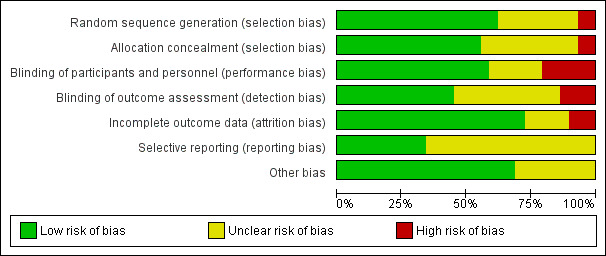
'Risk of bias' graph: review authors' judgements about each risk of bias item presented as percentages across all included studies.
2.

'Risk of bias' summary: review authors' judgements about each risk of bias item for each included study.
Allocation
Sixteen studies were judged to have used adequate methods to generate their random sequence and to conceal allocation (Casanueva 2005; Chappell 1999; Gulmezoglu 1997; Gungorduk 2014; Kiondo 2014; McCance 2010; Poston 2006; Pressman 2003; Roberts 2010; Rumbold 2006; Spinnato 2007; Steyn 2003; Villar 2009; Xu 2010; Zamani 2013; Zodzika 2013), and therefore judged to be at low risk of selection bias. Two studies (Hans 2010; Kalpdev 2011) used adequate methods for sequence generation but provided insufficient detail about allocation concealment and were judged to be at unclear risk of selection bias. Two studies (Nasrolahi 2006; Ochoa‐Brust 2007) had inadequate methods of both sequence generation and allocation concealment, and were therefore judged to be at high risk of selection bias. The remaining nine studies (Beazley 2005; Borna 2005; Ghomian 2013; Hammar 1987; Hankin 1966; Huria 2010; McEvoy 2014; Rivas 2000; Sikkema 2002) were judged to be at unclear risk of selection bias due to insufficient information reported about their methods.
Blinding
Twelve studies reported adequate methods of blinding and were judged to be at low risk of performance bias and detection bias (Chappell 1999; Gulmezoglu 1997; Kiondo 2014; McCance 2010; McEvoy 2014; Poston 2006; Pressman 2003; Roberts 2010; Rumbold 2006; Spinnato 2007; Villar 2009; Xu 2010). Six studies (Beazley 2005; Ghomian 2013; Hankin 1966; Huria 2010; Rivas 2000; Sikkema 2002) were judged to be at unclear risk of performance and detection bias, as insufficient details were provided. Three studies (Gungorduk 2014; Hans 2010; Zodzika 2013) reported inadequate methods of blinding of participants, caregivers and outcome assessors and were judged to be at high risk of both performance and detection bias. Five studies (Hans 2010; Kalpdev 2011; Nasrolahi 2006; Ochoa‐Brust 2007; Zodzika 2013) used no placebo control and one study (Gungorduk 2014) used a non‐identical placebo control, which led to a lack of blinding; all were judged to be at high risk of performance bias. Four studies (Gungorduk 2014; Hammar 1987; Hans 2010; Zodzika 2013) were judged to be at high risk of detection bias, and for 12 studies (Beazley 2005; Borna 2005; Casanueva 2005; Ghomian 2013; Hankin 1966; Huria 2010; Kalpdev 2011; Nasrolahi 2006; Rivas 2000; Sikkema 2002; Steyn 2003; Zamani 2013), the risk of detection bias was unclear due to lack of information about blinding of outcome assessment.
Incomplete outcome data
Twenty‐four studies reported information on attrition and exclusion of participants. Twenty‐one studies (Beazley 2005; Casanueva 2005; Chappell 1999; Ghomian 2013; Gulmezoglu 1997; Gungorduk 2014; Kalpdev 2011; Kiondo 2014; McCance 2010; McEvoy 2014; Nasrolahi 2006; Poston 2006; Pressman 2003; Roberts 2010; Rumbold 2006; Spinnato 2007; Steyn 2003; Villar 2009; Xu 2010; Zamani 2013; Zodzika 2013) were judged to be at low risk of attrition bias. Three studies (Hans 2010; Huria 2010; Ochoa‐Brust 2007) were judged to be at high risk of attrition bias. Five studies (Borna 2005; Hammar 1987; Hankin 1966; Rivas 2000; Sikkema 2002) were classified as having an unclear of risk of bias as insufficient information was provided.
Selective reporting
Ten studies (Gungorduk 2014; Kiondo 2014; McCance 2010; McEvoy 2014; Poston 2006; Roberts 2010; Rumbold 2006; Spinnato 2007; Villar 2009; Xu 2010) were judged to be at low risk of reporting bias as trial protocols were available and all expected outcomes were reported. Nineteen studies (Beazley 2005; Borna 2005; Casanueva 2005; Chappell 1999; Ghomian 2013; Gulmezoglu 1997; Hammar 1987; Hankin 1966; Hans 2010; Huria 2010; Kalpdev 2011; Nasrolahi 2006; Ochoa‐Brust 2007; Pressman 2003; Rivas 2000; Sikkema 2002; Steyn 2003; Zamani 2013; Zodzika 2013) were judged to be at unclear risk as they did not provide adequate information to assess selective reporting.
Other potential sources of bias
Twenty studies (Borna 2005; Chappell 1999; Gulmezoglu 1997; Gungorduk 2014; Hankin 1966; Hans 2010; Kalpdev 2011; Kiondo 2014; McCance 2010; McEvoy 2014; Ochoa‐Brust 2007; Poston 2006; Pressman 2003; Roberts 2010; Rumbold 2006; Spinnato 2007;Steyn 2003; Villar 2009; Zamani 2013; Zodzika 2013) were judged to be free of risks of bias for other sources of bias. The remaining nine studies (Beazley 2005; Casanueva 2005; Ghomian 2013; Hammar 1987; Huria 2010; Nasrolahi 2006; Rivas 2000; Sikkema 2002; Xu 2010) were judged to have an unclear risk of bias as there was insufficient information reported to confidently assess the risk of other sources of bias. Further details are available in the Characteristics of included studies table.
Effects of interventions
See: Table 1
Twenty‐nine trials, involving 24,300 women, are included in this review.
Vitamin C supplementation in pregnancy (all trials)
Primary outcomes
No clear differences were seen between women supplemented with vitamin C, either alone or in combination with other supplements compared with placebo or no control for the risk of stillbirth (risk ratio (RR) 1.15, 95% confidence intervals (CI) 0.89 to 1.49; 20,038 participants; 11 studies; I² = 0%) (Analysis 1.1), neonatal death (RR 0.79, 95% CI 0.58 to 1.08; 19,575 participants; 11 studies; I² = 0%) (Analysis 1.2), or intrauterine growth restriction (RR 0.98, 95% CI 0.91 to 1.06; 20,361 participants; 12 studies; I² = 15%) (Analysis 1.4), when using a fixed‐effect model. Substantial heterogeneity was found for perinatal death, preterm birth, preterm and term prelabour rupture of fetal membranes (PROM), and clinical pre‐eclampsia. No clear difference was found between women supplemented with vitamin C alone or in combination with other supplements compared with placebo or no control for the risk of perinatal death (average RR 1.07, 95% CI 0.77 to 1.49; 17,271 participants; seven studies; I² = 35%) (Analysis 1.3), preterm birth (average RR 0.99, 95% CI 0.90 to 1.10; 22,250 participants; 16 studies; I² = 49%) (Analysis 1.5), preterm PROM (average RR 0.98, 95% CI 0.70 to 1.36; 16,825 participants; 10 studies; I² = 70%) (Analysis 1.6), term PROM (average RR 1.23, 95% CI 0.61 to 2.47; 3230 participants; three studies; I² = 86%) (Analysis 1.7), or clinical pre‐eclampsia (average RR 0.92, 95% CI 0.80 to 1.05; 21,956 participants; 16 studies; I² = 41%) (Analysis 1.8), when using a random‐effects model.
1.1. Analysis.
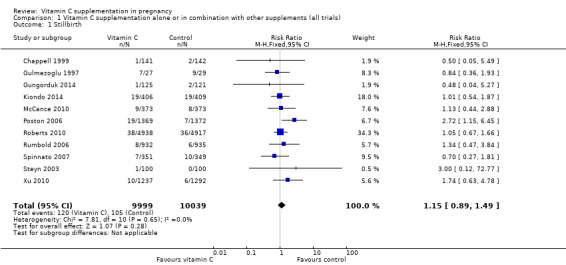
Comparison 1 Vitamin C supplementation alone or in combination with other supplements (all trials), Outcome 1 Stillbirth.
1.2. Analysis.
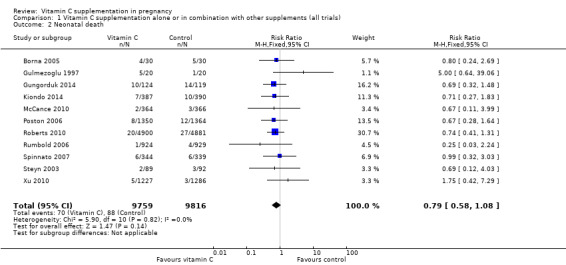
Comparison 1 Vitamin C supplementation alone or in combination with other supplements (all trials), Outcome 2 Neonatal death.
1.4. Analysis.
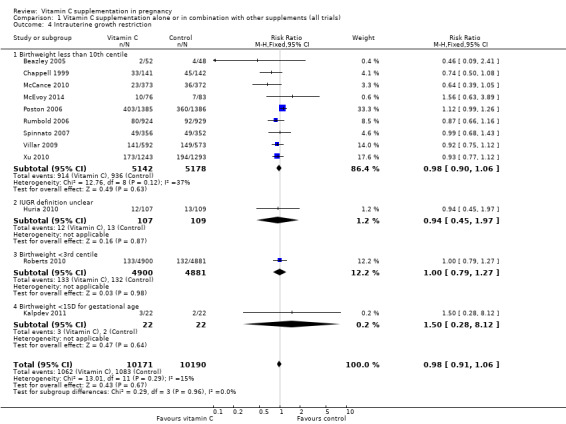
Comparison 1 Vitamin C supplementation alone or in combination with other supplements (all trials), Outcome 4 Intrauterine growth restriction.
1.3. Analysis.
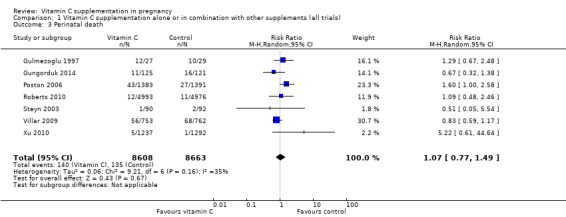
Comparison 1 Vitamin C supplementation alone or in combination with other supplements (all trials), Outcome 3 Perinatal death.
1.5. Analysis.
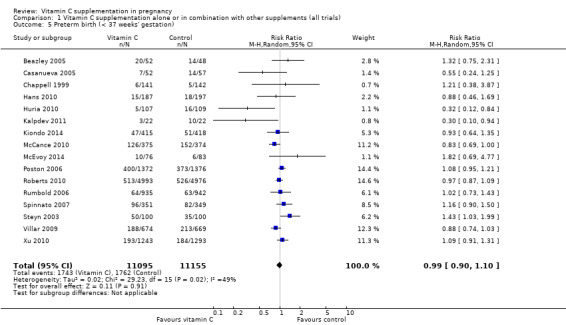
Comparison 1 Vitamin C supplementation alone or in combination with other supplements (all trials), Outcome 5 Preterm birth (< 37 weeks' gestation).
1.6. Analysis.
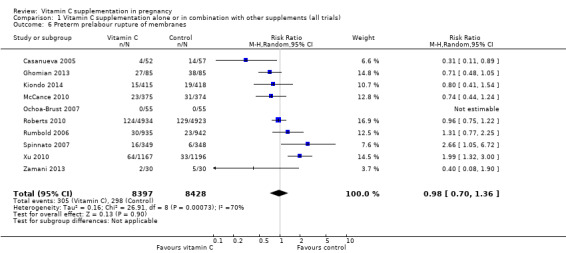
Comparison 1 Vitamin C supplementation alone or in combination with other supplements (all trials), Outcome 6 Preterm prelabour rupture of membranes.
1.7. Analysis.

Comparison 1 Vitamin C supplementation alone or in combination with other supplements (all trials), Outcome 7 Term prelabour rupture of membranes.
1.8. Analysis.
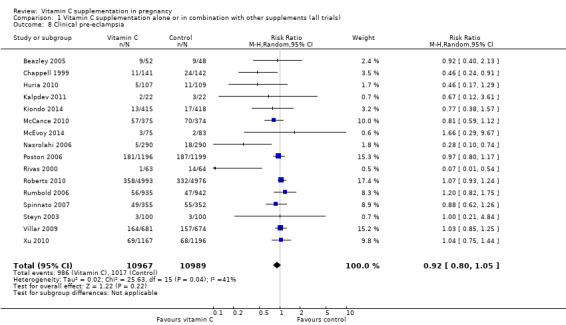
Comparison 1 Vitamin C supplementation alone or in combination with other supplements (all trials), Outcome 8 Clinical pre‐eclampsia.
Secondary outcomes
Women supplemented with vitamin C, either alone or in combination with other supplements compared with placebo or no control had a reduced risk of placental abruption (RR 0.64, 95% CI 0.44 to 0.92; 15,755 participants; eight studies; I² = 0%) (Analysis 1.10). There were no other clear differences between women supplemented with vitamin C, either alone or in combination with other supplements compared with placebo or no control for any other maternal secondary outcomes including maternal death (RR 0.60, 95% CI 0.14 to 2.51; 17,120 participants; seven studies; I² = 0%) (Analysis 1.9), antepartum haemorrhage (RR 1.17, 95% CI 0.83 to 1.67; 13,089 participants; three studies; I² = 0%) (Analysis 1.10), eclampsia (RR 1.42, 95% CI 0.72 to 2.78; 20,304 participants; nine studies; I² = 0%), renal insufficiency or failure (RR 1.49, 95% CI 0.55 to 4.02; 1933 participants; two studies; I² = 0%), disseminated intravascular coagulation (RR 0.36, 95% CI 0.02 to 8.41; 56 participants; one study; I² = 0%), pulmonary oedema (RR 0.40, 95% CI 0.16 to 1.03; 12,569 participants; four studies; I² = 0%) (Analysis 1.11), induction of labour (RR 1.12, 95% CI 0.98 to 1.27; 2077 participants; two studies; I² = 0%), caesarean section (RR 1.02, 95% CI 0.97 to 1.07; 16,459 participants; nine studies; I² = 0%), or prelabour caesarean section (RR 1.15, 95% CI 0.85 to 1.56; 1932 participants; two studies; I² = 3%) (Analysis 1.12).
1.10. Analysis.
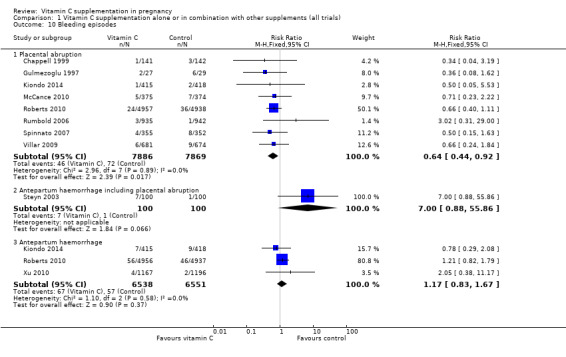
Comparison 1 Vitamin C supplementation alone or in combination with other supplements (all trials), Outcome 10 Bleeding episodes.
1.9. Analysis.
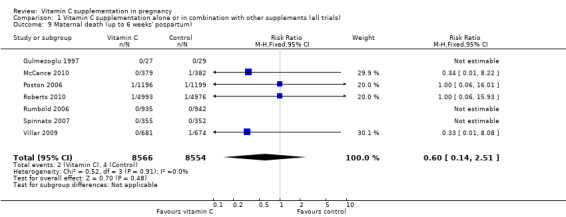
Comparison 1 Vitamin C supplementation alone or in combination with other supplements (all trials), Outcome 9 Maternal death (up to 6 weeks' pospartum).
1.11. Analysis.
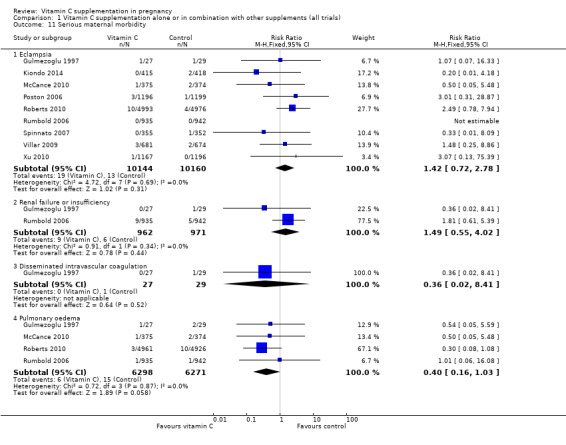
Comparison 1 Vitamin C supplementation alone or in combination with other supplements (all trials), Outcome 11 Serious maternal morbidity.
1.12. Analysis.
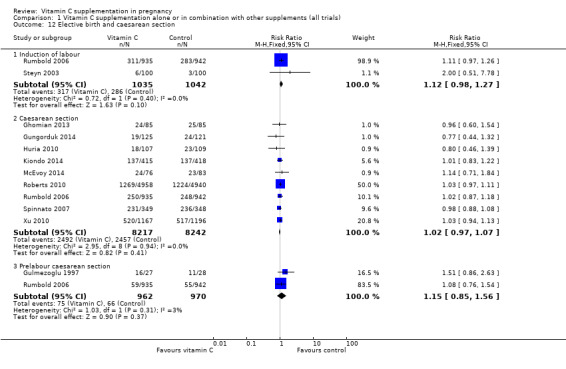
Comparison 1 Vitamin C supplementation alone or in combination with other supplements (all trials), Outcome 12 Elective birth and caesarean section.
Vitamin C supplementation was associated with small increase in gestational age at birth (MD 0.31, 95% CI 0.01 to 0.61; 14,062 participants; nine studies; I² = 65%) (Analysis 1.17). There were no other clear differences in infant outcomes between women supplemented with vitamin C either alone or in combination with other supplements compared with placebo or no control, including infant death (RR 3.02, 95% CI 0.12 to 74.12; 2694 participants; one study, I² = 0%) ((Analysis 1.16), congenital malformations (RR 1.16, 95% CI 0.83 to 1.63; 5511 participants; four studies; I² = 5%) (Analysis 1.19), Apgar score less than seven at five minutes (RR 0.73, 95% CI 0.42 to 1.27; 3531 participants; three studies; I² = 0%) (Analysis 1.20), jaundice requiring phototherapy (RR 0.78, 95% CI 0.59 to 1.04; 725 participants; one study) (Analysis 1.21), respiratory distress syndrome (RR 0.98, 95% CI 0.89 to 1.08; 18,574 participants; eight studies; I² = 19%) (Analysis 1.22), chronic lung disease (RR 0.30, 95% CI 0.08 to 1.09; 2579 participants; two studies; I² = 0%) (Analysis 1.23), periventricular haemorrhage (RR 0.91, 95% CI 0.58 to 1.42; 17,787 participants; six studies; I² = 0%) (Analysis 1.24), periventricular leukomalacia (RR 1.03, 95% CI 0.15 to 7.21; 5049 participants; three studies; I² = 0%) Analysis 1.25), bacterial sepsis (RR 1.10, 95% CI 0.73 to 1.67; 13,324 participants; five studies; I² = 40%) (Analysis 1.26), necrotising enterocolitis (RR 0.74, 95% CI 0.36 to 1.55; 18,514 participants; seven studies; I² = 45%) (Analysis 1.27), retinopathy of prematurity (RR 1.18, 95% CI 0.72 to 1.93; 18,270 participants; six studies; I² = 0%) (Analysis 1.28), or bronchopulmonary dysplasia (RR 8.87, 95% CI 0.48 to 164.11; 683 participants; one study) (Analysis 1.29).
1.17. Analysis.
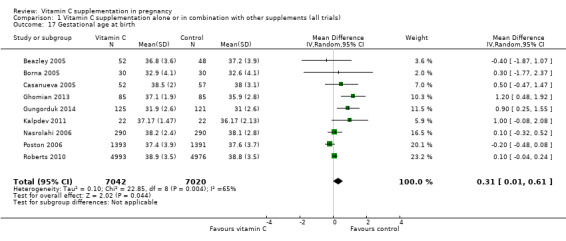
Comparison 1 Vitamin C supplementation alone or in combination with other supplements (all trials), Outcome 17 Gestational age at birth.
1.16. Analysis.

Comparison 1 Vitamin C supplementation alone or in combination with other supplements (all trials), Outcome 16 Infant death.
1.19. Analysis.

Comparison 1 Vitamin C supplementation alone or in combination with other supplements (all trials), Outcome 19 Congenital malformations.
1.20. Analysis.

Comparison 1 Vitamin C supplementation alone or in combination with other supplements (all trials), Outcome 20 Apgar score < 7 at 5 minutes.
1.21. Analysis.

Comparison 1 Vitamin C supplementation alone or in combination with other supplements (all trials), Outcome 21 Jaundice requiring phototherapy.
1.22. Analysis.
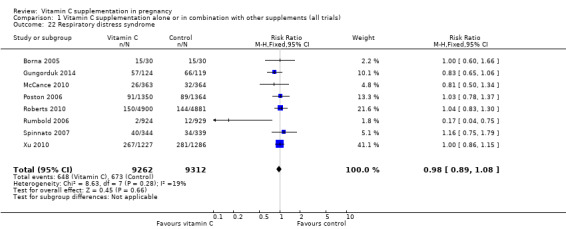
Comparison 1 Vitamin C supplementation alone or in combination with other supplements (all trials), Outcome 22 Respiratory distress syndrome.
1.23. Analysis.

Comparison 1 Vitamin C supplementation alone or in combination with other supplements (all trials), Outcome 23 Chronic lung disease.
1.24. Analysis.
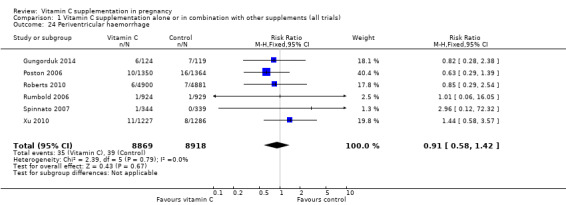
Comparison 1 Vitamin C supplementation alone or in combination with other supplements (all trials), Outcome 24 Periventricular haemorrhage.
1.25. Analysis.

Comparison 1 Vitamin C supplementation alone or in combination with other supplements (all trials), Outcome 25 Periventricular leukomalacia.
1.26. Analysis.
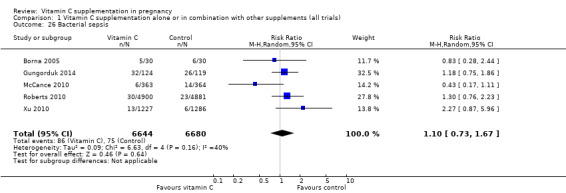
Comparison 1 Vitamin C supplementation alone or in combination with other supplements (all trials), Outcome 26 Bacterial sepsis.
1.27. Analysis.
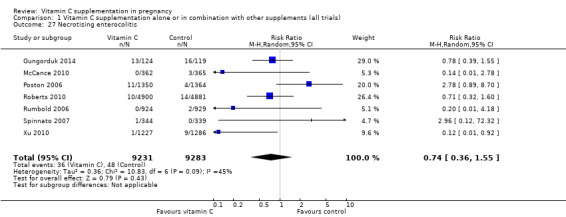
Comparison 1 Vitamin C supplementation alone or in combination with other supplements (all trials), Outcome 27 Necrotising enterocolitis.
1.28. Analysis.
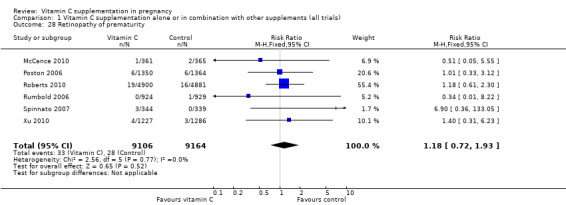
Comparison 1 Vitamin C supplementation alone or in combination with other supplements (all trials), Outcome 28 Retinopathy of prematurity.
1.29. Analysis.

Comparison 1 Vitamin C supplementation alone or in combination with other supplements (all trials), Outcome 29 Bronchopulmonary dysplasia.
Significant heterogeneity was detected for birthweight, however there was no clear difference between the vitamin supplemented and control groups in mean birthweight when using a random‐effects model (mean difference (MD) 26.88, 95% CI ‐18.81 to 72.58; 17,326 participants; 13 studies; I² = 69%) (Analysis 1.18).
1.18. Analysis.
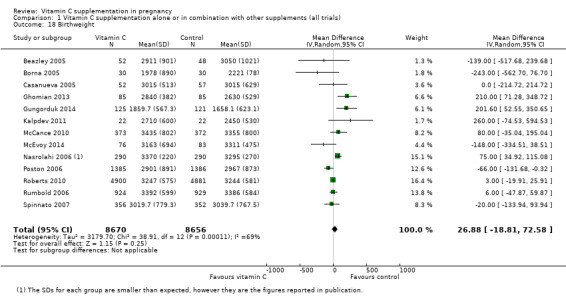
Comparison 1 Vitamin C supplementation alone or in combination with other supplements (all trials), Outcome 18 Birthweight.
None of the studies reported on adverse events that were sufficient to stop supplementation. Possible side effects of supplementation were poorly reported. Three studies (Roberts 2010; Rumbold 2006; Xu 2010), reported on the presence of elevated liver enzymes, and there was overall no clear difference in the risk of this outcome between treatment groups (RR 1.00, 95% CI 0.71 to 1.41; 14,209 participants; three studies; I² = 68%) (Analysis 1.30). An additional study (Poston 2006), reported that there was no difference in liver enzymes between treatment groups however the data could not be included in the meta‐analysis. One study (Rumbold 2006), reported that vitamin C supplementation in combination with other supplements was associated with an increased risk of abdominal pain (RR 1.66, 95% CI 1.16 to 2.37; 1877 participants) (Analysis 1.30). There were no other clear differences between women supplemented with vitamin C alone or in combination with other supplements compared with placebo or no control for any other potential side effects including acne (RR 3.21, 95% CI 0.14 to 75.68; 56 participants, one study) , transient weakness (RR 5.36, 95% CI 0.27 to 106.78; 56 participants, one study), skin rash (RR 3.21, 95% CI 0.14 to 75.68; 56 participants, one study), pyrosis (heartburn) and nausea (RR 7.00, 95% CI 0.37 to 132.40; 110 participants; one study) or "any side effects" (RR 1.16, 95% CI 0.39 to 3.41; 707 participants; one study) (Analysis 1.30). Furthemore, one study (McCance 2010) stated in the text that there were "no adverse events or side effects attributable to supplementation with vitamin C".
1.30. Analysis.
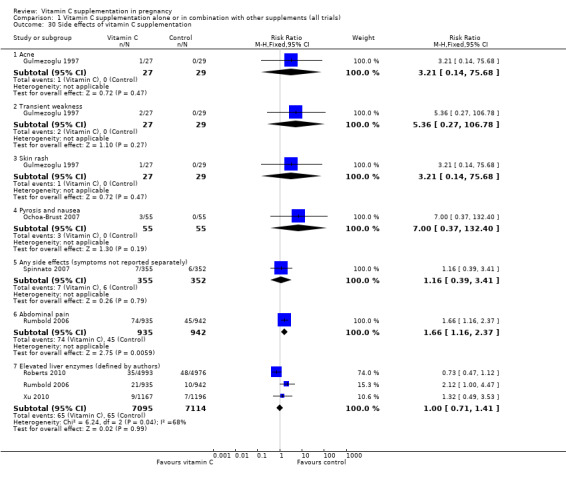
Comparison 1 Vitamin C supplementation alone or in combination with other supplements (all trials), Outcome 30 Side effects of vitamin C supplementation.
There was no clear difference between women supplemented with vitamin C alone or in combination with other supplements for any of the outcomes related to use of health service resources, including: antenatal hospitalisation (RR 0.87, 95% CI 0.68 to 1.11; 2791 participants; three studies; I² = 73%), maternal admission to the intensive care unit (RR 0.60, 95% CI 0.16 to 2.30; 3718 participants; two studies; I² = 45% (Analysis 1.31), admission to the neonatal intensive care unit (RR 1.02, 95% CI 0.96 to 1.09; 18,371 participants; nine studies; I² = 14%) and use of mechanical ventilation (RR 1.02, 95% CI 0.84 to 1.25; 8531 participants; six studies; I² = 37%) (Analysis 1.32).
1.31. Analysis.
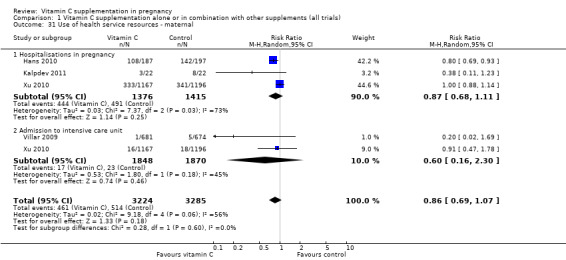
Comparison 1 Vitamin C supplementation alone or in combination with other supplements (all trials), Outcome 31 Use of health service resources ‐ maternal.
1.32. Analysis.
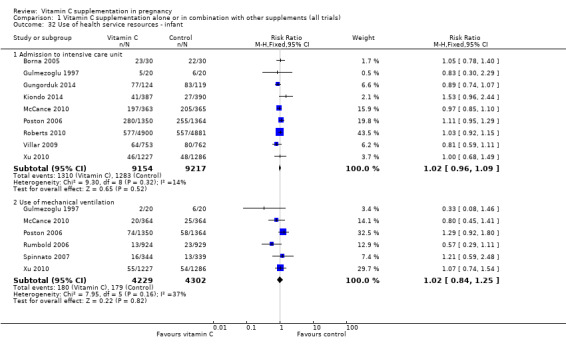
Comparison 1 Vitamin C supplementation alone or in combination with other supplements (all trials), Outcome 32 Use of health service resources ‐ infant.
Sensitivity analyses by trial quality
Assessments of the treatment effects were made for the primary outcomes based on trial quality. Eleven studies were judged to have a low overall risk of bias (Chappell 1999; Gulmezoglu 1997; Kiondo 2014; McCance 2010; Poston 2006; Pressman 2003; Roberts 2010; Rumbold 2006; Spinnato 2007; Villar 2009; Xu 2010), for 10 studies, the overall risk was unclear (Beazley 2005; Borna 2005; Casanueva 2005; Ghomian 2013; Hankin 1966; McEvoy 2014; Rivas 2000; Steyn 2003; Zamani 2013), and eight studies had a high overall risk of bias (Gungorduk 2014; Hammar 1987; Hans 2010; Huria 2010; Kalpdev 2011; Nasrolahi 2006; Ochoa‐Brust 2007; Zodzika 2013). When the analyses were restricted to studies at low overall risk of bias, the risks of stillbirth, neonatal death, perinatal death, intrauterine growth restriction, preterm birth, preterm PROM and clinical pre‐eclampsia did not change substantively to the analyses which included all studies (Analysis 2.1; Analysis 2.2; Analysis 2.3; Analysis 2.4; Analysis 2.5; Analysis 2.6; Analysis 2.8). However, there was an increased risk of term PROM in women supplemented vitamin C in combination with other supplements compared with placebo (RR 1.73, 95% CI 1.34 to 2.23; 3060 participants; two studies; I² = 0% Analysis 2.7).
2.1. Analysis.
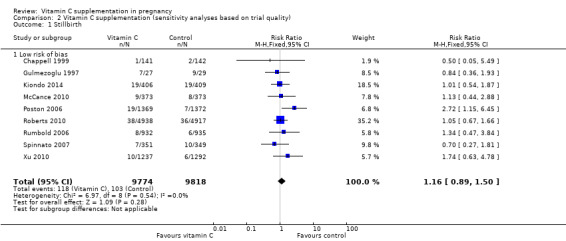
Comparison 2 Vitamin C supplementation (sensitivity analyses based on trial quality), Outcome 1 Stillbirth.
2.2. Analysis.
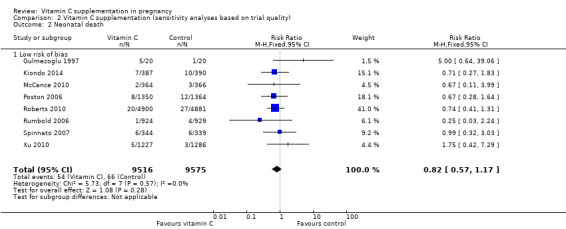
Comparison 2 Vitamin C supplementation (sensitivity analyses based on trial quality), Outcome 2 Neonatal death.
2.3. Analysis.
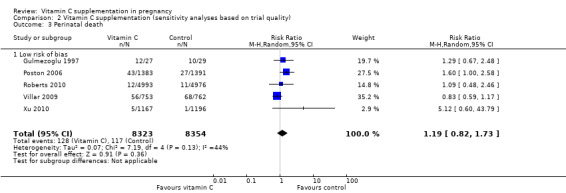
Comparison 2 Vitamin C supplementation (sensitivity analyses based on trial quality), Outcome 3 Perinatal death.
2.4. Analysis.
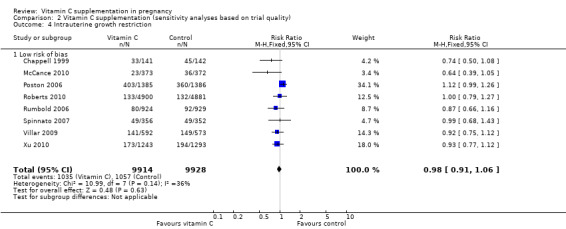
Comparison 2 Vitamin C supplementation (sensitivity analyses based on trial quality), Outcome 4 Intrauterine growth restriction.
2.5. Analysis.
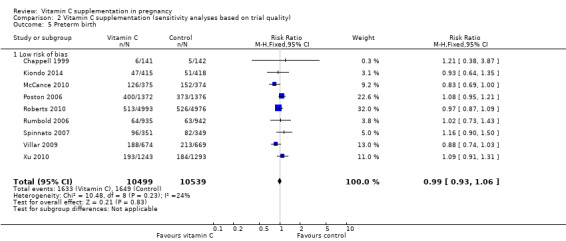
Comparison 2 Vitamin C supplementation (sensitivity analyses based on trial quality), Outcome 5 Preterm birth.
2.6. Analysis.
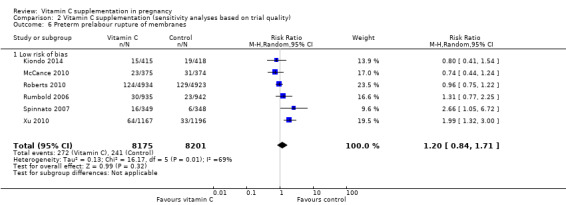
Comparison 2 Vitamin C supplementation (sensitivity analyses based on trial quality), Outcome 6 Preterm prelabour rupture of membranes.
2.8. Analysis.
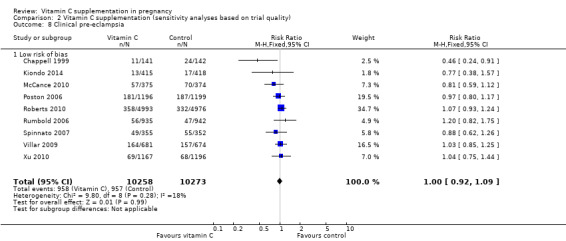
Comparison 2 Vitamin C supplementation (sensitivity analyses based on trial quality), Outcome 8 Clinical pre‐eclampsia.
2.7. Analysis.

Comparison 2 Vitamin C supplementation (sensitivity analyses based on trial quality), Outcome 7 Term prelabour of rupture of membranes.
Restricting the analyses to studies at low risk of bias reduced the heterogeneity substantially for the outcomes preterm birth (from 48% to 24%), term PROM (from 70% to 0%), and clinical pre‐eclampsia (from 41% to 18%). This suggests that variation in quality explains some of the heterogeneity detected for preterm birth and clinical pre‐eclampsia, and accounts for all of the heterogeneity detected for term PROM.
Subgroup analyses
Dosage of the vitamin C supplement (above or equal to/below the recommended daily intake (RDI) of 60 mg)
All of the included studies supplemented women with vitamin C in dosages above the recommended daily intake, therefore subgroup analyses based on dosage were not performed. Fifteen studies supplemented women with an oral daily dosage of 1000 mg (Beazley 2005; Chappell 1999; Gulmezoglu 1997; Gungorduk 2014; Huria 2010; Kalpdev 2011; Kiondo 2014; McCance 2010; Nasrolahi 2006; Poston 2006; Roberts 2010; Rumbold 2006; Spinnato 2007; Villar 2009; Xu 2010). Six studies supplemented women with a daily dosage of 500 mg (Borna 2005; McEvoy 2014; Pressman 2003; Rivas 2000; Steyn 2003; Zodzika 2013), a further four studies used a daily dosage of 100 mg (Casanueva 2005; Ghomian 2013; Hankin 1966; Ochoa‐Brust 2007), and three studies used a daily dosage of either 2000 mg (Hammar 1987; Sikkema 2002) or 400 mg (Hans 2010). The remaining study (Zodzika 2013), gave women 250g per day for six days and thereafter 250 g per week, and the vitamin C was administered vaginally.
Gestation at trial entry (trial entry less than 20 weeks or greater than or equal to 20 weeks)
Assessments of the treatment effects were made for the primary outcomes based on gestation at entry. Nine studies enrolled women prior to 20 weeks' gestation (Ghomian 2013; Hans 2010; Huria 2010; Kalpdev 2011; Roberts 2010; Spinnato 2007; Xu 2010; Zamani 2013; Zodzika 2013), six studies enrolled women after 20 weeks' gestation (Borna 2005; Casanueva 2005; Gulmezoglu 1997; Gungorduk 2014; Hammar 1987; Pressman 2003), and 12 studies enrolled women both before and after 20 weeks' gestation (Beazley 2005; Chappell 1999; Hankin 1966; Kiondo 2014; McCance 2010; McEvoy 2014; Ochoa‐Brust 2007; Poston 2006; Rivas 2000; Rumbold 2006; Steyn 2003; Villar 2009). For two studies (Nasrolahi 2006; Sikkema 2002), the gestation at enrolment of participating women was unclear.
There were no clear differences in the risk of stillbirth, neonatal death, perinatal death, intrauterine growth restriction, preterm birth or term PROM between women supplemented with vitamin C in combination with other supplements compared with placebo or no control, in any of the subgroups based on gestation at trial entry (Analysis 3.1; Analysis 3.2; Analysis 3.3; Analysis 3.4; Analysis 3.5; Analysis 3.7; Analysis 3.8). Women supplemented with vitamin C had a reduced risk of preterm PROM in the study that enrolled women exclusively after 20 weeks' gestation (RR 0.31, 95% CI 0.11 to 0.89; 109 participants; one study; I² = 0% ); however, no clear difference was found in the studies that enrolled women prior to 20 weeks' gestation (RR 1.16, 95% CI 0.71 to 1.89; 13,147 participants; five studies; I² = 79% ), or for studies enrolling women both before and after 20 weeks' gestation (RR 0.93, 95% CI 0.64 to 1.34; 3569 participants; four studies; I² = 22% ). Furthermore, the test of subgroup differences was not significant for this outcome (Analysis 3.6).
3.1. Analysis.
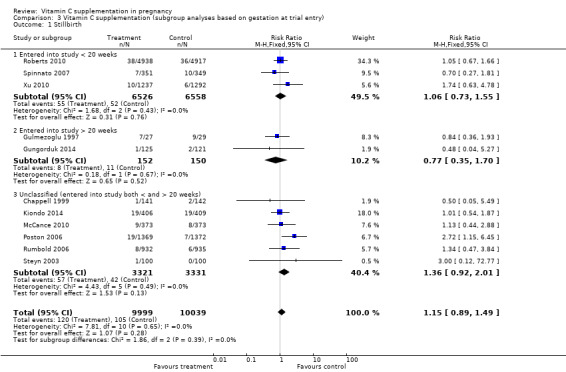
Comparison 3 Vitamin C supplementation (subgroup analyses based on gestation at trial entry), Outcome 1 Stillbirth.
3.2. Analysis.
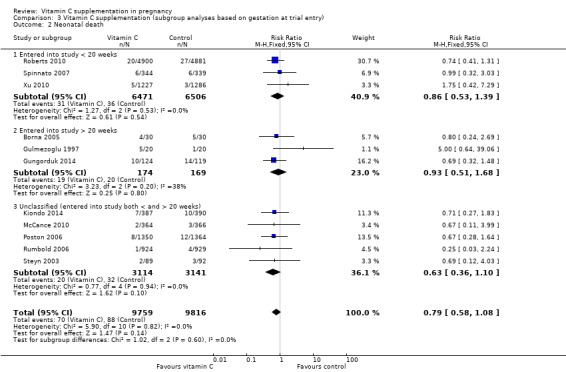
Comparison 3 Vitamin C supplementation (subgroup analyses based on gestation at trial entry), Outcome 2 Neonatal death.
3.3. Analysis.
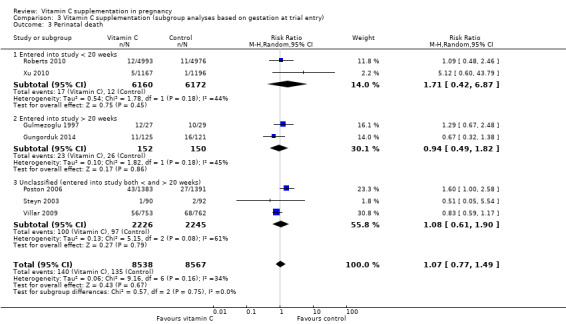
Comparison 3 Vitamin C supplementation (subgroup analyses based on gestation at trial entry), Outcome 3 Perinatal death.
3.4. Analysis.
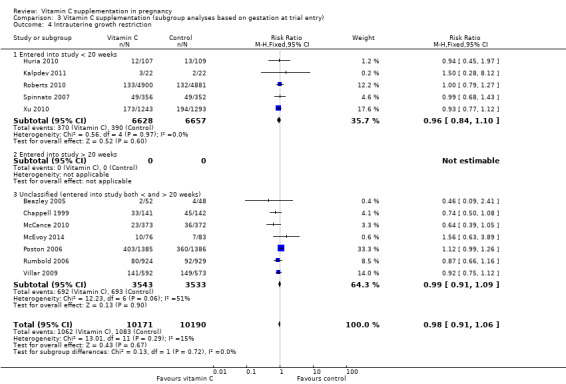
Comparison 3 Vitamin C supplementation (subgroup analyses based on gestation at trial entry), Outcome 4 Intrauterine growth restriction.
3.5. Analysis.
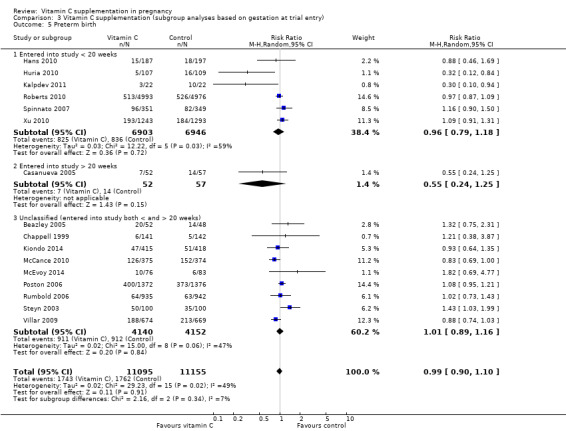
Comparison 3 Vitamin C supplementation (subgroup analyses based on gestation at trial entry), Outcome 5 Preterm birth.
3.7. Analysis.
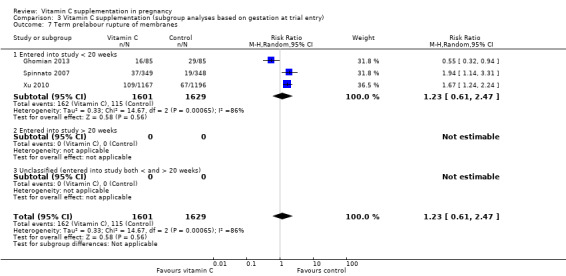
Comparison 3 Vitamin C supplementation (subgroup analyses based on gestation at trial entry), Outcome 7 Term prelabour rupture of membranes.
3.8. Analysis.
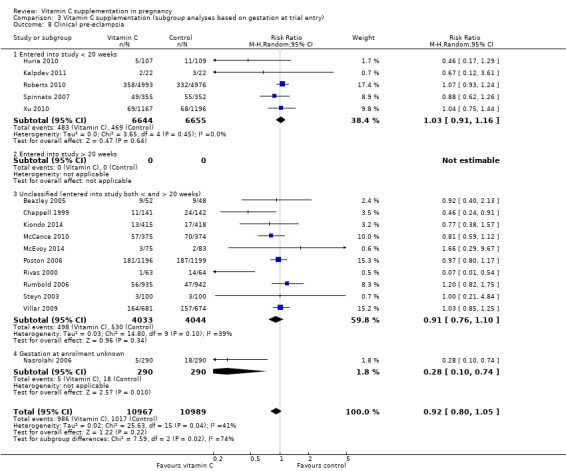
Comparison 3 Vitamin C supplementation (subgroup analyses based on gestation at trial entry), Outcome 8 Clinical pre‐eclampsia.
3.6. Analysis.
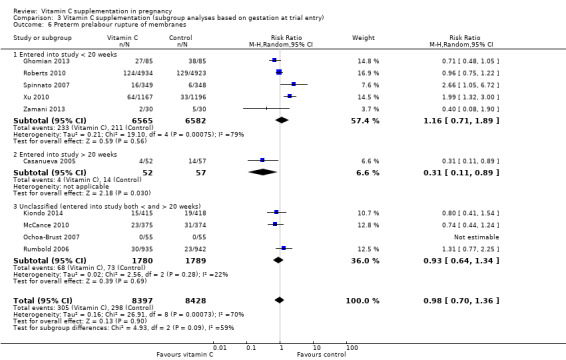
Comparison 3 Vitamin C supplementation (subgroup analyses based on gestation at trial entry), Outcome 6 Preterm prelabour rupture of membranes.
For the outcome pre‐eclampsia, there was no clear difference in observed effects in any of the studies that enrolled women before 20 weeks' gestation ((RR 1.03, 95% CI 0.91 to 1.16; 13,299 participants; five studies; I² = 0%), or women before and after 20 weeks' gestation (RR 0.91, 95% CI 0.76 to 1.10; 8077 participants; 10 studies; I² = 39% ); however, there was a reduced risk of pre‐eclampsia in the one study where the gestation at enrolment was unclear (RR 0.28, 95% CI 0.10 to 0.74; 580 participants; one study; I² = 0% (Nasrolahi 2006)). Caution should be taken when interpreting this effect, as it is based on one study judged to be at high risk of bias. None of the studies that reported the outcome pre‐eclampsia enrolled women exclusively after 20 weeks' gestation (Analysis 3.8).
Women's dietary vitamin C intake prior to trial entry (low intake defined as less than the RDI in that setting as measured by dietary questionnaire or plasma vitamin C less than 11 umol/L at trial entry)
Three studies (Casanueva 2005; Roberts 2010; Rumbold 2006) reported on dietary vitamin C intake of participants at trial entry, and in all studies the mean or median intake was above the RDI. One study (Steyn 2003), reported that 11 participants (5.5%) had a dietary vitamin C deficiency at trial entry. Three studies (Chappell 1999; McCance 2010; Poston 2006) assessed plasma concentrations of vitamin C at baseline. In two of these studies (Chappell 1999; Poston 2006), the reported mean concentrations were consistent with dietary intakes of vitamin C at or above the RDI. In the study by McCance 2010, 70% (n = 453) of participants had a baseline concentration above 30 µmol/L, suggesting an average intake at or above the RDI. Therefore, these seven trials were classified as including participants with "adequate" vitamin C intake at trial entry. Two studies (Kiondo 2014; Villar 2009) did not assess vitamin C intake among participants, however, stated that participants were drawn from populations with poor nutritional status, including low vitamin C intake, based on their own previous research. A further study (Hans 2010), stated that participants were drawn from a population at high risk of iron‐deficiency anaemia. These three studies were classified as having participants with "low nutritional status". For the remaining 19 studies, dietary intake of vitamin C at baseline was either not assessed or not reported and for the purpose of the subgroup analyses, they were classified as "dietary intake unclear".
There were no clear differences in the risk of stillbirth, neonatal death, perinatal death, intrauterine growth restriction, preterm birth preterm PROM or term PROM between women supplemented with vitamin C in combination with other supplements compared with placebo or no control, in any of the subgroups based on dietary intake of vitamin C at trial entry (Analysis 4.1; Analysis 4.2; Analysis 4.3; Analysis 4.4; Analysis 4.5; Analysis 4.6; Analysis 4.7).
4.1. Analysis.
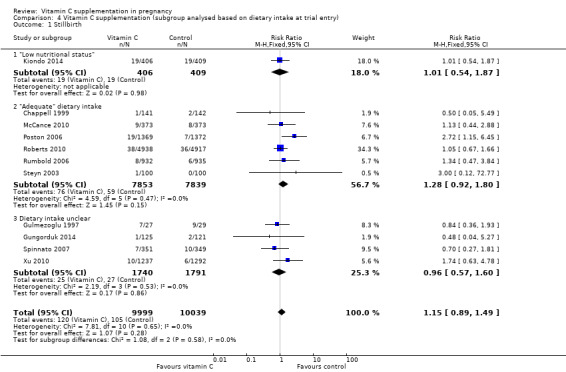
Comparison 4 Vitamin C supplementation (subgroup analysed based on dietary intake at trial entry), Outcome 1 Stillbirth.
4.2. Analysis.
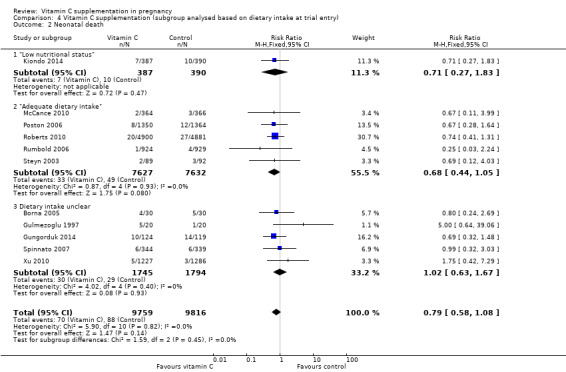
Comparison 4 Vitamin C supplementation (subgroup analysed based on dietary intake at trial entry), Outcome 2 Neonatal death.
4.3. Analysis.
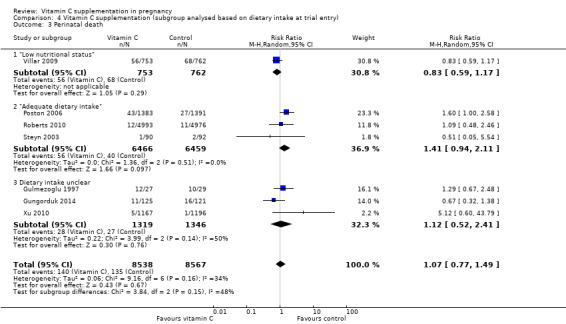
Comparison 4 Vitamin C supplementation (subgroup analysed based on dietary intake at trial entry), Outcome 3 Perinatal death.
4.4. Analysis.
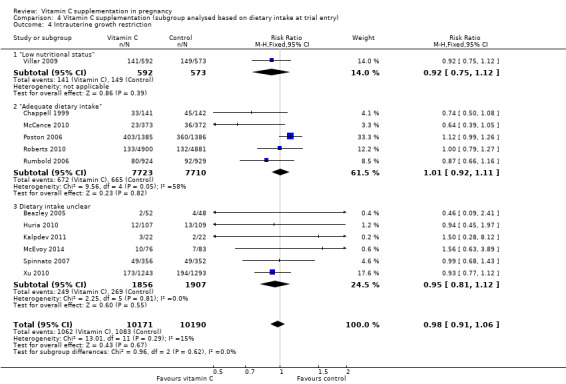
Comparison 4 Vitamin C supplementation (subgroup analysed based on dietary intake at trial entry), Outcome 4 Intrauterine growth restriction.
4.5. Analysis.
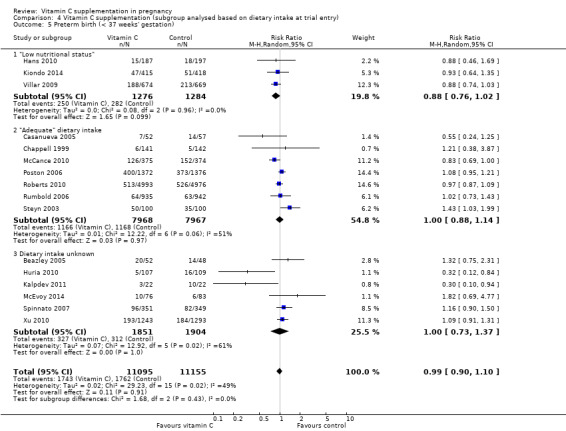
Comparison 4 Vitamin C supplementation (subgroup analysed based on dietary intake at trial entry), Outcome 5 Preterm birth (< 37 weeks' gestation).
4.6. Analysis.
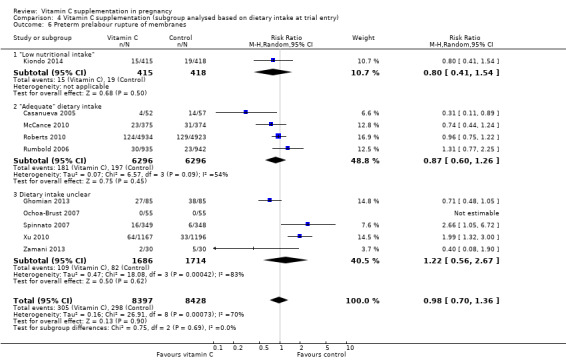
Comparison 4 Vitamin C supplementation (subgroup analysed based on dietary intake at trial entry), Outcome 6 Preterm prelabour rupture of membranes.
4.7. Analysis.
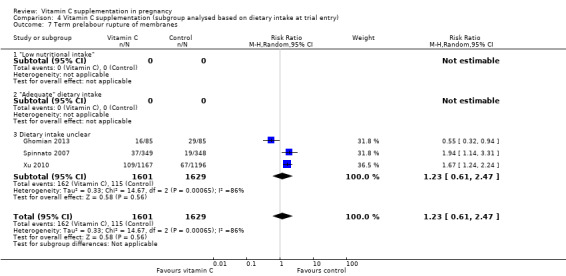
Comparison 4 Vitamin C supplementation (subgroup analysed based on dietary intake at trial entry), Outcome 7 Term prelabour rupture of membranes.
For the outcome pre‐eclampsia, one study (McCance 2010), reported information separately according to three categories of baseline serum vitamin C concentration (< 10 µmol/L, 10‐30 µmol/L, > 30 µmol/L). Among women with a very low serum concentration of vitamin C at trial entry (< 10 µmol/L), there was a reduction in the risk of pre‐eclampsia in the supplemented group which was of borderline statistical significance (RR 0.14, 95% CI 0.02 to 1.05; 28 participants; one study, P = 0.06), however there was no difference in the risk of pre‐eclampsia in the studies that enrolled women from populations with low nutritional status (RR 1.01, 95% CI 0.84 to 1.22; 2188 participants; two studies = 2; I² = 0%). There were no other clear differences in the risk of pre‐eclampsia in any of the other subgroups based on dietary intake or baseline vitamin C status. Furthermore, the test of subgroup differences was not significant for the outcome pre‐eclampsia (Analysis 4.8).
4.8. Analysis.
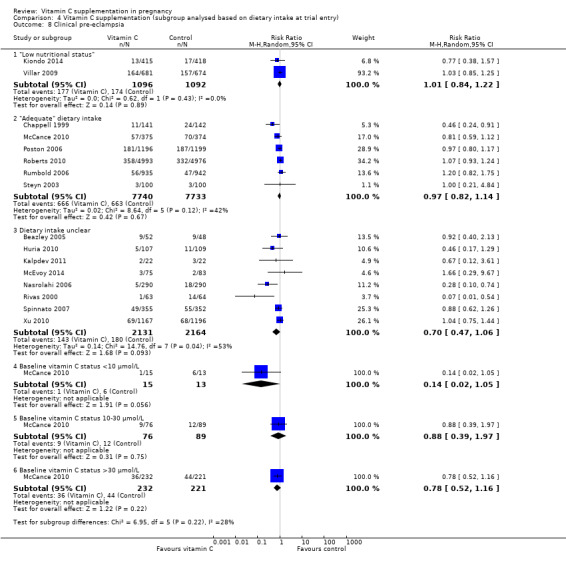
Comparison 4 Vitamin C supplementation (subgroup analysed based on dietary intake at trial entry), Outcome 8 Clinical pre‐eclampsia.
Whether vitamin C supplementation occurred in combination with other dietary supplements
Assessments of the treatment effects were made for the primary outcomes based on whether trials supplemented women with vitamin C alone or in addition to other supplements. Twelve studies (Casanueva 2005; Ghomian 2013; Hammar 1987; Hankin 1966; Hans 2010; Kiondo 2014; McEvoy 2014; Ochoa‐Brust 2007; Sikkema 2002; Steyn 2003; Zamani 2013; Zodzika 2013), supplemented with vitamin C alone, 15 studies (Beazley 2005; Borna 2005; Chappell 1999; Gungorduk 2014; Huria 2010; Kalpdev 2011; McCance 2010; Nasrolahi 2006; Poston 2006; Pressman 2003; Roberts 2010; Rumbold 2006; Spinnato 2007; Villar 2009; Xu 2010), and two studies supplemented (Gulmezoglu 1997; Rivas 2000) women with vitamin C and vitamin E in addition to either allopurinol or aspirin and fish oil.
No clear differences were seen between women supplemented with vitamin C compared with placebo regardless of whether the supplementation occurred alone or with other supplements for stillbirth, neonatal death, perinatal death, intrauterine growth restriction, preterm birth, or clinical pre‐eclampsia (Analysis 5.1; Analysis 5.2; Analysis 5.3; Analysis 5.4; Analysis 5.5; Analysis 5.8). Women were at decreased risk of preterm PROM if they were supplemented with vitamin C alone (RR 0.66, 95% CI 0.48 to 0.91; 1282 participants; five studies; I² = 0%), however no clear difference was seen between treatment groups for preterm PROM when women were supplemented with vitamin C in addition to other supplements (RR 1.28, 95% CI 0.86 to 1.92; 15,543 participants; five studies; I² = 73%) (Analysis 5.6). Furthermore, women were at decreased risk of term PROM if they were supplemented with vitamin C alone (RR 0.55, 95% CI 0.32 to 0.94; 170 participants; one study (Ghomian 2013)), however, there was an increased risk when women were supplemented with vitamin C in combination with other supplements (RR 1.73, 95% CI 1.34 to 2.23; 3060 participants; two studies; I² = 0%) (Analysis 5.7). Furthermore, for both preterm and term PROM, the test assessing differences between subgroups was significant, suggesting that the risk of PROM either preterm or at term, differs according to the type of supplement (Test for subgroup differences: Chi² = 6.47, df = 1 (P = 0.01), I² = 84.5%, Analysis 5.6; Test for subgroup differences: Chi² = 14.37, df = 1 (P = 0.0002), I² = 93.0%, Analysis 5.7).
5.1. Analysis.
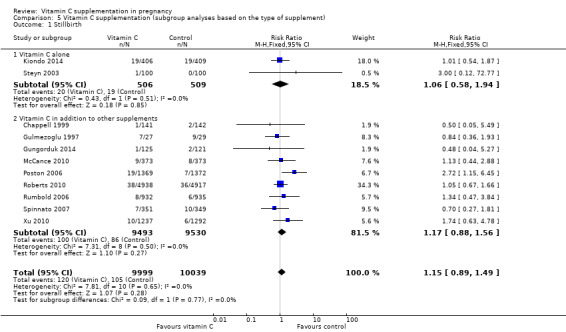
Comparison 5 Vitamin C supplementation (subgroup analyses based on the type of supplement), Outcome 1 Stillbirth.
5.2. Analysis.
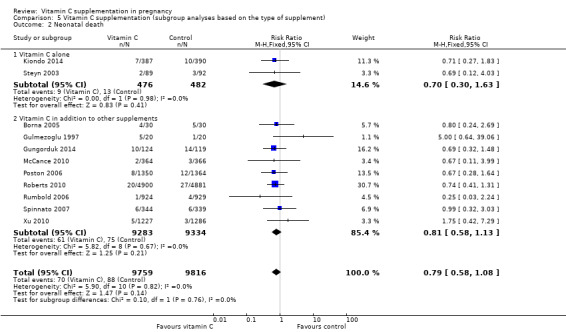
Comparison 5 Vitamin C supplementation (subgroup analyses based on the type of supplement), Outcome 2 Neonatal death.
5.3. Analysis.
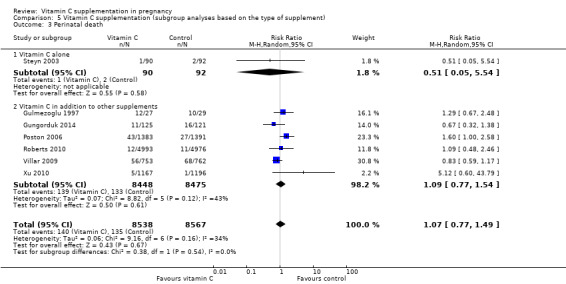
Comparison 5 Vitamin C supplementation (subgroup analyses based on the type of supplement), Outcome 3 Perinatal death.
5.4. Analysis.
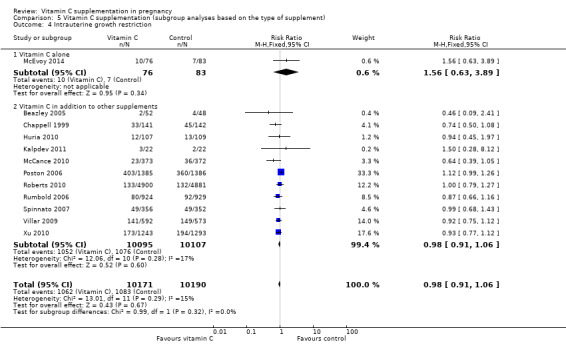
Comparison 5 Vitamin C supplementation (subgroup analyses based on the type of supplement), Outcome 4 Intrauterine growth restriction.
5.5. Analysis.
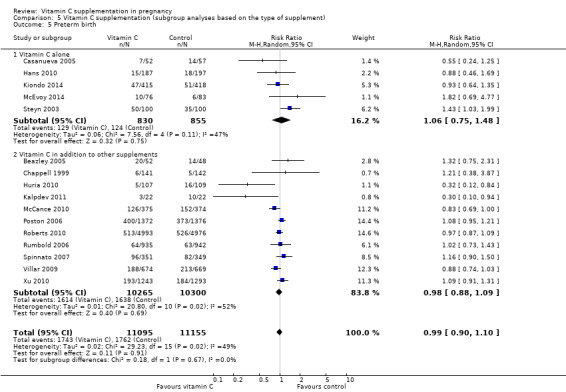
Comparison 5 Vitamin C supplementation (subgroup analyses based on the type of supplement), Outcome 5 Preterm birth.
5.8. Analysis.
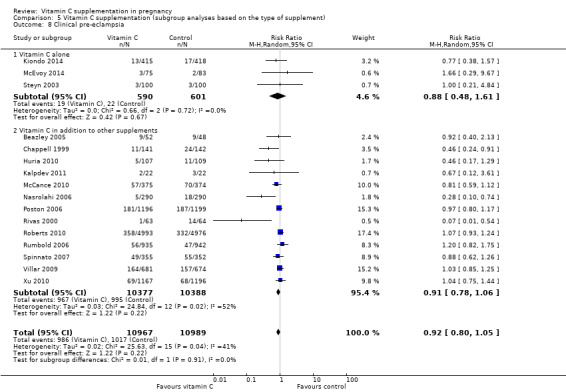
Comparison 5 Vitamin C supplementation (subgroup analyses based on the type of supplement), Outcome 8 Clinical pre‐eclampsia.
5.6. Analysis.
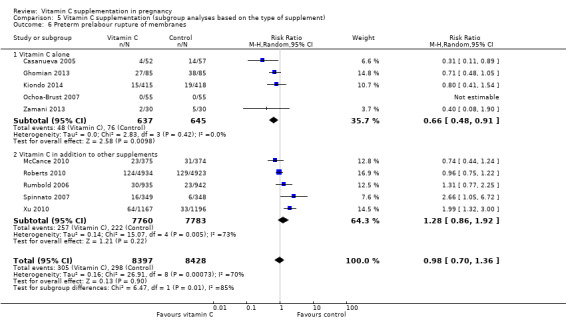
Comparison 5 Vitamin C supplementation (subgroup analyses based on the type of supplement), Outcome 6 Preterm prelabour rupture of membranes.
5.7. Analysis.
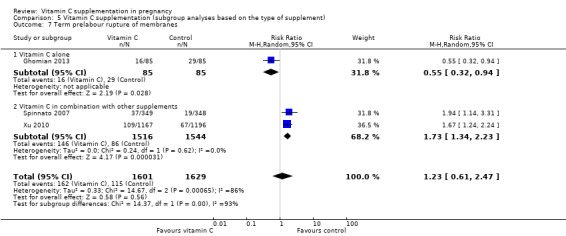
Comparison 5 Vitamin C supplementation (subgroup analyses based on the type of supplement), Outcome 7 Term prelabour rupture of membranes.
Women's risk status for adverse pregnancy outcomes (as defined by the authors)
Nine studies supplemented women who were at increased risk or high risk of pre‐eclampsia (Beazley 2005; Chappell 1999; Kalpdev 2011; McCance 2010; Poston 2006; Rivas 2000; Spinnato 2007; Villar 2009; Xu 2010), two studies supplemented women with established pre‐eclampsia (Gulmezoglu 1997; Sikkema 2002), four studies supplemented women with either established preterm PROM (Borna 2005; Gungorduk 2014), or a history of preterm or term PROM (Ghomian 2013; Zamani 2013), and one study supplemented women with a history of late miscarriage or preterm birth (Steyn 2003). For this subgroup analysis, all 16 of these studies were classified as including women at 'high/increased risk' of adverse pregnancy outcomes.
Four studies supplemented nulliparous or primiparous women (Huria 2010; Nasrolahi 2006; Roberts 2010; Rumbold 2006), three studies supplemented women with no acute or chronic diseases (Casanueva 2005; Kiondo 2014; Ochoa‐Brust 2007), one study supplemented pregnant women with leg cramps (Hammar 1987), one study supplemented women smoking in pregnancy (McEvoy 2014), one study supplemented women with 'abnormal vaginal flora' (Zodzika 2013), and a further study supplemented women who were planning a caesarean section (Pressman 2003). One study included 'pregnant women attending for their first antenatal visits' but provided no further details (Hans 2010). These 12 studies were classified as including women at 'low/moderate risk' of adverse pregnancy outcomes. For one study (Hankin 1966), women's risk of adverse pregnancy outcomes was unclear.
For the outcomes stillbirth, neonatal death, perinatal death, intrauterine growth restriction, preterm birth, preterm PROM, term PROM and clinical pre‐eclampsia, there were no clear differences in the effects of vitamin C supplementation alone or in combination with other supplements versus placebo or no control for women classified as 'high/increased risk' and for those classified as 'low/moderate' risk (Analysis 6.1; Analysis 6.2; Analysis 6.3; Analysis 6.4; Analysis 6.5; Analysis 6.6; Analysis 6.7; Analysis 6.8). Furthermore, the tests for subgroup differences were not significant for any of these outcomes. For the outcomes preterm birth, preterm PROM and pre‐eclampsia, substantial heterogeneity was present in the meta‐analyses of both of the subgroups based on risk, suggesting that heterogeneity between included studies may be due to other factors rather that differences in baseline risk of adverse pregnancy outcomes.
6.1. Analysis.
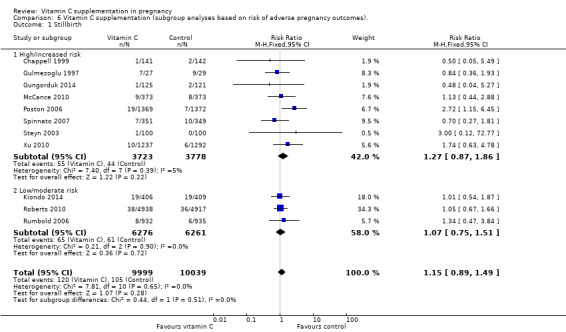
Comparison 6 Vitamin C supplementation (subgroup analyses based on risk of adverse pregnancy outcomes)., Outcome 1 Stillbirth.
6.2. Analysis.
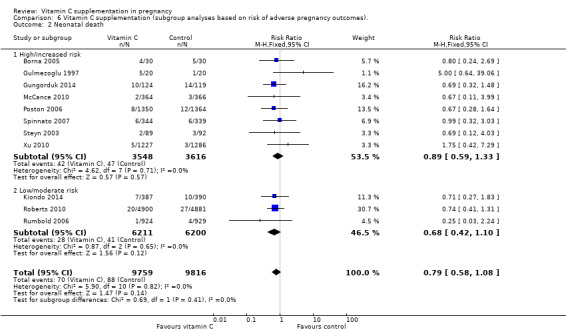
Comparison 6 Vitamin C supplementation (subgroup analyses based on risk of adverse pregnancy outcomes)., Outcome 2 Neonatal death.
6.3. Analysis.
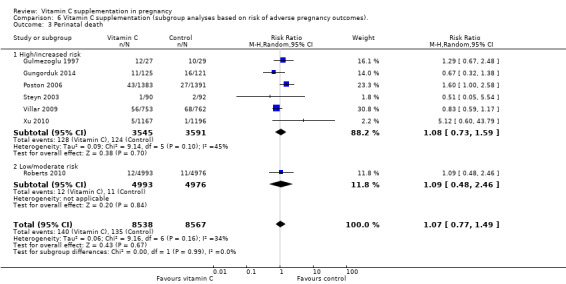
Comparison 6 Vitamin C supplementation (subgroup analyses based on risk of adverse pregnancy outcomes)., Outcome 3 Perinatal death.
6.4. Analysis.
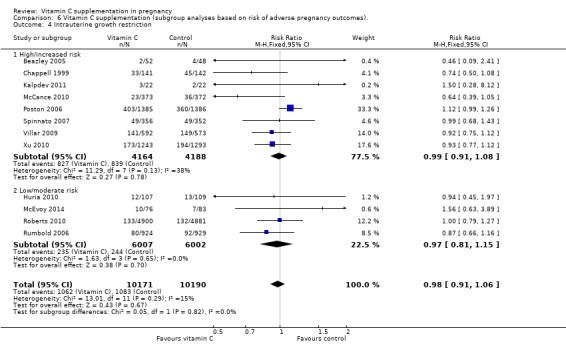
Comparison 6 Vitamin C supplementation (subgroup analyses based on risk of adverse pregnancy outcomes)., Outcome 4 Intrauterine growth restriction.
6.5. Analysis.
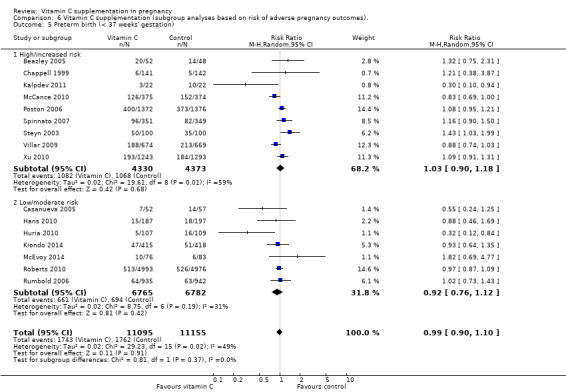
Comparison 6 Vitamin C supplementation (subgroup analyses based on risk of adverse pregnancy outcomes)., Outcome 5 Preterm birth (< 37 weeks' gestation).
6.6. Analysis.
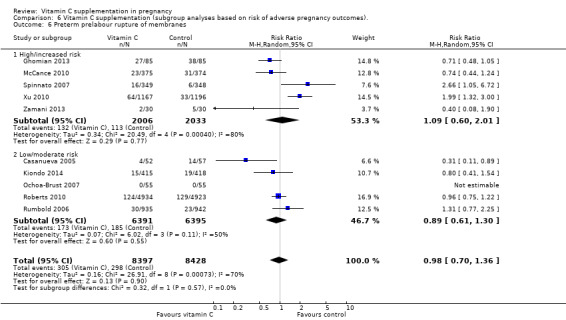
Comparison 6 Vitamin C supplementation (subgroup analyses based on risk of adverse pregnancy outcomes)., Outcome 6 Preterm prelabour rupture of membranes.
6.7. Analysis.
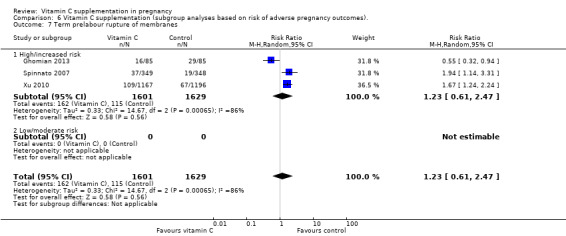
Comparison 6 Vitamin C supplementation (subgroup analyses based on risk of adverse pregnancy outcomes)., Outcome 7 Term prelabour rupture of membranes.
6.8. Analysis.
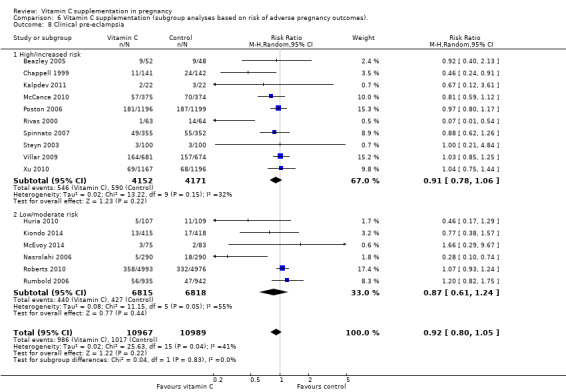
Comparison 6 Vitamin C supplementation (subgroup analyses based on risk of adverse pregnancy outcomes)., Outcome 8 Clinical pre‐eclampsia.
Discussion
Summary of main results
The results of this review, which included over 24,000 women and their babies, do not support routine vitamin C supplementation, either alone or in combination with other supplements. There were no clear differences between women supplemented with any vitamin C compared with placebo or no control for the risk of any primary outcome including stillbirth, neonatal or perinatal death, intrauterine growth restriction, preterm birth, preterm PROM (prelabour rupture of fetal membranes), term PROM or pre‐eclampsia. Supplementation was associated with a reduced risk of placental abruption, which warrants further investigation. There was also a small increase in length of gestation among supplemented women although this finding may have limited clinical relevance as there was no difference in the risk of preterm birth between comparison groups. Women supplemented with vitamin C were more likely to self‐report abdominal pain, however, there were no differences in other reported side effects between comparison groups. There was no convincing evidence that any vitamin C supplementation results in other important benefits or harms.
Overall completeness and applicability of evidence
This review provides reliable information about the impact of vitamin C supplementation on a range of maternal, perinatal and infant health outcomes. The most common outcomes reported were preterm birth (16 studies, 22,250 participants), pre‐eclampsia (16 studies, 21,956 participants), birthweight (13 studies, 17,326 participants), intrauterine growth restriction (12 studies, 20,361 participants), stillbirth (11 studies, 20,038 participants), neonatal death (11 studies, 19,575 participants), preterm PROM (10 studies, 16,825 participants), eclampsia (nine studies, 20,304 participants), caesarean section (nine studies, 16,459 participants), gestational age at birth (nine studies, 14,062 participants), placental abruption (eight studies, 15,755 participants), and respiratory distress syndrome (eight studies, 18,574 participants).
However, no studies reported on any measures of maternal or infant iron and folate status, infantile scurvy, maternal satisfaction with care or any long‐term benefits or harms for either the mother or child. Two studies (McEvoy 2014; Poston 2006), reported conflicting findings on respiratory function in children up to two years of age, however, whether supplementation influences childhood growth, disability or other health outcomes in children is unclear.
Potential side effects of vitamin C were inconsistently reported. One study reported an increased risk of self‐reported abdominal pain among supplemented women. There were no differences between women supplemented with vitamin C compared with placebo or no control for any other potential side effects assessed, including elevated liver enzymes, pyrosis and nausea, acne, transient weakness and skin rash.
There were no clear differences between women supplemented with any vitamin C compared with placebo or no control for any outcome related to the use of health service resources, however few studies reported on maternal use of health services.
We detected substantial heterogeneity for the primary outcomes perinatal death, preterm birth, preterm PROM, term PROM and pre‐eclampsia. We undertook sensitivity analyses to explore the effects of trial quality and found that the heterogeneity was reduced for the outcomes preterm birth, term PROM and pre‐eclampsia when only studies at low risk of bias were included. This suggests that variation in trial quality may explain some of the heterogeneity detected for these outcomes.
We also undertook subgroup analyses based on the type of supplement used to explore heterogeneity and examine whether there are any differences in the effects of vitamin C when given alone or in combination with other agents.Twelve studies supplemented women with vitamin C alone, 15 studies supplemented women with vitamin C and vitamin E, and a further two studies supplemented women with vitamin C in combination with vitamin E and either allopurinol or aspirin and fish oil. For the outcomes stillbirth, neonatal death, perinatal death, intrauterine growth restriction, preterm birth and pre‐eclampsia, there were no differences between the effects of vitamin C supplementation in the studies that assessed vitamin C alone and in the studies that assessed vitamin C in conjunction with vitamin E and other supplements. However, vitamin C supplementation alone appeared to reduce the risk of preterm PROM; this effect was not present in the studies that supplemented women with a combined supplement. Furthermore, vitamin C supplementation alone appeared to reduce the risk of term PROM, however, the risk was increased in the studies that used vitamin C in combination with vitamin E. The increased risk of term PROM was also present in the sensitivity analyses. Only two studies that reported term PROM were judged to be at low risk of bias, and both supplemented women with vitamin C combined with vitamin E. Therefore, the increased risk of term PROM in studies at low risk of bias may reflect the addition of vitamin E.
These subgroup analyses suggest that vitamin C on its own may be beneficial for preventing preterm and term PROM, but when combined with vitamin E may in fact be harmful and increase the risk of term PROM. Caution should be taken when interpreting the findings for term PROM as only three studies (3230 women) reported this outcome, and the subgroup analyses included only one small study (170 women) that assessed vitamin C supplementation alone. Therefore, further research investigating the specific role of vitamin C in the aetiology of PROM is warranted before any conclusions can be made about this finding. There appear to be no other potential benefits or harms of vitamin C supplementation alone in pregnancy. For further information on vitamin E supplementation in pregnancy see the Cochrane review 'Vitamin E supplementation in pregnancy' (Rumbold 2005a). Studies of combined vitamin C and vitamin E supplementation have been included in both reviews.
Heterogeneity was also explored in subgroup analyses examining the influence of dietary intake of vitamin C prior to trial entry. Ten studies reported some information about the dietary intake of either study participants or the populations from which the participants were drawn. Of these, seven were classified as including women with adequate vitamin C intake. The remaining three did not provide specific information about dietary intake among study participants, however, they were classified as including women from populations with 'low nutritional status' which could indicate poor vitamin C intake. There were no clear differences in the effects of vitamin C supplementation in the subgroups of women with 'low nutritional status' or adequate vitamin C intake, although for many outcomes, data in the 'low nutritional status' subgroup were contributed from one study only, which limits the reliability of the results. One study (McCance 2010) reported information about the risk of pre‐eclampsia separately according to serum vitamin C concentrations at trial entry, and reported a reduction in the risk of pre‐eclampsia in the supplemented group with very low vitamin C concentration, which was of borderline statistical significance. However, this finding should be interpreted with caution as this subgroup included only 28 women, and the findings are inconsistent with the risk of pre‐eclampsia observed among supplemented women with 'low nutritional status'. Whether vitamin C is beneficial for women with low or inadequate intake of vitamin C is therefore unclear. The role of vitamin C and other antioxidants in the prevention of pre‐eclampsia is being further explored in the Cochrane review 'Antioxidants for preventing pre‐eclampsia' (Rumbold 2008).
Other planned subgroup analyses examined the impact of variation in baseline risk of pregnancy complications. Just over half of all studies included women to be at increased or high risk of adverse outcomes, mainly pre‐eclampsia. For all of the primary outcomes, the effect sizes did not vary substantially between women at high/increased risk and women at low/moderate risk, suggesting that there are no benefits of supplementation in particular subgroups based on underlying risk. Furthermore, for the outcomes preterm birth, preterm PROM and pre‐eclampsia, there was heterogeneity present in both of the subgroups based on risk, suggesting that it may be due to other factors.
We also undertook subgroup analyses to explore the impact of variation in timing of commencement of supplementation. These subgroup analyses did not reveal any substantial differences in the effect sizes for any of the primary outcomes between studies enrolling women prior to 20 weeks’, after 20 weeks’, or that included women both prior to and after 20 weeks’ gestation, with the exception of preterm PROM. There was a reduction in preterm PROM when supplementation commenced after 20 weeks', however this should be interpreted with caution, as the finding is based on one study (109 participants). There was no reduction in preterm PROM observed in the studies that commenced supplementation at other times. Therefore, there appears to be no clear benefit of commencing vitamin C supplementation either earlier or later in pregnancy.
Subgroup analyses assessing the impact of the dosage of vitamin C were planned but could not be undertaken due to insufficient information about low dosages of vitamin C.
We explored the possibility of publication bias for each primary outcome. The distribution of results were skewed for the outcome pre‐eclampsia (see Figure 3), indicating that small studies reporting negative findings may be missing, which could indicate reporting bias. For the other outcomes (see Figure 4; Figure 5; Figure 6), the distribution of results was relatively even, suggesting that the risk of publication bias is low. (Data for small for gestational age, preterm birth and preterm PROM are not shown due to restrictions on the number of figures allowed).
3.
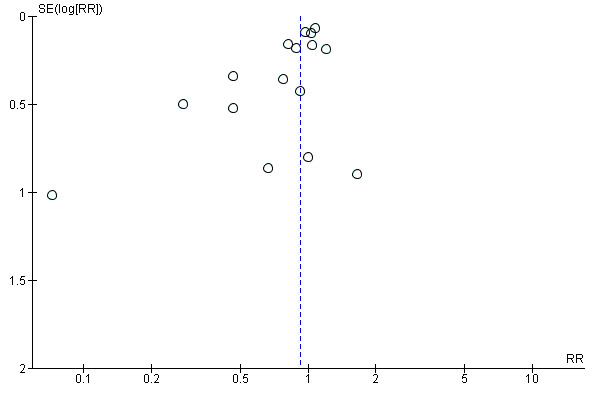
Funnel plot of comparison: 1 Vitamin C supplementation alone or in combination with other supplements (all trials), outcome: 1.8 Clinical pre‐eclampsia.
4.
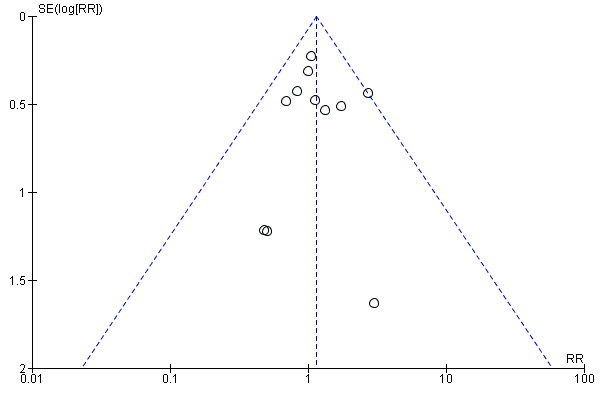
Funnel plot of comparison: 1 Vitamin C supplementation alone or in combination with other supplements (all trials), outcome: 1.1 Stillbirth.
5.
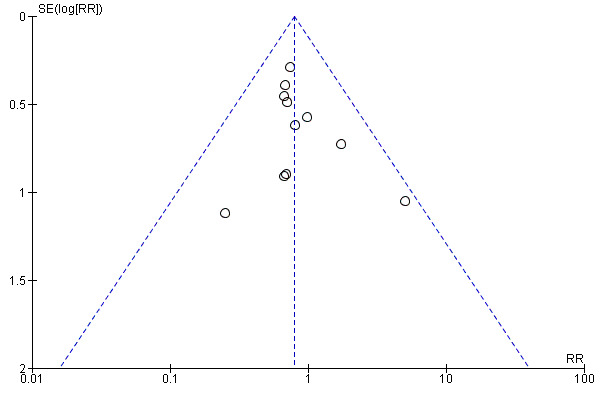
Funnel plot of comparison: 1 Vitamin C supplementation alone or in combination with other supplements (all trials), outcome: 1.2 Neonatal death.
6.
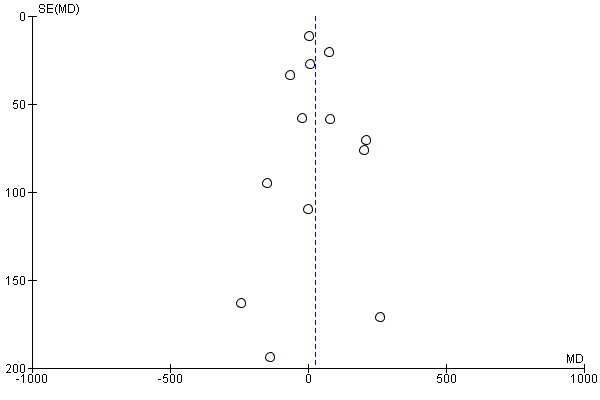
Funnel plot of comparison: 1 Vitamin C supplementation alone or in combination with other supplements (all trials), outcome: 1.18 Birthweight.
Quality of the evidence
The overall risk of bias is low to unclear for most of the studies.
The quality of the evidence using GRADE was high for intrauterine growth restriction, preterm birth, and placental abruption, moderate for stillbirth and clinical pre‐eclampsia, and low for preterm PROM (Table 1). The outcomes were downgraded due to wide confidence intervals crossing the line of no effect, high statistical heterogeneity, and the presence of publication bias.
Potential biases in the review process
We followed the Cochrane Pregnancy and Childbirth Group search strategies and recommended review processes to reduce potential biases. This included having at least two review authors independently assessing identified studies, extracting data and evaluating risk of bias.
Agreements and disagreements with other studies or reviews
The findings of this review are in agreement with several meta‐analyses examining the effects of vitamin C and E supplementation for the prevention of pre‐eclampsia and other maternal and perinatal complications (Basaran 2010; Conde‐Agudelo 2011).
The finding of a 36% reduction in the relative risk of placental abruption among vitamin C supplemented women compared with placebo or no control warrants further investigation. Several studies have reported the presence of low serum vitamin C concentrations as well as markers of oxidative stress in women with placental abruption (Incebiyik 2015; Sharma 1985). However, low serum concentrations of vitamin E and other antioxidants have also been associated with placental abruption (Sharma 1986). In addition, secondary analysis of one included study (Poston 2006), suggested that the reduced risk of placental abruption in supplemented women was confined to smokers. Therefore, these results should be interpreted with caution as it is unclear whether the reduced risk of placental abruption identified in this review is attributable to vitamin C or E or the combination of both agents, and also whether the effects are consistent across all subgroups of women. Further observational research examining the underlying pathways to placental abruption is required before any firm conclusions can be drawn about this finding.
Authors' conclusions
Implications for practice.
The available data from randomised trials involving over 24,000 women do not support routine vitamin C supplementation, either alone or in combination with vitamin E and other supplements in pregnancy, for all women or women at high risk of pregnancy complications. Supplementation was associated with a reduced risk of placental abruption; this requires further assessment, as it is unclear whether this effect is attributable to vitamin C, vitamin E or the combination of both vitamins. The review found conflicting results for prelabour rupture of fetal membranes (PROM), vitamin C given on its own appeared to decrease the risk of preterm and term PROM, however, the risk of term PROM was increased when supplementation included both vitamin C and vitamin E. Although side effects were scarcely reported, there was an increased risk of self‐reported abdominal pain in supplemented women.
Implications for research.
Further research is required to clarify the specific role of vitamin C in the aetiology of preterm and term PROM and placental abruption. Follow‐up studies of women and children enrolled in the current trials are also warranted to determine whether there are any longer‐term benefits or harms of vitamin E supplementation. Further research is also required to examine the effect of supplementation in women with a low or inadequate intake of vitamin C prior to and in early pregnancy.
What's new
| Date | Event | Description |
|---|---|---|
| 22 March 2016 | Amended | Added external source of support for Erika Ota (the Evidence and Programme Guidance Unit, Department of Nutrition for Health and Development, World Health Organization). |
History
Protocol first published: Issue 1, 2003 Review first published: Issue 1, 2005
| Date | Event | Description |
|---|---|---|
| 31 March 2015 | New citation required and conclusions have changed | Data are now available from randomised trials involving over 24,000 women. The new data do not support routine vitamin C supplementation, either alone or in combination with vitamin E and other supplements in pregnancy for the prevention of fetal or neonatal death, poor fetal growth, preterm birth or pre‐eclampsia. Supplementation was associated with a reduced risk of placental abruption. The review found conflicting results for prelabour rupture of fetal membranes (PROM); vitamin C given on its own appeared to decrease the risk of preterm and term PROM, however, the risk of term PROM was increased when supplementation included both vitamin C and vitamin E. There was an increased risk of self‐reported abdominal pain in supplemented women. |
| 31 March 2015 | New search has been performed | Search updated and 45 trials were identified, of these, 29 were eligible for inclusion. Four eligible trials were excluded in the previous version of this review as they did not report any clinically meaningful outcomes (Hammar 1987; Hankin 1966; Pressman 2003; Sikkema 2002), in the current version these trials have been included, however they do not contribute data to the meta‐analyses.The methods, results and discussion have been updated, new subgroup analyses were undertaken and a 'Summary of findings' table added. |
| 29 August 2011 | New search has been performed | Data on stillbirth and perinatal death added for 5 new eligible studies, in order to be used in the review "Interventions for preventing stillbirth during pregnancy: an overview of Cochrane systematic reviews". |
| 7 May 2010 | Amended | Search updated. Twenty‐six new reports added to Studies awaiting classification. |
| 7 July 2008 | Amended | Converted to new review format. |
Acknowledgements
We thank Philippa Middleton for her advice and comments regarding the format of the review.
Erika Ota's work was financially supported by the UNDP/UNFPA/UNICEF/WHO/World Bank Special Programme of Research, Development and Research Training in Human Reproduction (HRP), Department of Reproductive Health and Research (RHR), World Health Organization. The named authors alone are responsible for the views expressed in this publication.
As part of the pre‐publication editorial process, this review has been commented on by three peers (an editor and two referees who are external to the editorial team), a member of the Pregnancy and Childbirth Group's international panel of consumers and the Group's Statistical Adviser.
This project was supported by the National Institute for Health Research, via Cochrane Infrastructure funding to Cochrane Pregnancy and Childbirth. The views and opinions expressed therein are those of the authors and do not necessarily reflect those of the Systematic Reviews Programme, NIHR, NHS or the Department of Health.
Appendices
Appendix 1. Search strategies
Authors searched CENTRAL (The Cochrane Library 2004, Issue 2) using the terms pregnan*, vitamin*, ascorb*.
Authors also searched MEDLINE (1966 to May 2004), Current Contents (1998 to May 2004) and EMBASE (1980 to May 2004) using the following search strategy:
1. vitam* 2. ascorb* 3. pregnan* 4. #3 and (#1 or #2) 5. random* 6. controlled‐clinical‐trial 7. #5 or #6 8. #4 and #7
Data and analyses
Comparison 1. Vitamin C supplementation alone or in combination with other supplements (all trials).
| Outcome or subgroup title | No. of studies | No. of participants | Statistical method | Effect size |
|---|---|---|---|---|
| 1 Stillbirth | 11 | 20038 | Risk Ratio (M‐H, Fixed, 95% CI) | 1.15 [0.89, 1.49] |
| 2 Neonatal death | 11 | 19575 | Risk Ratio (M‐H, Fixed, 95% CI) | 0.79 [0.58, 1.08] |
| 3 Perinatal death | 7 | 17271 | Risk Ratio (M‐H, Random, 95% CI) | 1.07 [0.77, 1.49] |
| 4 Intrauterine growth restriction | 12 | 20361 | Risk Ratio (M‐H, Fixed, 95% CI) | 0.98 [0.91, 1.06] |
| 4.1 Birthweight less than 10th centile | 9 | 10320 | Risk Ratio (M‐H, Fixed, 95% CI) | 0.98 [0.90, 1.06] |
| 4.2 IUGR definition unclear | 1 | 216 | Risk Ratio (M‐H, Fixed, 95% CI) | 0.94 [0.45, 1.97] |
| 4.3 Birthweight <3rd centile | 1 | 9781 | Risk Ratio (M‐H, Fixed, 95% CI) | 1.00 [0.79, 1.27] |
| 4.4 Birthweight <1SD for gestational age | 1 | 44 | Risk Ratio (M‐H, Fixed, 95% CI) | 1.5 [0.28, 8.12] |
| 5 Preterm birth (< 37 weeks' gestation) | 16 | 22250 | Risk Ratio (M‐H, Random, 95% CI) | 0.99 [0.90, 1.10] |
| 6 Preterm prelabour rupture of membranes | 10 | 16825 | Risk Ratio (M‐H, Random, 95% CI) | 0.98 [0.70, 1.36] |
| 7 Term prelabour rupture of membranes | 3 | 2674 | Risk Ratio (M‐H, Random, 95% CI) | 1.26 [0.62, 2.56] |
| 8 Clinical pre‐eclampsia | 16 | 21956 | Risk Ratio (M‐H, Random, 95% CI) | 0.92 [0.80, 1.05] |
| 9 Maternal death (up to 6 weeks' pospartum) | 7 | 17120 | Risk Ratio (M‐H, Fixed, 95% CI) | 0.60 [0.14, 2.51] |
| 10 Bleeding episodes | 10 | Risk Ratio (M‐H, Fixed, 95% CI) | Subtotals only | |
| 10.1 Placental abruption | 8 | 15755 | Risk Ratio (M‐H, Fixed, 95% CI) | 0.64 [0.44, 0.92] |
| 10.2 Antepartum haemorrhage including placental abruption | 1 | 200 | Risk Ratio (M‐H, Fixed, 95% CI) | 7.0 [0.88, 55.86] |
| 10.3 Antepartum haemorrhage | 3 | 13089 | Risk Ratio (M‐H, Fixed, 95% CI) | 1.17 [0.83, 1.67] |
| 11 Serious maternal morbidity | 9 | Risk Ratio (M‐H, Fixed, 95% CI) | Subtotals only | |
| 11.1 Eclampsia | 9 | 20304 | Risk Ratio (M‐H, Fixed, 95% CI) | 1.42 [0.72, 2.78] |
| 11.2 Renal failure or insufficiency | 2 | 1933 | Risk Ratio (M‐H, Fixed, 95% CI) | 1.49 [0.55, 4.02] |
| 11.3 Disseminated intravascular coagulation | 1 | 56 | Risk Ratio (M‐H, Fixed, 95% CI) | 0.36 [0.02, 8.41] |
| 11.4 Pulmonary oedema | 4 | 12569 | Risk Ratio (M‐H, Fixed, 95% CI) | 0.40 [0.16, 1.03] |
| 12 Elective birth and caesarean section | 11 | Risk Ratio (M‐H, Fixed, 95% CI) | Subtotals only | |
| 12.1 Induction of labour | 2 | 2077 | Risk Ratio (M‐H, Fixed, 95% CI) | 1.12 [0.98, 1.27] |
| 12.2 Caesarean section | 9 | 16459 | Risk Ratio (M‐H, Fixed, 95% CI) | 1.02 [0.97, 1.07] |
| 12.3 Prelabour caesarean section | 2 | 1932 | Risk Ratio (M‐H, Fixed, 95% CI) | 1.15 [0.85, 1.56] |
| 13 Maternal anaemia | 0 | 0 | Risk Ratio (M‐H, Fixed, 95% CI) | 0.0 [0.0, 0.0] |
| 13.1 Iron deficiency anaemia | 0 | 0 | Risk Ratio (M‐H, Fixed, 95% CI) | 0.0 [0.0, 0.0] |
| 13.2 Megaloblastic anaemia | 0 | 0 | Risk Ratio (M‐H, Fixed, 95% CI) | 0.0 [0.0, 0.0] |
| 14 Maternal haemoglobin concentrations | 0 | 0 | Risk Ratio (M‐H, Fixed, 95% CI) | 0.0 [0.0, 0.0] |
| 14.1 Maternal haemoglobin levels | 0 | 0 | Risk Ratio (M‐H, Fixed, 95% CI) | 0.0 [0.0, 0.0] |
| 14.2 Cord serum haemoglobin | 0 | 0 | Risk Ratio (M‐H, Fixed, 95% CI) | 0.0 [0.0, 0.0] |
| 15 Iron and ferritin concentrations | 0 | 0 | Risk Ratio (M‐H, Fixed, 95% CI) | 0.0 [0.0, 0.0] |
| 15.1 Maternal serum iron | 0 | 0 | Risk Ratio (M‐H, Fixed, 95% CI) | 0.0 [0.0, 0.0] |
| 15.2 Maternal serum ferritin | 0 | 0 | Risk Ratio (M‐H, Fixed, 95% CI) | 0.0 [0.0, 0.0] |
| 15.3 Cord serum ferritin | 0 | 0 | Risk Ratio (M‐H, Fixed, 95% CI) | 0.0 [0.0, 0.0] |
| 16 Infant death | 1 | 2694 | Risk Ratio (M‐H, Fixed, 95% CI) | 3.02 [0.12, 74.12] |
| 17 Gestational age at birth | 9 | 14062 | Mean Difference (IV, Random, 95% CI) | 0.31 [0.01, 0.61] |
| 18 Birthweight | 13 | 17326 | Mean Difference (IV, Random, 95% CI) | 26.88 [‐18.81, 72.58] |
| 19 Congenital malformations | 4 | 5511 | Risk Ratio (M‐H, Fixed, 95% CI) | 1.16 [0.83, 1.63] |
| 20 Apgar score < 7 at 5 minutes | 3 | 3531 | Risk Ratio (M‐H, Fixed, 95% CI) | 0.73 [0.42, 1.27] |
| 21 Jaundice requiring phototherapy | 1 | 725 | Risk Ratio (M‐H, Fixed, 95% CI) | 0.78 [0.59, 1.04] |
| 22 Respiratory distress syndrome | 8 | 18574 | Risk Ratio (M‐H, Fixed, 95% CI) | 0.98 [0.89, 1.08] |
| 23 Chronic lung disease | 2 | 2579 | Risk Ratio (M‐H, Fixed, 95% CI) | 0.30 [0.08, 1.09] |
| 24 Periventricular haemorrhage | 6 | 17787 | Risk Ratio (M‐H, Fixed, 95% CI) | 0.91 [0.58, 1.42] |
| 25 Periventricular leukomalacia | 3 | 5049 | Risk Ratio (M‐H, Fixed, 95% CI) | 1.03 [0.15, 7.21] |
| 26 Bacterial sepsis | 5 | 13324 | Risk Ratio (M‐H, Random, 95% CI) | 1.10 [0.73, 1.67] |
| 27 Necrotising enterocolitis | 7 | 18514 | Risk Ratio (M‐H, Random, 95% CI) | 0.74 [0.36, 1.55] |
| 28 Retinopathy of prematurity | 6 | 18270 | Risk Ratio (M‐H, Fixed, 95% CI) | 1.18 [0.72, 1.93] |
| 29 Bronchopulmonary dysplasia | 1 | 683 | Risk Ratio (M‐H, Fixed, 95% CI) | 8.87 [0.48, 164.11] |
| 30 Side effects of vitamin C supplementation | 6 | Risk Ratio (M‐H, Fixed, 95% CI) | Subtotals only | |
| 30.1 Acne | 1 | 56 | Risk Ratio (M‐H, Fixed, 95% CI) | 3.21 [0.14, 75.68] |
| 30.2 Transient weakness | 1 | 56 | Risk Ratio (M‐H, Fixed, 95% CI) | 5.36 [0.27, 106.78] |
| 30.3 Skin rash | 1 | 56 | Risk Ratio (M‐H, Fixed, 95% CI) | 3.21 [0.14, 75.68] |
| 30.4 Pyrosis and nausea | 1 | 110 | Risk Ratio (M‐H, Fixed, 95% CI) | 7.0 [0.37, 132.40] |
| 30.5 Any side effects (symptoms not reported separately) | 1 | 707 | Risk Ratio (M‐H, Fixed, 95% CI) | 1.16 [0.39, 3.41] |
| 30.6 Abdominal pain | 1 | 1877 | Risk Ratio (M‐H, Fixed, 95% CI) | 1.66 [1.16, 2.37] |
| 30.7 Elevated liver enzymes (defined by authors) | 3 | 14209 | Risk Ratio (M‐H, Fixed, 95% CI) | 1.00 [0.71, 1.41] |
| 31 Use of health service resources ‐ maternal | 4 | 6509 | Risk Ratio (M‐H, Random, 95% CI) | 0.86 [0.69, 1.07] |
| 31.1 Hospitalisations in pregnancy | 3 | 2791 | Risk Ratio (M‐H, Random, 95% CI) | 0.87 [0.68, 1.11] |
| 31.2 Admission to intensive care unit | 2 | 3718 | Risk Ratio (M‐H, Random, 95% CI) | 0.60 [0.16, 2.30] |
| 32 Use of health service resources ‐ infant | 11 | Risk Ratio (M‐H, Fixed, 95% CI) | Subtotals only | |
| 32.1 Admission to intensive care unit | 9 | 18371 | Risk Ratio (M‐H, Fixed, 95% CI) | 1.02 [0.96, 1.09] |
| 32.2 Use of mechanical ventilation | 6 | 8531 | Risk Ratio (M‐H, Fixed, 95% CI) | 1.02 [0.84, 1.25] |
Comparison 2. Vitamin C supplementation (sensitivity analyses based on trial quality).
| Outcome or subgroup title | No. of studies | No. of participants | Statistical method | Effect size |
|---|---|---|---|---|
| 1 Stillbirth | 9 | 19592 | Risk Ratio (M‐H, Fixed, 95% CI) | 1.16 [0.89, 1.50] |
| 1.1 Low risk of bias | 9 | 19592 | Risk Ratio (M‐H, Fixed, 95% CI) | 1.16 [0.89, 1.50] |
| 2 Neonatal death | 8 | 19091 | Risk Ratio (M‐H, Fixed, 95% CI) | 0.82 [0.57, 1.17] |
| 2.1 Low risk of bias | 8 | 19091 | Risk Ratio (M‐H, Fixed, 95% CI) | 0.82 [0.57, 1.17] |
| 3 Perinatal death | 5 | 16677 | Risk Ratio (M‐H, Random, 95% CI) | 1.19 [0.82, 1.73] |
| 3.1 Low risk of bias | 5 | 16677 | Risk Ratio (M‐H, Random, 95% CI) | 1.19 [0.82, 1.73] |
| 4 Intrauterine growth restriction | 8 | 19842 | Risk Ratio (M‐H, Fixed, 95% CI) | 0.98 [0.91, 1.06] |
| 4.1 Low risk of bias | 8 | 19842 | Risk Ratio (M‐H, Fixed, 95% CI) | 0.98 [0.91, 1.06] |
| 5 Preterm birth | 9 | 21038 | Risk Ratio (M‐H, Fixed, 95% CI) | 0.99 [0.93, 1.06] |
| 5.1 Low risk of bias | 9 | 21038 | Risk Ratio (M‐H, Fixed, 95% CI) | 0.99 [0.93, 1.06] |
| 6 Preterm prelabour rupture of membranes | 6 | 16376 | Risk Ratio (M‐H, Random, 95% CI) | 1.20 [0.84, 1.71] |
| 6.1 Low risk of bias | 6 | 16376 | Risk Ratio (M‐H, Random, 95% CI) | 1.20 [0.84, 1.71] |
| 7 Term prelabour of rupture of membranes | 2 | 3060 | Risk Ratio (M‐H, Fixed, 95% CI) | 1.73 [1.34, 2.23] |
| 7.1 Low risk of bias | 2 | 3060 | Risk Ratio (M‐H, Fixed, 95% CI) | 1.73 [1.34, 2.23] |
| 8 Clinical pre‐eclampsia | 9 | 20531 | Risk Ratio (M‐H, Fixed, 95% CI) | 1.00 [0.92, 1.09] |
| 8.1 Low risk of bias | 9 | 20531 | Risk Ratio (M‐H, Fixed, 95% CI) | 1.00 [0.92, 1.09] |
Comparison 3. Vitamin C supplementation (subgroup analyses based on gestation at trial entry).
| Outcome or subgroup title | No. of studies | No. of participants | Statistical method | Effect size |
|---|---|---|---|---|
| 1 Stillbirth | 11 | 20038 | Risk Ratio (M‐H, Fixed, 95% CI) | 1.15 [0.89, 1.49] |
| 1.1 Entered into study < 20 weeks | 3 | 13084 | Risk Ratio (M‐H, Fixed, 95% CI) | 1.06 [0.73, 1.55] |
| 1.2 Entered into study > 20 weeks | 2 | 302 | Risk Ratio (M‐H, Fixed, 95% CI) | 0.77 [0.35, 1.70] |
| 1.3 Unclassified (entered into study both < and > 20 weeks) | 6 | 6652 | Risk Ratio (M‐H, Fixed, 95% CI) | 1.36 [0.92, 2.01] |
| 2 Neonatal death | 11 | 19575 | Risk Ratio (M‐H, Fixed, 95% CI) | 0.79 [0.58, 1.08] |
| 2.1 Entered into study < 20 weeks | 3 | 12977 | Risk Ratio (M‐H, Fixed, 95% CI) | 0.86 [0.53, 1.39] |
| 2.2 Entered into study > 20 weeks | 3 | 343 | Risk Ratio (M‐H, Fixed, 95% CI) | 0.93 [0.51, 1.68] |
| 2.3 Unclassified (entered into study both < and > 20 weeks) | 5 | 6255 | Risk Ratio (M‐H, Fixed, 95% CI) | 0.63 [0.36, 1.10] |
| 3 Perinatal death | 7 | 17105 | Risk Ratio (M‐H, Random, 95% CI) | 1.07 [0.77, 1.49] |
| 3.1 Entered into study < 20 weeks | 2 | 12332 | Risk Ratio (M‐H, Random, 95% CI) | 1.71 [0.42, 6.87] |
| 3.2 Entered into study > 20 weeks | 2 | 302 | Risk Ratio (M‐H, Random, 95% CI) | 0.94 [0.49, 1.82] |
| 3.3 Unclassified (entered into study both < and > 20 weeks) | 3 | 4471 | Risk Ratio (M‐H, Random, 95% CI) | 1.08 [0.61, 1.90] |
| 4 Intrauterine growth restriction | 12 | 20361 | Risk Ratio (M‐H, Fixed, 95% CI) | 0.98 [0.91, 1.06] |
| 4.1 Entered into study < 20 weeks | 5 | 13285 | Risk Ratio (M‐H, Fixed, 95% CI) | 0.96 [0.84, 1.10] |
| 4.2 Entered into study > 20 weeks | 0 | 0 | Risk Ratio (M‐H, Fixed, 95% CI) | 0.0 [0.0, 0.0] |
| 4.3 Unclassified (entered into study both < and > 20 weeks) | 7 | 7076 | Risk Ratio (M‐H, Fixed, 95% CI) | 0.99 [0.91, 1.09] |
| 5 Preterm birth | 16 | 22250 | Risk Ratio (M‐H, Random, 95% CI) | 0.99 [0.90, 1.10] |
| 5.1 Entered into study < 20 weeks | 6 | 13849 | Risk Ratio (M‐H, Random, 95% CI) | 0.96 [0.79, 1.18] |
| 5.2 Entered into study > 20 weeks | 1 | 109 | Risk Ratio (M‐H, Random, 95% CI) | 0.55 [0.24, 1.25] |
| 5.3 Unclassified (entered into study both < and > 20 weeks) | 9 | 8292 | Risk Ratio (M‐H, Random, 95% CI) | 1.01 [0.89, 1.16] |
| 6 Preterm prelabour rupture of membranes | 10 | 16825 | Risk Ratio (M‐H, Random, 95% CI) | 0.98 [0.70, 1.36] |
| 6.1 Entered into study < 20 weeks | 5 | 13147 | Risk Ratio (M‐H, Random, 95% CI) | 1.16 [0.71, 1.89] |
| 6.2 Entered into study > 20 weeks | 1 | 109 | Risk Ratio (M‐H, Random, 95% CI) | 0.31 [0.11, 0.89] |
| 6.3 Unclassified (entered into study both < and > 20 weeks) | 4 | 3569 | Risk Ratio (M‐H, Random, 95% CI) | 0.93 [0.64, 1.34] |
| 7 Term prelabour rupture of membranes | 3 | 3230 | Risk Ratio (M‐H, Random, 95% CI) | 1.23 [0.61, 2.47] |
| 7.1 Entered into study < 20 weeks | 3 | 3230 | Risk Ratio (M‐H, Random, 95% CI) | 1.23 [0.61, 2.47] |
| 7.2 Entered into study > 20 weeks | 0 | 0 | Risk Ratio (M‐H, Random, 95% CI) | 0.0 [0.0, 0.0] |
| 7.3 Unclassified (entered into study both < and > 20 weeks) | 0 | 0 | Risk Ratio (M‐H, Random, 95% CI) | 0.0 [0.0, 0.0] |
| 8 Clinical pre‐eclampsia | 16 | 21956 | Risk Ratio (M‐H, Random, 95% CI) | 0.92 [0.80, 1.05] |
| 8.1 Entered into study < 20 weeks | 5 | 13299 | Risk Ratio (M‐H, Random, 95% CI) | 1.03 [0.91, 1.16] |
| 8.2 Entered into study > 20 weeks | 0 | 0 | Risk Ratio (M‐H, Random, 95% CI) | 0.0 [0.0, 0.0] |
| 8.3 Unclassified (entered into study both < and > 20 weeks) | 10 | 8077 | Risk Ratio (M‐H, Random, 95% CI) | 0.91 [0.76, 1.10] |
| 8.4 Gestation at enrolment unknown | 1 | 580 | Risk Ratio (M‐H, Random, 95% CI) | 0.28 [0.10, 0.74] |
Comparison 4. Vitamin C supplementation (subgroup analysed based on dietary intake at trial entry).
| Outcome or subgroup title | No. of studies | No. of participants | Statistical method | Effect size |
|---|---|---|---|---|
| 1 Stillbirth | 11 | 20038 | Risk Ratio (M‐H, Fixed, 95% CI) | 1.15 [0.89, 1.49] |
| 1.1 "Low nutritional status" | 1 | 815 | Risk Ratio (M‐H, Fixed, 95% CI) | 1.01 [0.54, 1.87] |
| 1.2 "Adequate" dietary intake | 6 | 15692 | Risk Ratio (M‐H, Fixed, 95% CI) | 1.28 [0.92, 1.80] |
| 1.3 Dietary intake unclear | 4 | 3531 | Risk Ratio (M‐H, Fixed, 95% CI) | 0.96 [0.57, 1.60] |
| 2 Neonatal death | 11 | 19575 | Risk Ratio (M‐H, Fixed, 95% CI) | 0.79 [0.58, 1.08] |
| 2.1 "Low nutritional status" | 1 | 777 | Risk Ratio (M‐H, Fixed, 95% CI) | 0.71 [0.27, 1.83] |
| 2.2 "Adequate dietary intake" | 5 | 15259 | Risk Ratio (M‐H, Fixed, 95% CI) | 0.68 [0.44, 1.05] |
| 2.3 Dietary intake unclear | 5 | 3539 | Risk Ratio (M‐H, Fixed, 95% CI) | 1.02 [0.63, 1.67] |
| 3 Perinatal death | 7 | 17105 | Risk Ratio (M‐H, Random, 95% CI) | 1.07 [0.77, 1.49] |
| 3.1 "Low nutritional status" | 1 | 1515 | Risk Ratio (M‐H, Random, 95% CI) | 0.83 [0.59, 1.17] |
| 3.2 "Adequate dietary intake" | 3 | 12925 | Risk Ratio (M‐H, Random, 95% CI) | 1.41 [0.94, 2.11] |
| 3.3 Dietary intake unclear | 3 | 2665 | Risk Ratio (M‐H, Random, 95% CI) | 1.12 [0.52, 2.41] |
| 4 Intrauterine growth restriction | 12 | 20361 | Risk Ratio (M‐H, Fixed, 95% CI) | 0.98 [0.91, 1.06] |
| 4.1 "Low nutritional status" | 1 | 1165 | Risk Ratio (M‐H, Fixed, 95% CI) | 0.92 [0.75, 1.12] |
| 4.2 "Adequate dietary intake" | 5 | 15433 | Risk Ratio (M‐H, Fixed, 95% CI) | 1.01 [0.92, 1.11] |
| 4.3 Dietary intake unclear | 6 | 3763 | Risk Ratio (M‐H, Fixed, 95% CI) | 0.95 [0.81, 1.12] |
| 5 Preterm birth (< 37 weeks' gestation) | 16 | 22250 | Risk Ratio (M‐H, Random, 95% CI) | 0.99 [0.90, 1.10] |
| 5.1 "Low nutritional status" | 3 | 2560 | Risk Ratio (M‐H, Random, 95% CI) | 0.88 [0.76, 1.02] |
| 5.2 "Adequate" dietary intake | 7 | 15935 | Risk Ratio (M‐H, Random, 95% CI) | 1.00 [0.88, 1.14] |
| 5.3 Dietary intake unknown | 6 | 3755 | Risk Ratio (M‐H, Random, 95% CI) | 1.00 [0.73, 1.37] |
| 6 Preterm prelabour rupture of membranes | 10 | 16825 | Risk Ratio (M‐H, Random, 95% CI) | 0.98 [0.70, 1.36] |
| 6.1 "Low nutritional intake" | 1 | 833 | Risk Ratio (M‐H, Random, 95% CI) | 0.80 [0.41, 1.54] |
| 6.2 "Adequate" dietary intake | 4 | 12592 | Risk Ratio (M‐H, Random, 95% CI) | 0.87 [0.60, 1.26] |
| 6.3 Dietary intake unclear | 5 | 3400 | Risk Ratio (M‐H, Random, 95% CI) | 1.22 [0.56, 2.67] |
| 7 Term prelabour rupture of membranes | 3 | 3230 | Risk Ratio (M‐H, Random, 95% CI) | 1.23 [0.61, 2.47] |
| 7.1 "Low nutritional intake" | 0 | 0 | Risk Ratio (M‐H, Random, 95% CI) | 0.0 [0.0, 0.0] |
| 7.2 "Adequate" dietary intake | 0 | 0 | Risk Ratio (M‐H, Random, 95% CI) | 0.0 [0.0, 0.0] |
| 7.3 Dietary intake unclear | 3 | 3230 | Risk Ratio (M‐H, Random, 95% CI) | 1.23 [0.61, 2.47] |
| 8 Clinical pre‐eclampsia | 16 | Risk Ratio (M‐H, Random, 95% CI) | Subtotals only | |
| 8.1 "Low nutritional status" | 2 | 2188 | Risk Ratio (M‐H, Random, 95% CI) | 1.01 [0.84, 1.22] |
| 8.2 "Adequate" dietary intake | 6 | 15473 | Risk Ratio (M‐H, Random, 95% CI) | 0.97 [0.82, 1.14] |
| 8.3 Dietary intake unclear | 8 | 4295 | Risk Ratio (M‐H, Random, 95% CI) | 0.70 [0.47, 1.06] |
| 8.4 Baseline vitamin C status <10 µmol/L | 1 | 28 | Risk Ratio (M‐H, Random, 95% CI) | 0.14 [0.02, 1.05] |
| 8.5 Baseline vitamin C status 10‐30 µmol/L | 1 | 165 | Risk Ratio (M‐H, Random, 95% CI) | 0.88 [0.39, 1.97] |
| 8.6 Baseline vitamin C status >30 µmol/L | 1 | 453 | Risk Ratio (M‐H, Random, 95% CI) | 0.78 [0.52, 1.16] |
Comparison 5. Vitamin C supplementation (subgroup analyses based on the type of supplement).
| Outcome or subgroup title | No. of studies | No. of participants | Statistical method | Effect size |
|---|---|---|---|---|
| 1 Stillbirth | 11 | 20038 | Risk Ratio (M‐H, Fixed, 95% CI) | 1.15 [0.89, 1.49] |
| 1.1 Vitamin C alone | 2 | 1015 | Risk Ratio (M‐H, Fixed, 95% CI) | 1.06 [0.58, 1.94] |
| 1.2 Vitamin C in addition to other supplements | 9 | 19023 | Risk Ratio (M‐H, Fixed, 95% CI) | 1.17 [0.88, 1.56] |
| 2 Neonatal death | 11 | 19575 | Risk Ratio (M‐H, Fixed, 95% CI) | 0.79 [0.58, 1.08] |
| 2.1 Vitamin C alone | 2 | 958 | Risk Ratio (M‐H, Fixed, 95% CI) | 0.70 [0.30, 1.63] |
| 2.2 Vitamin C in addition to other supplements | 9 | 18617 | Risk Ratio (M‐H, Fixed, 95% CI) | 0.81 [0.58, 1.13] |
| 3 Perinatal death | 7 | 17105 | Risk Ratio (M‐H, Random, 95% CI) | 1.07 [0.77, 1.49] |
| 3.1 Vitamin C alone | 1 | 182 | Risk Ratio (M‐H, Random, 95% CI) | 0.51 [0.05, 5.54] |
| 3.2 Vitamin C in addition to other supplements | 6 | 16923 | Risk Ratio (M‐H, Random, 95% CI) | 1.09 [0.77, 1.54] |
| 4 Intrauterine growth restriction | 12 | 20361 | Risk Ratio (M‐H, Fixed, 95% CI) | 0.98 [0.91, 1.06] |
| 4.1 Vitamin C alone | 1 | 159 | Risk Ratio (M‐H, Fixed, 95% CI) | 1.56 [0.63, 3.89] |
| 4.2 Vitamin C in addition to other supplements | 11 | 20202 | Risk Ratio (M‐H, Fixed, 95% CI) | 0.98 [0.91, 1.06] |
| 5 Preterm birth | 16 | 22250 | Risk Ratio (M‐H, Random, 95% CI) | 0.99 [0.90, 1.10] |
| 5.1 Vitamin C alone | 5 | 1685 | Risk Ratio (M‐H, Random, 95% CI) | 1.06 [0.75, 1.48] |
| 5.2 Vitamin C in addition to other supplements | 11 | 20565 | Risk Ratio (M‐H, Random, 95% CI) | 0.98 [0.88, 1.09] |
| 6 Preterm prelabour rupture of membranes | 10 | 16825 | Risk Ratio (M‐H, Random, 95% CI) | 0.98 [0.70, 1.36] |
| 6.1 Vitamin C alone | 5 | 1282 | Risk Ratio (M‐H, Random, 95% CI) | 0.66 [0.48, 0.91] |
| 6.2 Vitamin C in addition to other supplements | 5 | 15543 | Risk Ratio (M‐H, Random, 95% CI) | 1.28 [0.86, 1.92] |
| 7 Term prelabour rupture of membranes | 3 | 3230 | Risk Ratio (M‐H, Random, 95% CI) | 1.23 [0.61, 2.47] |
| 7.1 Vitamin C alone | 1 | 170 | Risk Ratio (M‐H, Random, 95% CI) | 0.55 [0.32, 0.94] |
| 7.2 Vitamin C in combination with other supplements | 2 | 3060 | Risk Ratio (M‐H, Random, 95% CI) | 1.73 [1.34, 2.23] |
| 8 Clinical pre‐eclampsia | 16 | 21956 | Risk Ratio (M‐H, Random, 95% CI) | 0.92 [0.80, 1.05] |
| 8.1 Vitamin C alone | 3 | 1191 | Risk Ratio (M‐H, Random, 95% CI) | 0.88 [0.48, 1.61] |
| 8.2 Vitamin C in addition to other supplements | 13 | 20765 | Risk Ratio (M‐H, Random, 95% CI) | 0.91 [0.78, 1.06] |
Comparison 6. Vitamin C supplementation (subgroup analyses based on risk of adverse pregnancy outcomes).
| Outcome or subgroup title | No. of studies | No. of participants | Statistical method | Effect size |
|---|---|---|---|---|
| 1 Stillbirth | 11 | 20038 | Risk Ratio (M‐H, Fixed, 95% CI) | 1.15 [0.89, 1.49] |
| 1.1 High/increased risk | 8 | 7501 | Risk Ratio (M‐H, Fixed, 95% CI) | 1.27 [0.87, 1.86] |
| 1.2 Low/moderate risk | 3 | 12537 | Risk Ratio (M‐H, Fixed, 95% CI) | 1.07 [0.75, 1.51] |
| 2 Neonatal death | 11 | 19575 | Risk Ratio (M‐H, Fixed, 95% CI) | 0.79 [0.58, 1.08] |
| 2.1 High/increased risk | 8 | 7164 | Risk Ratio (M‐H, Fixed, 95% CI) | 0.89 [0.59, 1.33] |
| 2.2 Low/moderate risk | 3 | 12411 | Risk Ratio (M‐H, Fixed, 95% CI) | 0.68 [0.42, 1.10] |
| 3 Perinatal death | 7 | 17105 | Risk Ratio (M‐H, Random, 95% CI) | 1.07 [0.77, 1.49] |
| 3.1 High/increased risk | 6 | 7136 | Risk Ratio (M‐H, Random, 95% CI) | 1.08 [0.73, 1.59] |
| 3.2 Low/moderate risk | 1 | 9969 | Risk Ratio (M‐H, Random, 95% CI) | 1.09 [0.48, 2.46] |
| 4 Intrauterine growth restriction | 12 | 20361 | Risk Ratio (M‐H, Fixed, 95% CI) | 0.98 [0.91, 1.06] |
| 4.1 High/increased risk | 8 | 8352 | Risk Ratio (M‐H, Fixed, 95% CI) | 0.99 [0.91, 1.08] |
| 4.2 Low/moderate risk | 4 | 12009 | Risk Ratio (M‐H, Fixed, 95% CI) | 0.97 [0.81, 1.15] |
| 5 Preterm birth (< 37 weeks' gestation) | 16 | 22250 | Risk Ratio (M‐H, Random, 95% CI) | 0.99 [0.90, 1.10] |
| 5.1 High/increased risk | 9 | 8703 | Risk Ratio (M‐H, Random, 95% CI) | 1.03 [0.90, 1.18] |
| 5.2 Low/moderate risk | 7 | 13547 | Risk Ratio (M‐H, Random, 95% CI) | 0.92 [0.76, 1.12] |
| 6 Preterm prelabour rupture of membranes | 10 | 16825 | Risk Ratio (M‐H, Random, 95% CI) | 0.98 [0.70, 1.36] |
| 6.1 High/increased risk | 5 | 4039 | Risk Ratio (M‐H, Random, 95% CI) | 1.09 [0.60, 2.01] |
| 6.2 Low/moderate risk | 5 | 12786 | Risk Ratio (M‐H, Random, 95% CI) | 0.89 [0.61, 1.30] |
| 7 Term prelabour rupture of membranes | 3 | 3230 | Risk Ratio (M‐H, Random, 95% CI) | 1.23 [0.61, 2.47] |
| 7.1 High/increased risk | 3 | 3230 | Risk Ratio (M‐H, Random, 95% CI) | 1.23 [0.61, 2.47] |
| 7.2 Low/moderate risk | 0 | 0 | Risk Ratio (M‐H, Random, 95% CI) | 0.0 [0.0, 0.0] |
| 8 Clinical pre‐eclampsia | 16 | 21956 | Risk Ratio (M‐H, Random, 95% CI) | 0.92 [0.80, 1.05] |
| 8.1 High/increased risk | 10 | 8323 | Risk Ratio (M‐H, Random, 95% CI) | 0.91 [0.78, 1.06] |
| 8.2 Low/moderate risk | 6 | 13633 | Risk Ratio (M‐H, Random, 95% CI) | 0.87 [0.61, 1.24] |
Characteristics of studies
Characteristics of included studies [ordered by study ID]
Beazley 2005.
| Methods | Treatment allocation: unclear, no methodological details given, women were "randomized". Blinding of outcome assessment: "double blind" stated. Documentation of exclusion: 9 (8%) women were lost to follow‐up. Use of placebo control: placebo control. |
|
| Participants | Inclusion criteria: women at "high risk of pre‐eclampsia" including those with previous pre‐eclampsia, chronic hypertension, pregestational diabetes and multifetal gestation. Nil exclusion criteria stated. Women were randomised at 14‐20 weeks' gestation to receive either daily vitamin C and E (n = 54) or placebo (n = 55). | |
| Interventions | Women randomised to the treatment group received daily 1000 mg vitamin C in addition to 400 IU vitamin E. No specific details on the content of the placebo were given or the duration of supplementation. | |
| Outcomes | 1. Pre‐eclampsia (not defined). 2. GA at birth (weeks). 3. Preterm birth (< 37 weeks' gestation). 4. Birthweight. 5. Birthweight < 10th centile. 6. TAS and 8‐IP. | |
| Notes | Dosage: daily 1000 mg vitamin C, above RDI. GA at trial entry: <= 20 weeks' gestation. Dietary vitamin C intake before trial entry: unclear, no dietary information reported. Type of supplement: vitamin C given in addition to vitamin E. Women's risk status: women were at high risk of pre‐eclampsia. Intention‐to‐treat analyses: stated that analyses were intention‐to‐treat. However, losses to follow‐up were not included in the totals. Available case analysis. Sample size calculation: none reported. Adherence: unclear, no details given. Location: United States of America. Timeframe: unclear. Published in abstract format only. |
|
| Risk of bias | ||
| Bias | Authors' judgement | Support for judgement |
| Random sequence generation (selection bias) | Unclear risk | Quote: "double‐blind, randomized clinical trial" stated, but no details about sequence generation provided. |
| Allocation concealment (selection bias) | Unclear risk | As above, no details provided about method of allocation. |
| Blinding of participants and personnel (performance bias) All outcomes | Unclear risk | "Double blind" and "placebo" stated but no further details provided. |
| Blinding of outcome assessment (detection bias) All outcomes | Unclear risk | No details provided about blinding of outcome assessment. |
| Incomplete outcome data (attrition bias) All outcomes | Low risk | 9 (8%) women were lost to follow‐up or withdrew, 6 (11%) in control group, and 3 (5%) in the vitamin group. |
| Selective reporting (reporting bias) | Unclear risk | No study protocol available. |
| Other bias | Unclear risk | No details provided about the baseline characteristics of each group. |
Borna 2005.
| Methods | A randomised controlled trial conducted from September 2002 to September 2003 at a teaching hospital in Tehran, Iran. Block randomisation method was used for allocation of participants. |
|
| Participants | 60 women with a singleton pregnancy who had preterm premature rupture of membrane at 26 to 34 weeks' gestation were enrolled in the study. Exclusion criteria included chorioamnionitis, non‐reassuring fetal status on admission, obstetric indication for immediate birth, birth within 24 hours of admission, major congenital anomalies, and fetal growth restriction. |
|
| Interventions | Intervention group (n = 30) received tablets containing 500 mg of vitamin C and 400 IU of vitamin E daily. Control group (n = 30) received placebo tablets similar to the intervention group. Duration of supplementation not explicitly stated. All women received prophylactic antibiotics (ampicillin 2 g and erythromycin 250 mg every 6 hours for 2 days, followed by amoxicillin 250 mg and erythromycin base 333 mg three times a day for 5 days). All women received 2 injections of 12 mg betamethasone during first 24 hours of admission. |
|
| Outcomes | 1. Latency (mean, SD). 2. Birthweight (mean, SD). 3. GA at birth (mean, SD). 4. Amniotic fluid index <= 5 cm at admission (number, percentage). 5. Amniotic fluid index <= 5 cm after the beginning of labour (number, percentage). 6. Caesarean section due to fetal distress (number, percentage). 7. Chorioamnionitis (number, percentage). 8. Postpartum endometritis (number, percentage). 9. Respiratory distress syndrome (number, percentage). 10. NICU admission (number, percentage). 11. Neonatal sepsis (number, percentage). 12. Neonatal mortality (number, percentage). |
|
| Notes | ||
| Risk of bias | ||
| Bias | Authors' judgement | Support for judgement |
| Random sequence generation (selection bias) | Unclear risk | Block randomisation methods used, but no details of sequence generation. |
| Allocation concealment (selection bias) | Unclear risk | No details provided about any method of concealment. |
| Blinding of participants and personnel (performance bias) All outcomes | Low risk | Quote: "Randomization was blinded to both patients and caregivers". Quote: "The control group received placebo tablets similar to those of vitamins C and E at the same frequency"; therefore, the review authors believe blinding of women and caregivers was probably maintained. |
| Blinding of outcome assessment (detection bias) All outcomes | Unclear risk | No specific information provided about blinding of outcome assessment. |
| Incomplete outcome data (attrition bias) All outcomes | Unclear risk | No information provided about attrition. |
| Selective reporting (reporting bias) | Unclear risk | Study protocol was not available. |
| Other bias | Low risk | Baseline characteristics were similar between groups. |
Casanueva 2005.
| Methods | RCT with 2 arms, individual randomisation. | |
| Participants | Pregnant women with no acute or chronic diseases, at 20 weeks of gestation, singleton pregnancy, no consumption of vitamin supplements. | |
| Interventions | Intervention: 100 mg vitamin C per day. Control: placebo of the same size and shape. Duration of supplementation not explicitly stated, Setting: the Instituto Nacional de Perinatologia (INPer) in Mexico City from 2002 to 2003. |
|
| Outcomes | 1. PROM. 2. Preterm birth. 3. Birthweight. 4.GA. 5. Plasma and leucocyte vitamin C concentrations. |
|
| Notes | Control: 62 allocated, 5 lost to follow‐up, 3 went other hospitals, 2 had planned CS, 57 included in the analysis. Intervention: 58 allocated, 6 lost to follow‐up, 3 went other hospitals, 3 had planned CS 52 included in the analysis. Dietary intake of vitamin C assessed in both groups, the mean daily vitamin C intake was 63 and 68 mg in the placebo and vitamin C groups, respectively. |
|
| Risk of bias | ||
| Bias | Authors' judgement | Support for judgement |
| Random sequence generation (selection bias) | Low risk | Quote: "women were allocated to 1 of 2 groups by a random‐number table" and "the principal investigator generated the random table". |
| Allocation concealment (selection bias) | Low risk | Quote: "the principal investigator...prepared all tablets, and ensured that staff members were blinded as to the grouping codes." The tablets were "shipped to each participant directly from the research pharmacy, which concealed the treatment assignment from the investigators". Therefore, the review authors consider that there probably was allocation concealment, and therefore the risk of selection bias is low. |
| Blinding of participants and personnel (performance bias) All outcomes | Low risk | As above, and the control group received a placebo of "the same size and shape" as vitamin C tablets. |
| Blinding of outcome assessment (detection bias) All outcomes | Unclear risk | No specific details provided about blinding of outcome assessment. |
| Incomplete outcome data (attrition bias) All outcomes | Low risk | 5/62 (8%) and 6/58 (10%) lost to follow‐up in the placebo and vitamin groups, respectively and the reasons were similar in each group. |
| Selective reporting (reporting bias) | Unclear risk | Study protocol was not available. |
| Other bias | Unclear risk | The baseline characteristics were similar between groups. |
Chappell 1999.
| Methods | Treatment allocation: a computer‐generated randomisation list using blocks of 10 was given to the hospital pharmacy departments. Researchers allocated the next available number to participants and women collected the trial tablets from the pharmacy department. Blinding of outcome assessment: women, caregivers and researchers were blinded to the treatment allocation until recruitment, data collection and laboratory analyses were complete. Documentation of exclusion: pregnancy outcome data was reported according to treatment allocation for all women randomised. Use of placebo control: placebo control. |
|
| Participants | Inclusion criteria: abnormal Doppler waveform in either uterine artery at 18‐22 weeks' gestation or a history in the preceding pregnancy of pre‐eclampsia necessitating birth before 37 weeks' gestation, eclampsia or the syndrome of HELLP. Exclusion criteria: heparin or warfarin treatment, abnormal fetal‐anomaly scan or multiple pregnancy. Women were randomised at 18‐22 weeks' gestation. However, women with a previous history who were identified at an earlier stage were randomised at 16 weeks' gestation. Women with abnormal Doppler waveform analysis returned for a second scan at 24 weeks' gestation, those with a normal waveform at this time stopped treatment and were withdrawn from the study. The remaining women who had persistently abnormal waveforms, and those with a previous history or pre‐eclampsia remained in the study and were seen every 4 weeks through the rest of pregnancy. 1512 women underwent Doppler screening, 273 women had abnormal waveforms and of these, 242 women consented to the study. An additional 41 women who had a history of pre‐eclampsia consented. 283 women were randomised to either the vitamin C and E group (n = 141) or the placebo group (n = 142), 72 women had normal Doppler scans at 24 weeks' gestation and 24 women did not return for a second scan and were withdrawn. A further 27 women withdrew from the trial after 24 week's gestation for various reasons. In total, 160 women completed the trial protocol until birth, 79 in the vitamin C and E group and 81 in the placebo group. Pregnancy outcome data were presented for all women randomised (n = 283) as well as only for those women completing the trial protocol (n = 160). | |
| Interventions | Women randomised to the vitamin C and E group received tablets containing 1000 mg vitamin C daily and capsules containing 400 IU vitamin E daily. Women randomised to the placebo group received tablets containing microcrystalline cellulose and capsules containing soya bean oil, that were identical in appearance to the vitamin C tablets and vitamin E capsules. Duration of supplementation not explicitly stated, After 24 weeks' gestation women were seen every 4 weeks, and blood samples were taken at each visit. | |
| Outcomes | 1. Ratio of PAI‐1 to PAI‐2. 2. Incidence of pre‐eclampsia (defined according to the ISSHP guidelines). 3. Placental abruption. 4. Spontaneous preterm birth (< 37 weeks' gestation). 5. Intrauterine death. 6. SGA infants (on or below the 10th centile). 7. Mean systolic and diastolic blood pressure before birth. 8. GA at birth (median, IQR). 9. Birthweight (median, IQR). 10. Birthweight centile (median, IQR). 11. Mean plasma ascorbic acid and alpha‐tocopherol concentrations during gestation. 12. Biochemical indices of oxidative stress and placental function. | |
| Notes | Dosage: daily 1000 mg, above RDI. GA at trial entry: between 16‐22 weeks' gestation. Dietary vitamin C intake before trial entry: unknown, not assessed. Type of supplement: vitamin C given in addition to vitamin E. Women's risk status: women were at "high risk for pre‐eclampsia". Intention‐to‐treat analyses: performed, pregnancy outcome data were available for all women randomised, and results were presented according to initial treatment allocation. Sample size calculation: the study had 80% power to detect a 30% reduction in PAI‐1. Adherence: not specifically reported. "Within the treated group, plasma ascorbic acid concentration increased by 32% from baseline values and plasma alpha‐tocopherol increased by 54%". Location: London, United Kingdom. Timeframe: unclear. |
|
| Risk of bias | ||
| Bias | Authors' judgement | Support for judgement |
| Random sequence generation (selection bias) | Low risk | Quote: "A computer‐generated randomisation list was drawn up by the statistician, with randomisation in blocks of ten". |
| Allocation concealment (selection bias) | Low risk | Researchers allocated the next available number to participants and women collected the trial tablets directly from the pharmacy department. |
| Blinding of participants and personnel (performance bias) All outcomes | Low risk | Women, caregivers and researchers were blinded to the treatment allocation until recruitment, data collection and laboratory analyses were complete. Placebo control used. |
| Blinding of outcome assessment (detection bias) All outcomes | Low risk | Women, caregivers and researchers were blinded to the treatment allocation until recruitment, data collection and laboratory analyses were complete. Placebo control used. |
| Incomplete outcome data (attrition bias) All outcomes | Low risk | No losses to follow‐up reported. |
| Selective reporting (reporting bias) | Unclear risk | No study protocol available. |
| Other bias | Low risk | Baseline characteristics were similar between groups. |
Ghomian 2013.
| Methods | RCT with 2 arms, individual randomisation. | |
| Participants | 170 pregnant women with the history of PPROM in a previous pregnancy, with a singleton pregnancy and GA 14 weeks. | |
| Interventions | Intervention: 100 mg vitamin C daily from 14 weeks of gestation up to 37 weeks. Control: chewing tablet of placebo, same shape as vitamin C tablets. All women were given 400 μg folic acid daily as well as an iron tablet containing 30 mg elemental iron. Setting: Imam‐Reza Hospital, Mashhad University of Medical Sciences, Mashhad, IR Iran, during 2008 to 2010. |
|
| Outcomes |
|
|
| Notes | Intervention: 85 enrolled, 85 (100%) included in the analysis. Control: 85 enrolled, 85 (100%) included in the analysis. Adherence not reported. |
|
| Risk of bias | ||
| Bias | Authors' judgement | Support for judgement |
| Random sequence generation (selection bias) | Unclear risk | Quote: "patients were randomly divided into two groups", no further details given. |
| Allocation concealment (selection bias) | Unclear risk | No information provided about concealment of allocation. |
| Blinding of participants and personnel (performance bias) All outcomes | Unclear risk | As above. |
| Blinding of outcome assessment (detection bias) All outcomes | Unclear risk | As above. |
| Incomplete outcome data (attrition bias) All outcomes | Low risk | All reported participants were included in the analysis. |
| Selective reporting (reporting bias) | Unclear risk | No study protocol available. |
| Other bias | Unclear risk | Groups appear to be similar for some basic baseline characteristics. |
Gulmezoglu 1997.
| Methods | Treatment allocation: "the treatment packs were randomised by computer generated random numbers in blocks of ten". Randomisation was carried out by an independent researcher who was not involved in the study, and medications were placed in consecutively numbered sealed opaque bags. Blinding of outcome assessment: women, caregivers and researchers were blinded to the treatment allocation. Documentation of exclusion: no exclusions documented. Use of placebo control: placebo control. |
|
| Participants | Inclusion criteria: women who were admitted to the antenatal wards with a diagnosis of severe pre‐eclampsia, as defined by 2+ proteinuria on urine dipstix testing (in at least 2 consecutive tests 4 to 6 hours apart), with a blood pressure of 160/110 mmHg, or 3+ proteinuria with blood pressure >= 150/100 mmHg; between 24 and 32 weeks' gestation; with a single live fetus; with no systemic disorder (such as diabetes or systemic lupus erythematosus) and no allergy to study medications. Women were approached when they were eligible for conservative management, as defined by an absence of significant renal impairment, the HELLP syndrome or thrombocytopenia alone. Conservative management consisted of advising women to stay in hospital until birth, with weekly betamethasone injections up to 32‐34 weeks' gestation, and with frequent fetal and maternal monitoring. Exclusion criteria: none stated. 59 women were approached and counselled about the study, of which 56 women gave informed written consent, and allocated to either the vitamin group (n = 27) or placebo (n = 29). | |
| Interventions | Women randomised to the vitamin group received twice daily 500 mg vitamin C (1000 mg daily total), 400 IU vitamin E (800 IU daily total) and 100 mg allopurinol (200 mg daily total) until birth. Women randomised to the placebo group received the same number of tablets that were identical to the vitamin C and allopurinol tablets. Vitamin C placebos were used as placebos for vitamin E, because it was not possible to obtain 2 separate sets of placebos from the supplier. However, the vitamin E tablets and their placebos were slightly different. To preserve blinding all medications were placed in dark brown coloured bottles and sealed opaque paper bags. | |
| Outcomes | 1. Birth within 14 days. 2. Maternal deaths. 3. Serious maternal complications (pulmonary oedema, eclampsia, HELLP syndrome, disseminated intravascular coagulation, renal failure). 4. Placental abruption. 5. Prelabour caesarean section. 6. Use of antihypertensives. 7. Stillbirth. 8. Apgar score < 7 at 1 minute and < 7 at 5 minutes. 9. Umbilical artery pH < 7.2. 10. Admission to intensive care unit. 11. Mechanical ventilation. 12. Neonatal death. 13. Perinatal death. 14. Birthweight (median, range). 15. Lipid peroxide and vitamin E levels. 16. Haematological and renal function parameters. 17. Placental lipid peroxide and glutathione levels. | |
| Notes | Dosage: daily 1000 mg, above RDI. GA at trial entry: > 20 weeks' gestation. Dietary vitamin C intake before trial entry: unclear, no dietary information reported. Type of supplement: vitamin C given in addition to vitamin E and allopurinol. Women's risk status: women had established early onset severe pre‐eclampsia. Intention‐to‐treat analyses: all data were reported according to women's treatment allocation, and were available for all women for the primary outcome. There was missing data for the outcomes Apgar score < 7 at 1 minute, Apgar score < 7 at 5 minutes, umbilical artery pH < 7.2, and the lipid peroxide and vitamin E levels and haematological and renal function parameters. Sample size calculation: a sample size of 54 women had 80% power to detect a halving in the number of women needing birth within 14 days, from 80% to 40%. Adherence: adherence in the vitamin group was estimated at 89%, 84% and 93% for the vitamin C, vitamin E and allopurinol tablets. For the placebo group adherence was 100%, 75% and 86% for the vitamin C, vitamin E and allopurinol placebo tablets. Location: Johannesburg, South Africa. Timeframe: unclear. |
|
| Risk of bias | ||
| Bias | Authors' judgement | Support for judgement |
| Random sequence generation (selection bias) | Low risk | Quote: "treatment packs were randomised by computer generated random numbers in blocks of ten". |
| Allocation concealment (selection bias) | Low risk | Quote: "randomisation was done by an independent researcher who was not involved in the study" and "medications (active or placebo) were placed in consecutively numbered sealed opaque paper bags". |
| Blinding of participants and personnel (performance bias) All outcomes | Low risk | Women, caregivers and researchers were blinded to the treatment allocation. |
| Blinding of outcome assessment (detection bias) All outcomes | Low risk | Women, caregivers and researchers were blinded to the treatment allocation. |
| Incomplete outcome data (attrition bias) All outcomes | Low risk | All data were reported according to women's treatment allocation, and were available for all women for the primary outcome. Some missing data for secondary outcomes. |
| Selective reporting (reporting bias) | Unclear risk | Study protocol not available. |
| Other bias | Low risk | Baseline characteristics were similar between groups. |
Gungorduk 2014.
| Methods | A randomised controlled trial conducted between January 2011 and November 2011 at a teaching hospital in Istanbul, Turkey. Prior to the recruitment, a code was generated with computer and stored in a sealed, consecutively numbered opaque envelope. Stratification of randomisation by GA (24.0‐25.9, 26.0‐27.9, 28.0‐29.9, 30.0‐31.9, and 32.0‐33.9 weeks) was carried out. Participants and caregivers were not blinded. |
|
| Participants | 246 women with singleton pregnancy who had non‐anomalous fetus and preterm premature rupture of membranes at 24 to 34 weeks' gestation were enrolled to the study. All women were admitted to the hospital. Exclusion criteria included fetus anomalies, chorioamnionitis, within 14 days of amniocentesis or cervical cerclage placement, multiple gestation, obstetric indication for immediate birth, intrauterine fetal death at the time of presentation. Women who had active preterm labour were also excluded. |
|
| Interventions | Intervention group received 1000mg of vitamin C (ascorbic acid) and 400 IU of vitamin E (RRR α‐tocopherol acetate). Control group received placebo. Intervention was initiated within 1 hour after the diagnosis of rupture of membrane, however, duration of supplementation not explicitly stated, Amoxicillin 2 g/day for 7 days was administered as prophylaxis. In case of allergy to amoxicillin, erythromycin 1 g/day for 7 days was used. 2 doses of 12 mg intramuscular betamethasone injection were administered at interval of 24 hours. |
|
| Outcomes | Study protocol was not available and following outcomes were reported. Primary outcome 1. Latency period until birth. Secondary outcomes 1. Birthweight. 2. Mode of birth. 3. Occurrence of clinical chorioamnionitis. 4. Postpartum endometritis. 5. Early onset neonatal sepsis. 6. Grade 3 to 4 intraventricular haemorrhage (IVH). 7. Stage 2 to 3 necrotising enterocolitis (NEC). 8. Admission to the NICU. 9. Respiratory distress syndrome (RDS). 10.Birth within 48 hours of randomisation. 11.Birth within 7 days of randomisation. 12.Composite perinatal morbidity/mortality (defined as the occurrence of RDS, grade III or IV IVH, NEC, neonatal sepsis, or perinatal death). |
|
| Notes | Sample size was calculated based on hospital experience; 6 days latency period with standard deviation of 3 days. 112 participants needed to be recruited to detect 50% increase in latency period (type I error 5% and power 80%). Intention‐to‐treat analysis was carried out. Figure in paper states that 229 women were randomised, however, the sum of the 2 groups analysed is 246. |
|
| Risk of bias | ||
| Bias | Authors' judgement | Support for judgement |
| Random sequence generation (selection bias) | Low risk | Quote: "computer‐generated code prepared prior to recruitment". |
| Allocation concealment (selection bias) | Low risk | Quote: "sealed, consecutively numbered, opaque envelope" used. |
| Blinding of participants and personnel (performance bias) All outcomes | High risk | Quote: "identical supplements could not be used for the control and experimental groups; therefore the patients and researchers were not blinded to the conditions". |
| Blinding of outcome assessment (detection bias) All outcomes | High risk | Blinding of outcome assessors was not stated but is unlikely to have occurred (see above quote). The primary outcome was latency to birth, which could be influenced by biased clinical decisions about timing of birth based on knowledge of treatment group. |
| Incomplete outcome data (attrition bias) All outcomes | Low risk | 3 (1%) women were lost to follow‐up, and the number (and reason) for lost to follow‐up was balanced between the 2 groups. |
| Selective reporting (reporting bias) | Low risk | Study protocol available and all expected outcomes reported. |
| Other bias | Low risk | Baseline characteristics similar between groups. |
Hammar 1987.
| Methods | RCT, 2 arms with individual randomisation. | |
| Participants | 60 pregnant women with leg cramps in 3rd trimester at hospital in Linköping, Sweden, with a comparison group of healthy pregnant women in similar age and parity (n = 13). Inclusion criteria: all pregnant women had leg cramps for > 2 weeks (median 7.5 weeks). Exclusion criteria: pregnant women without leg cramps. |
|
| Interventions | 30 participants received 1 g of calcium dose orally 2‐times (3 weeks), or 1 g of vitamin C twice a day in a similar manner (n = 30). Duration of supplementation not explicitly stated, Setting and health worker cadre: Linköping, Sweden. Unspecified. |
|
| Outcomes | 1. Maternal: average levels of serum calcium, magnesium and albumin. 2. Infant: none. |
|
| Notes | Unspecified whether the study was supervised. Treatment adherence data did not provide. No information on vitamin/multivitamin consumption. GA at start of supplementation: at 3rd trimester. Pre‐eclampsia status and associated risk factors at start of supplementation: unspecified for pre‐eclampsia but pregnant women with leg cramps. Daily calcium and vitamin C dose: higher daily dose (1 g of calcium and 1 g of vitamin C daily twice). Calcium and vitamin C release formulation: unspecified. Calcium and vitamin C compound: calcium gluconate, calcium lactate, calcium carbonate (Calcium Sandoz®) and ascorbic acid. Did not contribute data to the meta‐analysis as no clinically relevant outcomes reported. |
|
| Risk of bias | ||
| Bias | Authors' judgement | Support for judgement |
| Random sequence generation (selection bias) | Unclear risk | Unspecified. “After randomization…….” |
| Allocation concealment (selection bias) | Unclear risk | Unspecified. |
| Blinding of participants and personnel (performance bias) All outcomes | Low risk | “The code was not broken until all women had completed the investigation. Blood was sampled before and at the end of the three week period.” |
| Blinding of outcome assessment (detection bias) All outcomes | High risk | Unspecified but likely that not blinded. |
| Incomplete outcome data (attrition bias) All outcomes | Unclear risk | Unspecified. |
| Selective reporting (reporting bias) | Unclear risk | Trial protocol not found. |
| Other bias | Unclear risk | No early trial termination reported. |
Hankin 1966.
| Methods | RCT, 2 arms with individual randomisation. | |
| Participants | Pregnant (n = 160) women in the 2nd and 3rd gestational weeks and lactating women (n = 75) attending the Queen Elizabeth hospital, South Australia, with a comparison group of apparently healthy reproductive‐aged women (n = 51). Inclusion criteria: unspecified. Exclusion criteria: unspecified. |
|
| Interventions | Participants received 100 mg of ascorbic acid tablets daily following blood and plasma initial determinations of ascorbic acid (at about 20 weeks), or no supplement until the lactation was stopped. Setting and health worker cadre: South Australia. Unspecified. |
|
| Outcomes | 1. Maternal: average ascorbic acid levels in blood, plasma, cell, and breast milk. 2. Infant: none. |
|
| Notes | Unspecified whether the study was supervised. Treatment adherence data did not provide. No information on vitamin/multivitamin consumption. GA at start of supplementation: about 20 weeks of gestation Pre‐eclampsia status and associated risk factors/other risk factors at start of supplementation: unspecified but looks like all women. Daily vitamin C dose: lower daily dose (100 mg of ascorbic acid daily). Vitamin C release formulation: ascorbic acid tablets. Vitamin C compound: ascorbic acid. No other relevant information provided. Did not contribute data to the meta‐analysis as no clinically relevant outcomes reported. |
|
| Risk of bias | ||
| Bias | Authors' judgement | Support for judgement |
| Random sequence generation (selection bias) | Unclear risk | “Patients were allotted at random to 2 groups." |
| Allocation concealment (selection bias) | Unclear risk | Unspecified. |
| Blinding of participants and personnel (performance bias) All outcomes | Unclear risk | Unspecified. |
| Blinding of outcome assessment (detection bias) All outcomes | Unclear risk | Unspecified. |
| Incomplete outcome data (attrition bias) All outcomes | Unclear risk | Unspecified. |
| Selective reporting (reporting bias) | Unclear risk | Trial protocol was not found. |
| Other bias | Low risk | At 3rd trimester and 6 weeks postpartum, dietary intake of ascorbic acid was not different between the groups. No early trial termination reported. |
Hans 2010.
| Methods | RCT with 2 arms, individual randomisation. No placebo control. |
|
| Participants | Pregnant women attending the St. Mary’s Health Centre for their first trimester antenatal visit (4 to 12 gestational weeks). | |
| Interventions | Intervention: chewable tablet of synthetic form of L‐ascorbic acid or vitamin C (100mg), 2 tablets 2 times a day (2 x 2) until birth, therefore the total dosage was 400 mg. Control: no medication. Both groups received ferrous sulphate 200 mg, folic acid 5 mg and vitamin B‐complex 60 mg once daily tablets until birth. Setting: the St. Mary’s Health Centre in Kyeibuza (Kiruhura District, southwest of Uganda). |
|
| Outcomes | 1. Hospitalisation. 2. Weight increase during pregnancy. 3. Median birthweight. 4. "Preterm pregnancy". 5. Miscarriage (< 24 weeks' gestation). 6. Low birthweight (< 2500 g). 7. Systolic blood pressure. |
|
| Notes | Intervention: 200 randomised, 13 dropouts (6.5%), 187 included in the analysis. Control: 200 randomised, 3 dropouts (1.5%), 197 included in the analysis. No information about dietary intake of vitamin C provided, although both groups also received iron, folic acid and vitamin B for the prevention of iron‐deficiency anaemia, which could reflect a population with low overall nutritional status. |
|
| Risk of bias | ||
| Bias | Authors' judgement | Support for judgement |
| Random sequence generation (selection bias) | Low risk | Quote: "Randomization was obtained by a computer‐generated, block design sequence to receive vitamin C or not in a 1:1 ratio." |
| Allocation concealment (selection bias) | Unclear risk | No details provided about concealment of allocation. |
| Blinding of participants and personnel (performance bias) All outcomes | High risk | No mention of blinding, no placebo control and the authors describe the trial as an "open‐label cohort randomized study". |
| Blinding of outcome assessment (detection bias) All outcomes | High risk | No information provided about blinding of outcome assessment, however the study is described as "open‐label" in the text, therefore it is unlikely to have occurred. |
| Incomplete outcome data (attrition bias) All outcomes | High risk | The overall proportion of losses to follow‐up was low in each group, however there were more losses in the vitamin C group (6.5% compared with 1.5% in control group). 6 women discontinued treatment and 10 did not return for follow‐up appointments. There is no information about the reasons women gave for stopping treatment. Therefore, as the losses to follow‐up are more than 3 times higher in the vitamin C group, the review authors judge the risk to be high. |
| Selective reporting (reporting bias) | Unclear risk | No study protocol was available. |
| Other bias | Low risk | The groups were similar for maternal age, parity and BMI at baseline. |
Huria 2010.
| Methods | A randomised controlled trial conducted during June 2006 to August 2007 at a medical college hospital in Chandigarh, India. | |
| Participants | 285 women attending antenatal clinic were enrolled to the study. Inclusion criteria: women who gave consent to participate in the study, primigravida, singleton pregnancy, willing to deliver at the study hospital. Exclusion criteria: women with blood pressure higher than 130/85 mmHg, using antihypertensive medication, proteinuria, intention to deliver at other hospital, known complication such as diabetes and hypothyroidism, known fetal malformations, using more than 150 mg of vitamin C or more than 75 IU of vitamin E, using NSAID. 145 were allocated to the intervention group and 140 to the control group. |
|
| Interventions | Intervention group received 1000 mg vitamin C and 200 mg vitamin E. Control group received placebo. Duration of supplementation not explicitly stated, All participants received 100 doses of iron and folic acid from 12 weeks of pregnancy. |
|
| Outcomes | Study protocol was not available and following outcomes were reported. 1. Gestational hypertension or pre‐eclampsia 2. IUGR 3. Preterm birth 4. Caesarean section Preterm birth defined as "birthweight less than 2.5kg" in text, but in table is reported according to gestation at birth. |
|
| Notes | Inconsistent description of vitamin E dose; both “mg” and “IU” were used. Although the report claimed that “women identified at the risk of preeclampsia” were studied, no such description could be found in the method section. There are discrepancies between the reported numbers lost to follow‐up and the final numbers included in the analysis. |
|
| Risk of bias | ||
| Bias | Authors' judgement | Support for judgement |
| Random sequence generation (selection bias) | Unclear risk | Quote: "random allocation of study subjects" stated, but no details on sequence generation provided. |
| Allocation concealment (selection bias) | Unclear risk | No details provided about any method of concealment. |
| Blinding of participants and personnel (performance bias) All outcomes | Unclear risk | Quote: "Double blinding was ensured by random allocation of study subjects and coding of drugs". No further details were provided to permit an assessment. |
| Blinding of outcome assessment (detection bias) All outcomes | Unclear risk | Insufficient information provided to permit an assessment. |
| Incomplete outcome data (attrition bias) All outcomes | High risk | Data for 72 (25%) participants missing, 34 (23%) in vitamin group and 38 (27%) in control group. Of the 34 women in the vitamin group, 18 were "lost to follow up" and 16 delivered elsewhere. Of the 38 women in the control group, 16 were "lost to follow up" and 22 delivered elsewhere. The reasons for birth elsewhere were not provided. Although the number of women lost to follow‐up in each group was similar, given the magnitude of the effect size for some outcomes (e.g. preterm birth), the review authors suspect that there may be clinically relevant bias. For example, the risk of preterm birth was 14.7% in control and 4.7% in the vitamin group, which could reflect women in the vitamin group who are in preterm labour being transferred to another hospital for birth. |
| Selective reporting (reporting bias) | Unclear risk | The study protocol was not available. |
| Other bias | Unclear risk | Information about baseline characteristics was not available. |
Kalpdev 2011.
| Methods | A randomised controlled trial conducted between June 2005 to June 2007 in Chandigarh, India. Computer‐generated number was used for randomisation. |
|
| Participants | 50 women between 13 and 19 weeks of gestation were enrolled to the study. 25 were allocated to intervention group and 25 to control group. Inclusion criteria: women with essential hypertension who booked in the Hypertensive Disorders of Pregnancy Clinic, singleton pregnancy at GA between 16 to 22 weeks, giving consent for participation. Exclusion criteria: multifetal pregnancy, known fetal abnormalities, use of illicit drug or alcohol during pregnancy, intention to deliver outside of study site, renal hypertension, proteinuria, already taking vitamin C and E. |
|
| Interventions | Intervention group received 500 mg vitamin C twice daily (1000 mg/day) and 400 IU natural vitamin E once daily until birth. Control group did not receive vitamins (not placebo controlled trial) until birth. All women received iron, folic acid and calcium. |
|
| Outcomes | Study protocol was not available but following outcomes were evaluated. Primary outcome 1. Superimposed pre‐eclampsia. Secondary outcomes Maternal 1. Aggravation of hypertension. 2. Need for admission. 3. Need to increase antihypertensive drugs. 4. Incidence of HELLP. 5. Low platelet count. 6. Liver enzyme equal or greater than 5 times in absence of obstetric cholestasis. Fetal/neonatal 1. Incidence of growth retardation. 2. Gestation at birth. 3. Birthweight. 4. Stillbirth. 5. Apgar score at birth. |
|
| Notes | ||
| Risk of bias | ||
| Bias | Authors' judgement | Support for judgement |
| Random sequence generation (selection bias) | Low risk | Quote: "Women were randomized using computer‐generated numbers". |
| Allocation concealment (selection bias) | Unclear risk | No details provided about method of concealment. |
| Blinding of participants and personnel (performance bias) All outcomes | High risk | No placebo control and no details of blinding provided, therefore the review authors judge the risk to be high. |
| Blinding of outcome assessment (detection bias) All outcomes | Unclear risk | No details of blinding provided. |
| Incomplete outcome data (attrition bias) All outcomes | Low risk | 6 (12%) participants were not included in analyses, 3 in each treatment group, but no details about the reasons for missing data for these women. |
| Selective reporting (reporting bias) | Unclear risk | Study protocol was not available. |
| Other bias | Low risk | No reported differences between groups at baseline. |
Kiondo 2014.
| Methods | RCT with 2 arms, individual randomisation. Placebo control. |
|
| Participants | Pregnant women aged 15‐42 years, lived 15 km or less from the hospital with GA between 12‐22 weeks (exclusion: hypertension, renal diseases or diabetes mellitus, vitamin C supplements of > 200 mg/day or contraindications to vitamin C). |
|
| Interventions | Intervention: tablet of 1000 mg of vitamin C (as ascorbic acid) daily until birth. Control: placebo tablets identical in colour, shape and size. Setting: Department of Obstetrics and Gynaecology, Mulago Hospital, Kampala, Uganda, a National Referral Hospital for Uganda and a Teaching Hospital for Makerere University College of Health Sciences from 2011 to 2012. |
|
| Outcomes | 1. Pre‐eclampsia, severe pre‐eclampsia and gestational hypertension. 2., Low birthweight (< 2500 g). 3. Stillbirth. 4. Preterm birth. |
|
| Notes | Vitamin C: 466 randomised, 415 data available, lost to follow‐up 51 (10.9%). Placebo: 466 randomised, 418 data available, lost to follow‐up 48 (10.3%). Adherence: similar in both groups (median 85%). Women's dietary intake was not assessed, however based on previous work by the authors stated that "the nutritional status of the women is low and most pregnant women are deficient in vitamin C". |
|
| Risk of bias | ||
| Bias | Authors' judgement | Support for judgement |
| Random sequence generation (selection bias) | Low risk | Quote: "computer generated randomization list" used, and "permutated block sizes of 6 and 8 were used, and these varied at random". |
| Allocation concealment (selection bias) | Low risk | Quote :"The randomization was done by an independent statistician who was not involved in the study" and "research assistants... escorted the women to the pharmacy to receive the treatment assignment code and study medications”. |
| Blinding of participants and personnel (performance bias) All outcomes | Low risk | As above and quote: ":the vitamin C and placebo tablets were identical in size, shape and colour" and "study medications were packed in sealed white opaque bottles". |
| Blinding of outcome assessment (detection bias) All outcomes | Low risk | As above. |
| Incomplete outcome data (attrition bias) All outcomes | Low risk | Equal losses to follow‐up between groups: 51 (10.9%) in the vitamin group and 48 (10.3%) in the placebo group. Quote: "There were no differences in the baseline characteristics between the women who were lost to follow‐up and the women who turned up". |
| Selective reporting (reporting bias) | Low risk | Study protocol available, all pre‐specified outcomes reported. |
| Other bias | Low risk | Baseline characteristics were similar between groups. |
McCance 2010.
| Methods | A randomised placebo‐controlled trial conducted in 25 UK antenatal metabolic clinics. Enrolment was carried out between April 2003 and June 2008. A randomisation sequence was generated by Victoria Pharmaceuticals using computer software (PRISYM ID, version 1.0009). The sequence was stratified by clinic with balanced block size of 8. Both participants and study personnel were blinded to the allocation status until the completion of the trial. |
|
| Participants | Inclusion criteria: pre‐existing type 1 diabetes before pregnancy, GA between 8 and 22 weeks at presentation, singleton pregnancy, age 16 years or older Exclusion criteria: those who did not give consent, already enrolled in other study, warfarin treatment, known history of drug misuse, taking vitamin supplements containing daily dose of more than 500 mg vitamin C or more than 200 IU vitamin E. 1621 women were assessed for eligibility, 859 were excluded, and 762 were randomised into 2 groups; 379 in intervention group and 383 in control group. 1 participant in control group was lost to follow‐up with consent withdrawal. |
|
| Interventions | Intervention group received 1000mg vitamin C and 400 IU vitamin E daily from recruitment until birth. Control group received matched placebo daily. |
|
| Outcomes | Primary outcome 1. Pre‐eclampsia. Secondary outcome 1. Placental and endothelial activation. 2. Birthweight centile. Postnatal follow‐up ‐ weight, length and head circumference are reported as SD scores, assessed between 6‐12 weeks of age, however the data were not reported in a suitable format to be included in the meta‐analysis. Results include the following statement: "We noted no adverse events or side effects attributable to supplementation with vitamin C or E in mothers or infants". |
|
| Notes | ISRCTN27214045 | |
| Risk of bias | ||
| Bias | Authors' judgement | Support for judgement |
| Random sequence generation (selection bias) | Low risk | Quote: "randomisation sequence generated in advance by Victoria Pharmaceuticals using PRISYM ID software". |
| Allocation concealment (selection bias) | Low risk | Quote: "randomisation sequence was stratified by centre with balanced blocks of eight patients, and was held by Victoria Pharmaceuticals. Individual sealed envelopes containing treatment allocations were given to trial pharmacists in every centre, allowing treatment group to be revealed in a clinical emergency". |
| Blinding of participants and personnel (performance bias) All outcomes | Low risk | Quote: "Treatment allocation was masked from all trial personnel and participants until trial completion", and identical looking placebo tablets were used. |
| Blinding of outcome assessment (detection bias) All outcomes | Low risk | Outcome assessors blinded. |
| Incomplete outcome data (attrition bias) All outcomes | Low risk | Primary outcome data missing for 1 participant (placebo group) who withdrew consent. Quote: "749 women were assessed for pre‐eclampsia, by original assigned group (375 vitamin, 374 placebo). There were 12 deviations from the inclusion and exclusion criteria‐‐eight women were enrolled outside the 22‐week cutoff for gestation (all were within 4 days of this threshold) and 4 women were later reclassified as having type 2 diabetes. All 12 women were included in the analysis". |
| Selective reporting (reporting bias) | Low risk | All pre‐specified outcomes in the study protocol were reported. |
| Other bias | Low risk | Quote: "Although most maternal baseline characteristics did not differ between groups, history of pre‐eclampsia, hypertension, antihypertensive treatment, and microalbuminuria were more common in the placebo group than in the vitamin group". Although these factors were not adjusted for in the analyses, the possible impact of this would be to overestimate the treatment effect, however, no differences were found between the treatment groups, therefore the risk of likely to be low. |
McEvoy 2014.
| Methods | RCT with 2 arms, individual randomisation. | |
| Participants | Women who were 15 years or older, current smokers (≥ 1 cigarette/day), singleton gestation, randomised at 22 weeks’ or less GA by last menstrual period, and who had declined to cease smoking. | |
| Interventions | The intervention group received 500 mg daily dose of vitamin C until birth. The control group received a placebo until birth. Setting: 3 clinical sites in the Portland, Oregon, and Vancouver, Washington, areas. |
|
| Outcomes | 1. Measurement of newborn pulmonary function (ratio of the time to peak tidal expiratory flow to expiratory time [TPTEF:TE]. 2.Passive respiratory compliance per kilogram [Crs/kg]) within 72 hours of age. 3. Incidence of wheezing through age 1 year and PFT results at age 1 year. (For subgroup of pregnant smokers and nonsmokers, genotyping performed). |
|
| Notes | Intervention: 89 randomised, 13 lost to follow‐up, 73 and 71 included in the analysis with technically acceptable TPTEF:TE measurements and Crs/kg measurements respectively. Control: 90 randomised, 7 lost to follow‐up, 83 and 81 included in the analysis with technically acceptable TPTEF:TE measurements and Crs/kg measurements respectively. Assessment of medication adherence was done. No information about dietary intake of participants. |
|
| Risk of bias | ||
| Bias | Authors' judgement | Support for judgement |
| Random sequence generation (selection bias) | Unclear risk | No details provided. |
| Allocation concealment (selection bias) | Unclear risk | Quote: "The OHSU research pharmacy dispensed study capsules", no further details provided. |
| Blinding of participants and personnel (performance bias) All outcomes | Low risk | Quote: "The investigators, clinicians, and patients were unaware of treatment allocation through age 1 year and analyses of all primary and secondary outcomes". |
| Blinding of outcome assessment (detection bias) All outcomes | Low risk | As above. |
| Incomplete outcome data (attrition bias) All outcomes | Low risk | Losses to follow‐up were 13/89 (14.6%) in the vitamin group and 7/90 (7.7%) in the control group. In the discussion, the authors state "the etiology for cohort loss was similar between the 2 randomized groups, primarily because of social reasons" and that there was "no difference in the baseline characteristics between the women who remained in the study through birth vs those who did not". |
| Selective reporting (reporting bias) | Low risk | Study protocol available and all specified outcomes reported. |
| Other bias | Low risk | Baseline characteristics similar between groups. |
Nasrolahi 2006.
| Methods | Randomised controlled trial conducted from March 2003 to March 2004 in Hamadan, Iran. Participants were divided into 2 groups based on the first day of visit to the prenatal care. Women visited on even numbered days were put into the treatment group, whereas those visited on odd days were put into the control group. |
|
| Participants | 580 women were enrolled, 290 in intervention group and 290 in control group. Inclusion criteria ‐ primiparous women ‐ singleton pregnancy Exclusion criteria ‐ history of underlying hypertension ‐ obese with BMI greater than 35 ‐ smoker ‐ multifetal pregnancy ‐ molar pregnancy ‐ history of previous abortion |
|
| Interventions | Intervention group received daily dose of 400 unit vitamin E and 1 g vitamin C until birth. Control group received ferrous sulphate during pregnancy. |
|
| Outcomes |
|
|
| Notes | Translated from Persian to English by Ross C Poletti in December 2014. | |
| Risk of bias | ||
| Bias | Authors' judgement | Support for judgement |
| Random sequence generation (selection bias) | High risk | Quote: participants were "divided into two groups based on the first day of prenatal admission". |
| Allocation concealment (selection bias) | High risk | Quote: participants were "divided into two groups based on the first day of prenatal admission". |
| Blinding of participants and personnel (performance bias) All outcomes | High risk | No placebo control, and no further details of blinding, therefore, the review authors believe blinding is unlikely to have occurred. |
| Blinding of outcome assessment (detection bias) All outcomes | Unclear risk | No details provided. |
| Incomplete outcome data (attrition bias) All outcomes | Low risk | Outcome data presented for all participants. |
| Selective reporting (reporting bias) | Unclear risk | No study protocol available. |
| Other bias | Unclear risk | Treatment groups were similar for maternal age at baseline, no other characteristics were presented. |
Ochoa‐Brust 2007.
| Methods | RCT, 2 arms with individual randomisation. | |
| Participants | 110 pregnant women receiving ANC care in an urban health centre in Villa de Alvarez, Colima, Mexico. Inclusion criteria: women on ≥ 12 gestational weeks, without a sign of other pathology, including negative on urine cultures (if positive, women received specific therapy with an antibiogram till negativity was accomplished). Exclusion criteria: women with critical health conditions, i.e. immunological diseases, arterial hypertension, diabetes mellitus, cystocele or recurring urinary infection, any cancer or those consuming immunosuppressors or antimetabolytes. |
|
| Interventions | Group A participants received daily doses of oral ferrous sulphate (200 mg), folic acid (5 mg) and ascorbic acid (100 mg) for 3 months. Group B women had daily oral ferrous sulphate (200 mg) and folic acid (5 mg) for 3 months. Setting: Villa de Alvarez, Colima, Mexico. |
|
| Outcomes | Maternal: 1. Urinary tract infections (UTI). 2. Premature rupture of membrane. 3. Dide effects. 4. Low birthweight babies. |
|
| Notes | No treatment adherence data provided. No available vitamin/multivitamin intake data. GA at start of supplementation: early GA at baseline (less than 20 weeks' gestation at the start of supplementation). Pre‐eclampsia status or other risk factors at start of supplementation: healthy; 25% of the women had UTI. Daily vitamin C, iron and folic acid dose: higher daily dose (100 mg of ascorbic acid, 200 mg of ferrous sulphate, and 5 mg of folic acid daily). Vitamin C, iron and folic acid release formulation: unspecified. Vitamin C, iron and folic acid compound: vitamin C (ascorbic acid) and iron (ferrous sulphate). |
|
| Risk of bias | ||
| Bias | Authors' judgement | Support for judgement |
| Random sequence generation (selection bias) | High risk | Quote: "Randomisation was carried out based on a random number table. The even numbers were assigned to Group A, and the odd numbers were assigned to Group B". |
| Allocation concealment (selection bias) | High risk | Women were "randomly assigned", no further details given, therefore as the method of sequence generation was based on odd/even numbers, the review authors judge the risk to be high. |
| Blinding of participants and personnel (performance bias) All outcomes | High risk | No placebo control, women and study investigators not blinded. |
| Blinding of outcome assessment (detection bias) All outcomes | Low risk | The physician undertaking the monthly study assessments for UTI was blinded. |
| Incomplete outcome data (attrition bias) All outcomes | High risk | No dropouts were reported, however, the methods state that women experiencing recurrent urinary tract infection were counted as treatment failures and removed from the study, however, no details of the number of women removed were given. Similarly, the methods state that other women were excluded for the following reasons: a pregnancy complication other than UTI, serious side effects from the treatment, not taking vitamin C regularly, missing 2 or more appointments and those desiring to leave the study. No details about the numbers excluded due to these reasons were given. |
| Selective reporting (reporting bias) | Unclear risk | No study protocol available. |
| Other bias | Low risk | Baseline characteristics were similar between groups. |
Poston 2006.
| Methods | A randomised controlled trial (the Vitamins in Pre‐eclampsia [VIP] trial) was conduced between Aug 6, 2003, and June 27, 2005 enrolled women with clinical risk factors for pre‐eclampsia from 25 UK hospitals in 10 geographical areas. The last baby was delivered on Dec 3, 2005. Eligible women could be referred to trial centres from any location in the UK. 13 women were recruited in Amsterdam, Holland. | |
| Participants | 2410 women in GA 14–21 weeks plus 1 or more of the following risk factors: pre‐eclampsia in the pregnancy preceding the index pregnancy, requiring birth before 37 completed weeks’ gestation at increased risk of pre‐eclampsia from 25 UK hospitals in 10 geographical areas. Text states that 2404 women were "validly randomised". |
|
| Interventions | 1 tablet and 1 capsule daily of vitamin C (1000 mg) and vitamin E (400 IU) and placebo from the second trimester of pregnancy until birth. Custom Pharmaceuticals manufactured the vitamin C and identical placebo tablets (microcrystalline cellulose with addition of tartaric and citric acid to provide similar acidic taste), and Banner Pharmacaps provided identical gelatin capsules containing natural source vitamin E (RRR α tocopherol) or placebo (sunflower seed oil). DHP Investigational Medicinal Products Clinical Trial Supplies (Crickhowell, Powys, Wales, UK) packaged the tablets and capsules sealed in blister strips each with 1 week’s supply, according to the randomisation sequence provided. Each pack contained a 7‐month supply of trial medication. The midwives told women to take 1 tablet and 1 capsule daily, and asked participants to leave unused tablets or capsules in the blister strip. Postage prepaid envelopes were provided for return of blister strips to the research midwife at intervals of 4 weeks. If not received, the computer program generated a prompt to remind the women (by telephone) to return that month’s packs. Participants were also given a postage pre‐paid postcard to notify the research midwife of birth. |
|
| Outcomes | Primary outcome 1. Pre‐eclampsia. Secondary outcomes: 1. Severe pre‐eclampsia. 2. Gestational hypertension and severity. 3. Birth for pre‐eclampsia before 37 weeks’ gestation and separately, before 34 weeks’ gestation. 4. HELLP syndrome. 5. Eclampsia. 6. Severe proteinuria (> 5 g in 24 hours). 7. Magnesium sulphate for pre‐eclampsia. 8. Intravenous anti hypertensive therapy. 9. Antenatal steroids. 10. Maternal death. 11. Antenatal inpatient nights (mean, SD). 12. Low birthweight (< 2·5 kg). 13. Small for gestational age (< 5th centile). The study also reported on preterm and term PROM (no differences observed between groups), however no raw data were provided so the study did not contribute to the meta‐analysis for those outcomes. The study also reported outcomes related to respiratory function in children at 2 years of age. |
|
| Notes | Additional analyses was made that were not in the predefined analysis plan with selecting women with similar rates of pre‐eclampsia.This trial was registered an International Standard Randomised Controlled Trial, number ISRCTN 62368611. Location: UK |
|
| Risk of bias | ||
| Bias | Authors' judgement | Support for judgement |
| Random sequence generation (selection bias) | Low risk | Quote: "The randomisation sequence was blocked..by centre in groups of two to ten individuals... The trial statistician (PTS) wrote the computer program that generated the sequence and a statistician not involved with the trial ran it with a new random number sequence". |
| Allocation concealment (selection bias) | Low risk | Quote: "randomisation was undertaken online and the participant allocated a locally stored pack of trial medication identified by a centre specific and participant‐specific number". |
| Blinding of participants and personnel (performance bias) All outcomes | Low risk | All women and trial staff blinded to treatment allocation. |
| Blinding of outcome assessment (detection bias) All outcomes | Low risk | All women and trial staff blinded to treatment allocation. |
| Incomplete outcome data (attrition bias) All outcomes | Low risk | 9 (0.4%) participants were lost to follow‐up and the proportion of missing data was similar between groups. |
| Selective reporting (reporting bias) | Low risk | All pre‐specified outcomes were reported. Study protocol was available (ISRCTN 62368611). |
| Other bias | Low risk | Baseline characteristics were similar between groups. |
Pressman 2003.
| Methods | A randomised, double‐blind study was conducted in 20 women scheduled to undergo planned caesarean birth at term who met specified inclusion and exclusion criteria were randomly received a daily prenatal vitamin with or without 400 IU of vitamin E and 500 mg of vitamin C, starting at 35 weeks' gestation. | |
| Participants | 20 women with a planned caesarean section at term (38 weeks' or later) recruited at Strong Memorial Hospital, USA. Exclusion criteria included maternal complications requiring birth before scheduled caesarean birth, onset of labour before caesarean section, rupture of membranes before caesarean section, known fetal anomalies, known maternal collagen vascular disease, maternal diabetes mellitus, lactose intolerance, and maternal age younger than 18 years. | |
| Interventions | Supplement group of 10 women received a standard prenatal vitamin (containing 120 mg of vitamin C and 30 IU of vitamin E) plus 400 IU of vitamin E and 500 mg of vitamin C until birth. Control group of 10 women received a standard daily prenatal vitamin (containing 120 mg of vitamin C and 30 IU of vitamin E) until birth. Commercially obtained 200‐IU vitamin E capsules were enclosed in opaque gelatin capsules by the research pharmacy. The placebos of vitamin E consisted of identical opaque capsules enclosing lactose‐containing capsules of identical weight. Powdered vitamin C (250 mg) capsules and matched lactose capsules were also prepared by the research pharmacy. All women were instructed to take 1 vitamin E/placebo capsule and 1 vitamin C/placebo capsule twice a day in addition to their regular prenatal vitamin. Adherence was assessed by pill counting at birth. |
|
| Outcomes | Maternal: 1. Maternal plasma vitamin E. 2. Maternal RBC vitamin E. 3. Maternal plasma vitamin C. Fetal: 1. Cord plasma vitamin E. 2. Cord RBC vitamin E. 3. Cord plasma vitamin C. 4. Chorioamnion vitamin E. 5. Amniotic fluid vitamin C. |
|
| Notes | Did not contribute data to the meta‐analysis as no clinically relevant outcomes reported. | |
| Risk of bias | ||
| Bias | Authors' judgement | Support for judgement |
| Random sequence generation (selection bias) | Low risk | Computerised randomisation was performed in blocks of 4. |
| Allocation concealment (selection bias) | Low risk | Randomisation was done by the research pharmacy. |
| Blinding of participants and personnel (performance bias) All outcomes | Low risk | Subjects and investigators were blinded to the supplementation. |
| Blinding of outcome assessment (detection bias) All outcomes | Low risk | Investigators were blinded to the supplementation. |
| Incomplete outcome data (attrition bias) All outcomes | Low risk | 1 woman from the control group did not complete the protocol because of preterm labour and birth and samples from her birth were not available for analysis. |
| Selective reporting (reporting bias) | Unclear risk | Study protocol was not available. |
| Other bias | Low risk | The baseline characteristics were comparable between groups. |
Rivas 2000.
| Methods | Treatment allocation: unclear, women were "randomly divided into two sub‐groups". Blinding of outcome assessment: "triple blind" stated. Documentation of exclusion: none stated. Use of placebo control: placebo control. |
|
| Participants | Inclusion criteria: women less than 29 weeks' gestation and with "high risk for pre‐eclampsia", including any of the following factors: nulliparity, previous pre‐eclampsia, obesity, hypertension, less than 20 years old, diabetes, nephropathy, mean arterial pressure above of 85 mm Hg, positive roll‐over test, black race, family history of hypertension or pre‐eclampsia, twin pregnancy and poor socioeconomic conditions. Nil exclusion criteria stated. 127 women were allocated to vitamins C and E, aspirin and fish oil (n = 63) or placebo (n = 64). | |
| Interventions | Women allocated to the treatment group received 500 mg vitamin C per day, 400 IU vitamin E per day, 1 g fish oil 3 times a day and 100 mg aspirin 3 times a week. Duration of supplementation not explicitly stated, Women allocated to the placebo group, received placebo "at the same posology and presentation". | |
| Outcomes | 1. Pre‐eclampsia (not defined). 2. The authors report that "no serious maternal and neonatal side effects of treatment occurred in either group", no other details were given. | |
| Notes | Dosage: daily 500 mg, above RDI. GA at trial entry: unclear, "less than 29 weeks". Dietary vitamin C intake before trial entry: unclear, no dietary information reported. Type of supplement: vitamin C in addition to vitamin E, aspirin and fish oil. Women's risk status: women were at "high risk for pre‐eclampsia". Intention‐to‐treat analyses: unclear, no details given. Sample size calculation: unclear, reported as an abstract only. Adherence: no details given. Location: Merida, Venezuela. Timeframe: unclear, no details given. Published in abstract format only. |
|
| Risk of bias | ||
| Bias | Authors' judgement | Support for judgement |
| Random sequence generation (selection bias) | Unclear risk | Quote: "prospective, multicentric, randomised, triple‐blind, placebo‐controlled clinical trial" stated, but no other details provided (only abstract available). |
| Allocation concealment (selection bias) | Unclear risk | Quote: "prospective, multicentric, randomised, triple‐blind, placebo‐controlled clinical trial" stated, but no other details provided (only abstract available), no details provided. |
| Blinding of participants and personnel (performance bias) All outcomes | Unclear risk | Abstract states that the study was "triple blind" and used a placebo control, but no further details provided. |
| Blinding of outcome assessment (detection bias) All outcomes | Unclear risk | Abstract states that the study was "triple blind" and used a placebo control, but no further details provided. |
| Incomplete outcome data (attrition bias) All outcomes | Unclear risk | Insufficient information to assess attrition bias. |
| Selective reporting (reporting bias) | Unclear risk | No study protocol available. |
| Other bias | Unclear risk | Insufficient information to assess the potential for other sources of bias. |
Roberts 2010.
| Methods | Randomised, double‐blind trial was conducted from July 2003 through February 2008 at the 16 clinical centres and the independent data coordinating centre of the MFMU Network (USA). | |
| Participants | 10,154 pregnant women at 6 clinical centres who had a singleton pregnancy with a GA of less than 16 weeks 0 days at the time of screening, or had not had a previous pregnancy that lasted beyond 19 weeks 6 days. Their GA at randomisation was between 9 weeks 0 days and 16 weeks 6 days. Eligible women who were no more than 15 weeks pregnant and who consented to participate in the study were given a supply of placebo and asked to return within 2 weeks. | |
| Interventions | Women were to take daily supplementation with 1000 mg of vitamin C and 400 IU of vitamin E between 9th and 16th weeks of pregnancy or matching placebo (mineral oil). Women were instructed to take the study drug each day until birth. The study participants returned on a monthly basis to return any unused study drug from the previous month, receive a new supply of the study drug for the coming month, report on side effects, and have their blood pressure and urine protein level (as assessed on dipstick testing) measured. |
|
| Outcomes | The primary outcome: 1. Severe pregnancy‐associated hypertension alone. 2. Severe or mild hypertension with: elevated liver‐enzyme levels, thrombocytopenia, elevated serum creatinine levels, eclamptic seizure, indicated preterm birth, fetal‐growth restriction, or perinatal death. The secondary outcomes were other maternal and neonatal outcomes including: 1.Mild pre‐eclampsia. 2.Severe pre‐eclampsia. 3.Proteinuria. 4. Pulmonary oedema. 5. Thrombocytopenia. 6. HELLP syndrome. 7. Preterm birth. 8. Fetal or neonatal death. 9. SGA. 10. Birthweight < 2500 g. 11. Admission to NICU. 12. Respiratory distress syndrome. |
|
| Notes | ClinicalTrials.gov number, NCT00135707. | |
| Risk of bias | ||
| Bias | Authors' judgement | Support for judgement |
| Random sequence generation (selection bias) | Low risk | Quote: "The simple urn method, with stratification according to clinical centre, was used by the data coordinating centre to create a randomization sequence". |
| Allocation concealment (selection bias) | Low risk | Boxes containing medications were packaged according to the randomisation sequence. |
| Blinding of participants and personnel (performance bias) All outcomes | Low risk | Quote: "Neither the participants nor the investigators were aware of the treatment assignments" and matching placebo tables used. |
| Blinding of outcome assessment (detection bias) All outcomes | Low risk | Quote: "identified medical charts of all women with pregnancy‐associated hypertension were reviewed centrally by at least three reviewers who were unaware of the treatment assignments" and all data was "managed by an independent data coordinating centre". |
| Incomplete outcome data (attrition bias) All outcomes | Low risk | 183 (1.8%) participants were lost to follow‐up, 94 in vitamin group and 89 in control group. A further 2 women (one in each group) had information removed either at their request or by an institutional review board. |
| Selective reporting (reporting bias) | Low risk | All pre‐specified outcomes have been reported. (ClinicalTrials.gov number, NCT00135707). |
| Other bias | Low risk | Baseline characteristics were similar between the 2 groups. |
Rumbold 2006.
| Methods | A multicentre, randomised trial was conducted involving nulliparous women with a singleton pregnancy between 14 and 22 weeks of gestation. The protocol approved by the research and ethics committees at the 9 collaborating hospitals and all women provided written informed consent. | |
| Participants | 1877 nulliparous women with a singleton pregnancy between 14 and 22 weeks of gestation. Eligible women had normal blood pressure at the first measurement in pregnancy and again at trial entry. Women with any of the following were ineligible: known multiple pregnancy, known potentially lethal fetal anomaly, known thrombophilia, chronic renal failure, antihypertensive therapy, or specific contraindications to vitamin C or E therapy such as haemochromatosis or anticoagulant therapy. Women were advised not to take any other supplements although a multivitamin that provided a daily intake of no more than 200 mg vitamin C or 50 IU vitamin was permitted. |
|
| Interventions | Women assigned to the vitamin group were advised to take 4 coated tablets of a combination of 250 mg of vitamin C (as ascorbic acid) and 100 IU of vitamin E (as d‐alpha‐tocopherol succinate) each day from trial entry until birth. The total daily dose of vitamin C was 1000 mg, and that of vitamin E, 400 IU. Women assigned to placebo were advised to take 4 tablets daily containing microcrystalline cellulose, which were similarly coated and identical in appearance to the vitamin tablets. Women were asked to swallow the tablets whole without crushing or chewing them and were advised to take 2 tablets in the morning and 2 tablets in the evening. They were advised not to take any other antioxidant supplements, although a multivitamin preparation that provided a daily intake of no more than 200 mg of vitamin C or 50 IU of vitamin E was permitted. All infants in the study were recommended to receive intramuscular vitamin K after birth. |
|
| Outcomes | Primary outcomes: 1. Pre‐eclampsia. 2. A composite measure of death or serious outcomes in the infant. 3. SGA infants. Secondary outcomes 1. Infants: serious complications occurring before hospital discharge. 2. Women: a composite of any of the following until 6 weeks postpartum: death, pulmonary oedema, eclampsia, stroke, thrombocytopenia, renal insufficiency, respiratory distress syndrome, cardiac arrest, respiratory arrest, placental abruption, abnormal liver function, preterm prelabour rupture of membranes, major postpartum haemorrhage, postpartum pyrexia, pneumonia, deep‐vein thrombosis, or pulmonary embolus requiring anticoagulant therapy. Other outcomes: antenatal, intrapartum, and postnatal end points, the need for antenatal hospitalisation, antenatal care during the day for hypertension, need for induction of labour for hypertension, use of antihypertensive agents, and use of magnesium sulphate. |
|
| Notes | The Australian Collaborative Trial of Supplements (ACTS). Location: Australia. |
|
| Risk of bias | ||
| Bias | Authors' judgement | Support for judgement |
| Random sequence generation (selection bias) | Low risk | The randomisation schedule used balanced variable blocks, with stratification by collaborating centre and GA. The schedule was prepared by an investigator not involved in group allocation. |
| Allocation concealment (selection bias) | Low risk | Quote: "The treatment packs contained four sealed, opaque, white plastic bottles of either the antioxidants vitamin C and vitamin E or the placebo and were prepared by a researcher not involved in recruitment or clinical care". Randomisation was undertaken using a central telephone service. |
| Blinding of participants and personnel (performance bias) All outcomes | Low risk | Women, caregivers and researchers were blinded to group allocation until after completion of the study and matching placebo tables were used in the control group. |
| Blinding of outcome assessment (detection bias) All outcomes | Low risk | As above, the treatment allocations were revealed after the analyses were completed. |
| Incomplete outcome data (attrition bias) All outcomes | Low risk | There were no losses to follow‐up. |
| Selective reporting (reporting bias) | Low risk | All pre‐specified outcomes were reported. |
| Other bias | Low risk | Baseline characteristics were similar between groups. |
Sikkema 2002.
| Methods | RCT. | |
| Participants | Women with established pre‐eclampsia. | |
| Interventions | Single dose 2 g vitamin C. Duration of supplementation not explicitly stated, | |
| Outcomes | 1. Flow mediated vasodilation (FMD). | |
| Notes | Only conference abstract available. Did not contribute data to the meta‐analysis as no clinically relevant outcomes reported. |
|
| Risk of bias | ||
| Bias | Authors' judgement | Support for judgement |
| Random sequence generation (selection bias) | Unclear risk | Details are not provided. |
| Allocation concealment (selection bias) | Unclear risk | Details are not provided. |
| Blinding of participants and personnel (performance bias) All outcomes | Unclear risk | Details are not provided. |
| Blinding of outcome assessment (detection bias) All outcomes | Unclear risk | Details are not provided. |
| Incomplete outcome data (attrition bias) All outcomes | Unclear risk | Details are not provided. |
| Selective reporting (reporting bias) | Unclear risk | Details are not provided. |
| Other bias | Unclear risk | Details are not provided. |
Spinnato 2007.
| Methods | A placebo‐controlled, double‐blind trial was conducted within the National Institute of Child Health and Human Development (NICHD) Global Network for Women’s and Children’s Health Research. | |
| Participants | Women seeking prenatal care who were 12(0/7) to 19(6/7) weeks pregnant and diagnosed with non‐proteinuric chronic hypertension or a prior history of pre‐eclampsia in their most recent pregnancy that progressed beyond 20 weeks’ gestation from 4 clinical centre (serves a primarily urban low‐income population) at different sites. | |
| Interventions | 739 women were assigned randomly to receive daily vitamin C 1000 mg and vitamin E 400 IU or placebo. The medications were manufactured as softgel capsules and each active treatment gel cap contained 500 mg of ascorbic acid, 100 IU of d‐alpha tocopherol, 100 IU of d‐alpha tocopherol acetate, and excipients (gelatin, soybean oil, glycerin, water lecithin, and caramel colour). The placebo gel caps contained excipients only and were externally identical to the active drug. Participants were instructed to ingest 2 gel caps daily from enrolment until birth or until the diagnosis of pre‐eclampsia. Adherence with treatment was assessed by counting residual pills at monthly return visits. A TrackCap recording was used to motivate optimal adherence and the percentage of women judged by returned pill counts as having received at least 80% of the intended doses was substantial. | |
| Outcomes | Primary outcome: 1. The development of pre‐eclampsia. Planned secondary outcomes: 1. PROM and PPROM. Additional secondary outcomes: 1. Abruptio placentae. 2. Preterm birth. 3. SGA. 4. Low birthweight infants. |
|
| Notes | Denominators for some outcomes vary due to missing responses, and some vary between publications which separately report outcomes for pre‐eclampsia, PROM and chronic hypertension. Setting: Brazil. |
|
| Risk of bias | ||
| Bias | Authors' judgement | Support for judgement |
| Random sequence generation (selection bias) | Low risk | Quote: "The randomization sequence was constructed by the data coordinating centre as permuted blocks of random size, stratified by clinical centre". |
| Allocation concealment (selection bias) | Low risk | Quote: randomisation was "implemented via a program residing on the clinical centre’s study computer". "Correct supplier randomization assignment was verified by the data coordinating centre". |
| Blinding of participants and personnel (performance bias) All outcomes | Low risk | All women, caregivers and clinical investigators were blinded, and matching placebo tablets were used. |
| Blinding of outcome assessment (detection bias) All outcomes | Low risk | Clinical investigators who assessed the data were blinded. |
| Incomplete outcome data (attrition bias) All outcomes | Low risk | 32 (4.3%) participants lost to follow‐up, 16 in each group. Number of participants were similar between groups and reasons for missing data were described. |
| Selective reporting (reporting bias) | Low risk | All prespecified outcomes have been reported. |
| Other bias | Low risk | Baseline characteristics similar between groups. |
Steyn 2003.
| Methods | Treatment allocation: third party randomisation, Roche Pharmaceuticals supplied numbered containers with either vitamin C or placebo tablets, and they retained the code until completion of the study. Blinding of outcome assessment: "double blind" stated, Roche Pharmaceuticals retained the code until completion of the study. Documentation of exclusion: none reported. Use of placebo control: placebo control. |
|
| Participants | Inclusion criteria: women with a history of a previous mid‐trimester abortion (spontaneous expulsion of the uterine contents between 13 and 26 weeks' gestation) or previous preterm labour (spontaneous onset of labour and birth before 37 weeks' gestation) and less than 26 weeks' gestation. Exclusion criteria: women with previous preterm labour due to iatrogenic causes, such as previous induction of labour before term for severe pre‐eclampsia, or women with multiple pregnancies, proven cervical incompetence or other known reasons for preterm labour were excluded. 203 consecutive women were invited to participate in the study, of which 200 consented and were randomised to either vitamin C (n = 100) or placebo (n = 100). | |
| Interventions | Women were randomised to received twice daily 250 mg vitamin C (500 mg daily total) or an "exact matching" placebo from trial entry until 34 weeks' gestation. Women attended for an antenatal visit every 2 weeks until 34 weeks' gestation, and at each visit women were tested for bacterial vaginosis. Women were also tested for Mycoplasma hominis at trial entry, those women with positive cultures were treated with 500 mg erythromycin 6 hourly for 7 days, from 22 weeks' gestation up until 32 weeks' gestation. | |
| Outcomes | 1. Preterm labour, defined as birth before 37 completed weeks, subdivided into birth < 37 weeks' gestation, < 34 weeks' gestation, < 28 weeks' gestation. 2. GA at birth (median and range). 3. Birthweight (median and range). 4. Miscarriage. 5. Intrauterine death. 6. Early and late neonatal death. 7. Duration of neonatal hospitalisation. 8. Antepartum haemorrhage (including placental abruption). 9. Pre‐eclampsia. 10. Hypertension. 11. Induction of labour. 12. Bacterial vaginosis. 13. Leucocyte vitamin C levels at trial entry. | |
| Notes | Dosage: daily 500 mg, above RDI. GA at trial entry: below 26 weeks' gestation. Dietary vitamin C intake before trial entry: 11 women (5.5%) had a vitamin C intake less than 67% of the RDI (70 mg), as assessed by a food frequency questionnaire. Type of supplement: vitamin C only. Women's risk status: women were at high risk of preterm birth. Intention‐to‐treat analyses: performed, pregnancy outcome data were available for all women randomised, and results were presented according to initial treatment allocation. Sample size calculation: none indicated. The results presented are from an interim analysis performed by an independent panel after 100 women in each group had delivered, which indicated "very few differences between the 2 groups. Further recruitment will not have resulted in obtaining a significant difference". Adherence: no information provided. Location: South Africa. Timeframe: unclear. |
|
| Risk of bias | ||
| Bias | Authors' judgement | Support for judgement |
| Random sequence generation (selection bias) | Low risk | Quote: "Randomisation was undertaken by computer generated numbers". |
| Allocation concealment (selection bias) | Low risk | Quote: "Allocation was double‐blind and Roche Pharmaceuticals retained the code until completion of the study" and "Roche Pharmaceuticals supplied numbered containers" containing the tablets. |
| Blinding of participants and personnel (performance bias) All outcomes | Low risk | As above, and use of exact matching placebo. |
| Blinding of outcome assessment (detection bias) All outcomes | Unclear risk | No specific details given. |
| Incomplete outcome data (attrition bias) All outcomes | Low risk | No reported losses to follow‐up. |
| Selective reporting (reporting bias) | Unclear risk | No study protocol available. |
| Other bias | Low risk | Baseline characteristics similar between groups. |
Villar 2009.
| Methods | A multicentre, randomised, placebo‐controlled, double‐blinded trial was performed between October 2004 and December 2006, at antenatal clinics that served populations with low socio‐economic status and had evidence of overall low nutritional status from a previous WHO survey. These clinics, located in Nagpur, India; Lima and Trujillo, Peru; Cape Town, South Africa; and Ho Chi Minh City, Viet Nam form part of the WHO Maternal and Perinatal Research Network––all having extensive experience in conducting large multicentre randomised trials. The trial followed the research protocol used in the recently completed United Kingdom based multicentre trial of vitamins C and E (the VIP trial) 5 with only minor adaptations to accommodate local resources. | |
| Participants | 1365 pregnant women between14‐22 GA with high risk for pre‐eclampsia (chronic hypertension, renal disease, pre‐eclampsia‐eclampsia in the pregnancy preceding the index pregnancy requiring birth before 37 weeks’ gestation, HELLP syndrome in any previous pregnancy, pregestational diabetes, primiparous with a BMI ≥ 30 kg/m2, history of medically indicated preterm birth, abnormal uterine artery Doppler waveforms and women with antiphospholipid syndrome) were considered eligible. Exclusion criteria: women ingesting vitamin supplements that contained ≥ 200 mg of vitamin C and/or ≥ 50 IU of vitamin E and women receiving warfarin. |
|
| Interventions | Women were assigned randomly to receive vitamin C and E tablets or identical placebos from enrolment (between14‐22 GA to birth), the assigned prescription continued even after pre‐eclampsia or hypertension was diagnosed. They were instructed to take 1 tablet and 1 capsule daily and to leave unused tablets or capsules in the blister and to return the blisters at the subsequent trial visit, regardless of whether all tablets and capsules had been taken. The active and placebo tablets for each vitamin were identical in form, colour and taste and were provided in boxes containing 4 blister packs, each marked Monday to Sunday. Custom Pharmaceuticals prepared vitamin C (1000 mg) and identical placebo tablets (microcrystalline cellulose) with addition of tartaric and citric acid to provide similar acidic taste and Banner Pharmacaps prepared identical gelatin capsules containing 400 IU natural source vitamin E (RRR‐a‐tocopherol) or a placebo (sunflower seed oil) and the tablets and capsules sealed in blister strips, each with a 1‐week supply were packaged. For adherence: median adherence was 87%, and was similar between the treatment groups. | |
| Outcomes | Primary outcomes: 1. Pre‐eclampsia. 2. Gestational hypertension. 3. Proteinuria. 4. Severe gestational hypertension. 5. Severe pre‐eclampsia. 6. Pre‐eclampsia and eclampsia. 7. Low birthweight (LBW) (< 2500 g). 8. SGA (< 10th centile of the WHO recommended standard). 9. Intrauterine or neonatal death before hospital discharge. Secondary outcomes: 1. Placental abruption. 2. Pre‐eclampsia. 3. Eclampsia. 4. Preterm birth (< 37 weeks). 5. Early preterm birth (< 34 weeks). 6. Very LBW (< 1500 g). 7. ≥ 7 days in the NICU. 8. Congenital malformations. Pre‐eclampsia information was unavailable for 14 women in the vitamins and 9 in the placebo group. There were data from 81 supplemented (11.8%) and 100 placebo‐treated (14.7%) women with multiple pregnancies, for whom newborn outcomes were considered separately. |
|
| Notes | Women ingesting medications with aspirin‐like compounds were not excluded. Intention‐to‐treat analyses performed. Location: Antenatal clinics in India, Peru, South Africa and Viet Nam. Reported that "adverse event rates were 4.9 and 4.3% in the vitamins and placebo groups respectively", no further details given. |
|
| Risk of bias | ||
| Bias | Authors' judgement | Support for judgement |
| Random sequence generation (selection bias) | Low risk | Quote: "randomisation sequence was blocked by centre in groups of two to ten individuals". |
| Allocation concealment (selection bias) | Low risk | Central allocation, quote: "randomisation was performed by the statisticians of the British VIP Trial". |
| Blinding of participants and personnel (performance bias) All outcomes | Low risk | Participants, investigators and local research staff were blinded to the allocation, until all analyses were completed. Quote: "The active and placebo tablets for each vitamin were identical in form, colour and taste and were provided in boxes containing four blister packs". |
| Blinding of outcome assessment (detection bias) All outcomes | Low risk | Participants, investigators and local research staff were blinded to the allocation, until all analyses were completed. Quote: "The active and placebo tablets for each vitamin were identical in form, colour and taste and were provided in boxes containing four blister packs". |
| Incomplete outcome data (attrition bias) All outcomes | Low risk | There were small losses to follow‐up , but the number and reasons were similar across the treatment groups. Quote: "Pre‐eclampsia information was unavailable for 14 women (2%) in the vitamins and 9 (1.3%) in the placebo group, but the remainder of the data from these women was included in the analyses". |
| Selective reporting (reporting bias) | Low risk | All pre‐specified outcomes were reported except neonatal death but perinatal death was reported instead; therefore, there is a low chance of reporting bias. |
| Other bias | Low risk | Baseline characteristics were similar between the groups. |
Xu 2010.
| Methods | A double‐blinded, multicentre trial in Canada (17 centres) and Mexico (10 centres) was conducted from January 2004 through March 2006. Randomisation was performed through an electronic data management platform, which enabled randomisation and data entry over the Internet through a secured and restricted‐access website and stored the data in a centralised database. | |
| Participants | Women were eligible for the trial if they were between 12 and 18 completed weeks of pregnancy on the basis of last menstrual period and confirmed by early ultrasound examination. | |
| Interventions | Women were provided either with the vitamins C and E or placebo with the total daily dose of vitamin C was 1000 mg, and that of vitamin E was 400 IU. Duration of supplementation not explicitly stated. Women assigned to the vitamin group were advised to take 2 soft gel capsules, each containing 500 mg of vitamin C (ascorbic acid) and 200 IU of vitamin E (100 IU d‐alpha‐tocopherol, 100 IU d‐alpha‐tocopheryl acetate). Women in the placebo group were advised to take capsules that were identical in appearance to the active treatment capsules. Women were asked to swallow the capsules whole without crushing or chewing them and were advised not to take other antioxidant supplements. At the time of randomisation and at 26 weeks of gestation, participants adherence was calculated as the proportion of tablets not returned in the bottles over the total number of tablets given to each woman and defined as compliant to treatment if > 80% of tablets were used. |
|
| Outcomes | Primary outcome: 1. Gestational hypertension. 2. Adverse conditions: diastolic pressure or systolic pressure; proteinuria; eclampsia; thrombocytopenia; elevated liver enzyme levels; haematocrit or blood transfusion; IUGR birthweight < 3rd centile for GA; and perinatal death (fetal death >20 weeks or neonatal death within 7 days). |
|
| Notes | They planned to recruit 5000 women per group in stratum I (low risk) for a total of 10,000 women and 1250 women per group in stratum II (high risk) for a total of 2500 women to detect 30% reduction of pre‐eclampsia, with a power of 90% and alpha error of 5%. The trial was prematurely stopped with a total of 2640 eligible pregnant women included in the final analysis due to adverse outcome Location: Canada and Mexico. |
|
| Risk of bias | ||
| Bias | Authors' judgement | Support for judgement |
| Random sequence generation (selection bias) | Low risk | Quote: "Randomisation performed through an electronic data management platform", with stratification for centre and maternal risk status. |
| Allocation concealment (selection bias) | Low risk | Quote: "Randomisation performed through an electronic data management platform", with stratification for centre and maternal risk status. |
| Blinding of participants and personnel (performance bias) All outcomes | Low risk | Women, trial staff and caregivers were blinded to the treatment allocation until the analyses had been completed. In additional matching placebo tablets were used. |
| Blinding of outcome assessment (detection bias) All outcomes | Low risk | Women, trial staff and caregivers were blinded to the treatment allocation until the analyses had been completed. In additional matching placebo tablets were used. |
| Incomplete outcome data (attrition bias) All outcomes | Low risk | 277 (10.5%) women lost to follow‐up, 148 (11%) in the vitamin group and 129 (10%) in the placebo groups, therefore, the proportion of missing data was similar across treatment groups. |
| Selective reporting (reporting bias) | Low risk | All prespecified outcomes were reported. |
| Other bias | Unclear risk | Baseline characteristics were similar across groups, however, the trial was terminated early once the results of Poston 2006 and Rumbold 2005 were published. A total of 2640 participants were assessed (planned to recruit 10,000). |
Zamani 2013.
| Methods | RCT, 2 arms with individual randomisation. | |
| Participants | 62 pregnant women at high risk of PROM in their 18th week of pregnancy at the Fatemieh Hospital and Shaykhoraies Clinic, Hamadan, Iran. Inclusion criteria: women with a history of previous PROM and PPROM. Exclusion criteria: women with a history of drug consumption in clear intervals, short cervix, uterus surgery, caesarean section, smoking, and pregnancy with artificial vaccination. PPROM was determined via the Fern test and sonography. Cases diagnosed with specific disorders like infection and birth contractions during the survey were also ineligible. |
|
| Interventions | Participants received 250 mg of vitamin C tablets 2 times a day (500 mg a day), or identical placebo tablets similarly until the 28th gestational week. Setting and health worker cadre: the intervention was performed by the hospital’s physicians/prescribers/staffs in the Fatemieh Hospital and Shaykhoraies Clinic, Hamadan, Iran. |
|
| Outcomes | 1. Serum unconjugated estirols (UEs). 2. PPROM. |
|
| Notes | Treatment adherence data were not provided. No available vitamin/multivitamin intake data. GA at start of supplementation: 18 weeks of gestation until 28 week of pregnancy. Pre‐eclampsia status and associated risk factors/other risk factors at start of supplementation: women at high risk of PROM. Daily vitamin C dose: higher daily dose (500 mg of vitamin C daily). Vitamin C release formulation: vitamin C tablets. Although the eligibility criteria includes a history of PROM or PPROM, there were 19 nulliparous women included in the study. |
|
| Risk of bias | ||
| Bias | Authors' judgement | Support for judgement |
| Random sequence generation (selection bias) | Low risk | Quote: sequence generated based on a "table of random numbers via a blind method". |
| Allocation concealment (selection bias) | Low risk | Quote: "The medicine and placebo were prepared in the same bottles and blinded by code". |
| Blinding of participants and personnel (performance bias) All outcomes | Low risk | Quote: "None of the prescribing persons and patients was aware of the prescribed". |
| Blinding of outcome assessment (detection bias) All outcomes | Unclear risk | No specific details provided. |
| Incomplete outcome data (attrition bias) All outcomes | Low risk | 2/32 (6%) women never received the intervention, it is unclear whether these women were in the placebo or control group. No other losses to follow‐up reported. |
| Selective reporting (reporting bias) | Unclear risk | No study protocol available. |
| Other bias | Low risk | No differences in maternal age or parity between groups. |
Zodzika 2013.
| Methods | RCT, 2 arms with individual randomisation. No placebo control. |
|
| Participants | Participants included both pregnant and non‐pregnant women with abnormal vaginal flora at 5 outpatient clinics in Riga, Latvia. 85 of the total 140 women randomised were pregnant. Inclusion criteria: women who were asymptomatic, low‐risk pregnant and asymptomatic, non‐pregnant, premenopausal diagnosed with vaginal pH ≥ 4.5 and abnormal vaginal flora on wet mount (lactobacillary grades IIb and III). Exclusion criteria: included women were: aged < 18 years, menopause, sign of known Chlamydia, gonorrhoea, HIV or syphilis infections, severe systemic diseases, treatment with systemic or local antibiotics, antimycotics and/or Lactobacillus drugs in the preceding 2 weeks. Additional criteria for pregnant women were multiple pregnancy, GA < 6 and > 12 weeks, history of late miscarriage/preterm birth. |
|
| Interventions | Participants received 250 mg vitamin C tablets vaginally at bedtime, once a day for 6 days, followed by 1 tablet a week for 12 weeks, or no treatment. | |
| Outcomes | 1. Vaginal flora abnormalities. 2. Normal vaginal pH. 3. Vaginal microflora types. Information on side effects is reported for the entire group, but not separately for pregnant women. The paper also reports that spontaneous abortion occurred in 1 woman in the vitamin group and 2 women in the control group, and that 1 woman in the control group went into preterm labour but no other details provided. |
|
| Notes | Treatment adherence data were not provided. No available vitamin/multivitamin intake data. GA at start of supplementation: (less than 12 weeks' gestation at the start of supplementation). Pre‐eclampsia status and associated risk factors/other risk factors at start of supplementation: asymptomatic, low‐risk pregnant women. Daily vitamin C dose: higher daily vaginal bedtime dosage (250 mg of vitamin C once for 6 days, followed by 1 tablet a week, for 12 weeks). Vitamin C release formulation: vitamin C tablets. Did not contribute data to the meta‐analysis as no clinically relevant outcomes reported. |
|
| Risk of bias | ||
| Bias | Authors' judgement | Support for judgement |
| Random sequence generation (selection bias) | Low risk | Quote: "Randomization was done using SPSS random number generator". |
| Allocation concealment (selection bias) | Low risk | Quote: "Allocation principles were concealed from patients, caregivers and the person who performed wet mounts". |
| Blinding of participants and personnel (performance bias) All outcomes | High risk | No details provided and no placebo group. |
| Blinding of outcome assessment (detection bias) All outcomes | High risk | Blinding not specifically mentioned, however, as there was no placebo control group the review authors judge the risk to be high. |
| Incomplete outcome data (attrition bias) All outcomes | Low risk | Data were not analysed for 12 (17%) women in each treatment group (including pregnant and non pregnant women), including losses to follow‐up for 3 women in the vitamin group and 4 women in the placebo group. There were 7 (10%) women in the vitamin group who withdrew due to side effects (irritation), of whom 4 were pregnant. |
| Selective reporting (reporting bias) | Unclear risk | No study protocol available. |
| Other bias | Low risk | Baseline characteristics were similar between groups. |
ANC: antenatal clinic BMI: body mass index CS: caesarean section GA: gestational age HELLP: haemolysis, elevated liver enzymes, low platelets syndrome IP: isoprostane IQR: interquartile range ISSHP: International Society for the Study of Hypertension in Pregnancy IU: international units IUGR: intrauterine growth restriction mg: milligrams NICU: neonatal intensive care unit NSAID: non‐steroidal anti‐inflammatory drug PAI‐1: plasminogen activator inhibitor‐1 PAI‐2: plasminogen activator inhibitor‐2 po: by mouth PPROM:preterm prelabour rupture of fetal membranes PROM: prelabour rupture of fetal membranes RCT: randomised controlled trial RDI: recommended dietary intake SD: standard deviation SGA: small‐for‐gestational age TAS: total antioxidant status WHO: World Health Organization
Characteristics of excluded studies [ordered by study ID]
| Study | Reason for exclusion |
|---|---|
| Bolisetty 2002 | Pilot case‐control study, not randomised. 12 women at risk of preterm birth and between 30 and 36 weeks' gestation were given daily 20 mg beta‐carotene, 167.8 mg vitamin E and 1000 mg vitamin C or acted as controls. Biochemical assessments of oxidative stress and maternal plasma concentrations of beta‐carotene, vitamin E and vitamin C were reported. |
| Clarke 2004 | The trial never started due to lack of funding. Only ISRCTN registry available. Pregnant women admitted to Hope Hospital antenatally who are at high risk of premature birth before 35 weeks' gestation.The aim of the study is to see the maternal vitamin C supplementation effects on neonatal plasma vitamin C level after birth and at 5 days postnatal age. |
| Eskeland 1997 | Primary supplement was iron. Women were supplemented with either 1.2 mg heme iron, 27 mg elemental iron with 100 mg vitamin C or placebo from 20 weeks' gestation. Vitamin C was given to aid in the absorption of iron. Outcomes reported were maternal "haematological parameters". Weight gain in pregnancy, birthweight and complications in pregnancy were collected but not reported. |
| Ferruti 1982 | Intervention was more than 2 vitamins (vitamin B6, vitamin B12 and vitamin C). |
| Gomez 1969 | Supplementation occurred outside of pregnancy. Women were supplemented with Ferrogradumet C which contained 105 mg elemental iron and 500 mg vitamin C. Pregnant women were excluded from the trial. |
| Hosokawa 1989 | Pregnant women with anaemia. Primary agent was iron. Intervention was out of our scope. Intervention: iron 100 mg and vitamin C 200 mg. Control: iron 100 mg. |
| Kuizon 1979 | Pregnant women with or without anaemia. Intervention was out of our scope. Intervention: iron, ascorbic acid and combination of iron and ascorbic acid. Control: placebo. |
| Lekakis 2000 | Supplementation occurred outside of pregnancy. Women were eligible if they had a history of gestational diabetes, however they were given 2 g vitamin C or placebo at 3‐6 months' postpartum. The primary outcome was flow mediated dilatation in the brachial artery. |
| Mathan 1979 | Primary supplement was iron. Women in this trial were supplemented with 1 of 3 treatments: 120 mg elemental iron, 5 mg pteroylmonoglutamic acid and 100 mcg cyanocobalamin; 120 mg elemental iron, 5 mg pteroylmonoglutamic acid and 100 mcg cyanocobalamin plus 500 mg vitamin C; 120 mg elemental iron, 5 mg pteroylmonoglutamic acid and 100 mcg cyanocobalamin plus 15 g protein. Outcomes reported include mean haemoglobin, mean packed cell volume, mean serum iron and percent saturation transferrin, and mean serum protein. Vitamin C was given to help increase the absorption of iron. |
| Moldenhauer 2002 | Intervention was different. Women in this study were participating in a randomised placebo‐controlled trial of calcium supplementation, and completed a dietary assessment at 12‐21 weeks' gestation and 29‐31 weeks' gestation. Unclear whether all women took a standard prenatal multivitamin or just women in the placebo group. Results are presented according to "teens", "twins" and "singleton" pregnancies, not according to whether women took the supplement or not. Outcomes reported included dietary intakes of vitamin C and E (with and without the contribution of the prenatal vitamin supplement). No clinical outcomes reported. |
| Odendaal 2002 | Primary supplement was metronidazole, and vitamin C was used for a placebo. Does not allow comparison for vitamin C’s single effect. “received either 400 mg metronidazole, or 100 mg vitamin C orally twice daily for 2 days. Vitamin C was used for a placebo...”. |
| Ogunbode 1992 | Primary supplement was iron. Women in this study were supplemented with either Chemiron, an iron supplement containing 25 mg vitamin C or 200 mg ferrous sulphate and 5 mg folic acid, from the end of the second trimester. Outcomes reported were changes in maternal haematocrit and ferritin, fetal haematocrit, birthweight, cord ferritin and maternal weight gain during pregnancy. |
| Sezikawa 2007 | The Intervention was a multivitamin supplement including vitamin, more than 14 different vitamins were included. |
| Sneed 1981 | Women were supplemented with a standard prenatal multivitamin supplement or control "from parturition". Outcomes reported included dietary, plasma and breast milk concentrations of ascorbic acid, vitamin B6, vitamin B12 and folic acid. |
| Viegas 1982 | All women in this trial received 30 mg vitamin C in addition to multivitamins. Women were allocated to 1 of 3 groups: vitamins alone; additional energy from carbohydrates; or additional energy from carbohydrates and milk protein; from 28 weeks' gestation. Outcomes reported were maternal anthropometric assessments, birthweight, placental weight, maternal biochemical assessments of various nutrients. |
| Wijaya‐Erhardt 2011 | Intervention does not allow comparison for vitamin C’s single effect. Intervention assessed nutritional advice to increase consumption of iron and vitamin C‐rich foods to prevent anaemia. Quote: “All women at 18–22 weeks of gestation received a single dose of 400 mg albendazole for anthelminthic (anti‐worm) treatment. Pregnant women allocated to the optimised diet (additional Fe and ascorbic acid and Vt C ‐ 600 g of tempeh, 30 g of red meat, 30 g of dried anchovies, 30 g of chicken liver, 350 g of guava, 300 g of papaya and 100 g of orange.) group received supplementary food 6 d/week”. Quote: “Both groups had free access to receive tablets containing 60 mg of Fe and 250mg of folic acid…”. |
Fe: iron IU: international unit
Contributions of authors
Alice Rumbold developed and wrote the protocol, extracted data, assessed risk of bias and wrote the review. Caroline Crowther commented on and revised the various drafts of the protocol, extracted data and commented on all drafts of the review. Erika Ota, Chie Nagata and Sadequa Shahrook assessed eligible studies, extracted data, assessed risk of bias, developed a 'Summary of findings' table and contributed to writing the review.
Sources of support
Internal sources
Department of Obstetrics and Gynaecology, The University of Adelaide, Australia.
National Centre for Child Health and Development 27B‐10, 26A‐5, Japan.
External sources
-
Japan Agency for Medical Research and development, Japan.
AMED No.27300101
UNDP/UNFPA/UNICEF/WHO/World Bank Special Programme of Research, Development and Research Training in Human Reproduction (HRP), Department of Reproductive Health and Research (RHR), World Health Organization, Switzerland.
-
National Health and Medical Resarch Council, Australia.
Funding for the PCG Australian and New Zealand Satellite.
The Evidence and Programme Guidance Unit, Department of Nutrition for Health and Development, World Health Organization, Switzerland.
Declarations of interest
Caroline Crowther and Alice Rumbold are Investigators on one of the included trials (Rumbold 2006). Decision about inclusion of these trials were made by other authors.
Edited (no change to conclusions)
References
References to studies included in this review
Beazley 2005 {published data only}
- Beazley D, Ahokas R, Livingston J, Griggs M, Scroggs M, Sibai B. Effects of vitamin c and e supplementation on total antioxidant status (tas) and 8‐isoprostane (ip) levels in women at high risk for preeclampsia [abstract]. American Journal of Obstetrics and Gynecology 2002;187(6 Pt 2):S76. [DOI] [PubMed] [Google Scholar]
- Beazley D, Ahokas R, Livingston J, Griggs M, Sibai BM. Vitamin C and E supplementation in women at high risk for preeclampsia: a double‐blind, placebo‐controlled trial. American Journal of Obstetrics and Gynecology 2005; Vol. 192:520‐1. [DOI] [PubMed]
- Beazley D, Livingston J, Kao L, Sibai B. Vitamin c and e supplementation in women at high risk for preeclampsia: a double‐blind placebo controlled trial [abstract]. American Journal of Obstetrics and Gynecology 2002;187(6 Pt 2):S216. [DOI] [PubMed] [Google Scholar]
Borna 2005 {published data only}
Casanueva 2005 {published data only}
- Casanueva E, Angulo ME, Goidberg S, Pfeffer F, Meza‐Camacho C, Vadillo‐Ortega F, et al. Bases to determine the dose of vitamin C in pregnancy [Bases para estimar las necesidades de vitamina C en la gestacion]. Gaceta Medica de Mexico 2005; Vol. 141, issue 4:273‐7. [PubMed]
- Casanueva E, Ripoll C, Tolentino M, Morales RM, Pfeffer F, Vilchis P, et al. Vitamin C supplementation to prevent premature rupture of the chorioamniotic membranes: a randomized trial. American Journal of Clinical Nutrition 2005; Vol. 81, issue 4:859‐63. [DOI] [PubMed]
Chappell 1999 {published data only}
- Chappell L, Seed P, Briley A, Kelly F, Lee R, Hunt B, et al. Effect of antioxidants on the occurrence of pre‐eclampsia in women at increased risk: a randomised controlled trial. Lancet 1999;354:810‐6. [DOI] [PubMed] [Google Scholar]
- Chappell LC, Seed PT, Kelly FJ, Briley A, Hunt BJ, Charnock‐Jones DS, et al. Vitamin c and e supplementation in women at risk of preeclampsia is associated with changes in indices of oxidative stress and placental function. American Journal of Obstetrics and Gynecology 2002;187(3):777‐84. [DOI] [PubMed] [Google Scholar]
Ghomian 2013 {published data only}
- Ghomian N, Hafizi L, Takhti Z. The role of vitamin C in prevention of preterm premature rupture of membranes. Iranian Red Crescent Medical Journal 2013;15(2):113‐6. [DOI] [PMC free article] [PubMed] [Google Scholar]
Gulmezoglu 1997 {published data only}
- Gulmezoglu AM, Hofmeyr GJ, Oosthuisen MM. Placental malondialdehyde and glutathione levels in a controlled trial of antioxidant treatment in severe preeclampsia. Hypertension in Pregnancy 1996;15(3):287‐95. [Google Scholar]
- Gulmezoglu AM, Hofmeyr GJ, Oosthuisen MMJ. Antioxidants in the treatment of severe pre‐eclampsia: an explanatory randomised controlled trial. British Journal of Obstetrics and Gynaecology 1997;104:689‐96. [DOI] [PubMed] [Google Scholar]
Gungorduk 2014 {published data only}
- Gungorduk K, Asicioglu O, Gungorduk OC, Yildirim G, Besimoglu B, Ark C. Does vitamin c and vitamin e supplementation prolong the latency period before delivery following the preterm premature rupture of membranes? a randomized controlled study. American Journal of Perinatology 2014;31(3):195‐202. [DOI] [PubMed] [Google Scholar]
Hammar 1987 {published data only}
- Hammar M, Berg G, Solheim F, Larsson L. Calcium and magnesium status in pregnant women. A comparison between treatment with calcium and vitamin C in pregnant women with leg cramps. International Journal of Vitamin and Nutrition Research 1987;57:179‐83. [PubMed] [Google Scholar]
Hankin 1966 {published data only}
- Hankin ME, Cellier KM. Studies of nutrition in pregnancy. V. Ascorbic acid levels of blood and milk in pregnancy and in lactation. Australian and New Zealand Journal of Obstetrics and Gynaecology 1966;6:153‐60. [DOI] [PubMed] [Google Scholar]
Hans 2010 {published data only}
- Hans U, Edward B. Regular vitamin C supplementation during pregnancy reduces hospitalization: outcomes of a Ugandan rural cohort study. Pan African Medical Journal 2010;5:15. [DOI] [PMC free article] [PubMed] [Google Scholar]
Huria 2010 {published data only}
- Huria A, Gupta P, Kumar D, Sharma MK. Vitamin C and vitamin E supplementation in pregnant women at risk for pre eclampsia: a randomized controlled trial. Internet Journal of Health 2010; Vol. 10, issue 2.
Kalpdev 2011 {published data only}
- Kalpdev A, Saha SC, Dhawan V. Vitamin C and e supplementation does not reduce the risk of superimposed PE in pregnancy. Hypertension in Pregnancy 2011;30(4):447‐56. [DOI] [PubMed] [Google Scholar]
Kiondo 2014 {published data only}
- Kiondo P, Wamuyu‐Maina G, Wandabwa J, Bimenya GS, Tumwesigye NM, Okong P. The effects of vitamin C supplementation on pre‐eclampsia in Mulago Hospital, Kampala, Uganda: a randomized placebo controlled clinical trial. BMC Pregnancy and Childbirth 2014;14(1):283. [DOI] [PMC free article] [PubMed] [Google Scholar]
McCance 2010 {published data only}
- Holmes V, Young I, Maresh M, Pearson D, Walker J, McCance D, et al. The diabetes and pre‐eclampsia intervention trial (DAPIT) [abstract]. Hypertension in Pregnancy 2004;23(Suppl 1):68. [DOI] [PubMed] [Google Scholar]
- Holmes VA, Young IS, Maresh MJA, Pearson DWM, Walker JD, McCance DR, et al. The diabetes and pre‐eclampsia intervention trial. International Journal of Gynecology & Obstetrics 2004; Vol. 87:66‐71. [DOI] [PubMed]
- Holmes VA, Young IS, Patterson CC, Pearson DWM, Walker JD, Maresh MJA, et al. Optimal glycemic control, pre‐eclampsia, and gestational hypertension in women with type 1 diabetes in the Diabetes and Pre‐Eclampsia Intervention Trial. Diabetes Care 2011;34(8):1683‐8. [DOI] [PMC free article] [PubMed] [Google Scholar]
- Johnston PC, Powell LA, McCance DR, Pogue K, McMaster C, Gilchrist S, et al. Placental protein tyrosine nitration and MAPK in type 1 diabetic pre‐eclampsia: Impact of antioxidant vitamin supplementation. Journal of Diabetes & its Complications 2013;27(4):322‐7. [DOI] [PubMed] [Google Scholar]
- McCance DR, Holmes VA, Maresh MJ, Patterson CC, Walker JD, Pearson DW, et al. Vitamins C and E for prevention of pre‐eclampsia in women with type 1 diabetes (DAPIT): a randomised placebo‐controlled trial. Lancet 2010;376(9737):259‐66. [DOI] [PMC free article] [PubMed] [Google Scholar]
- Weissgerber TL, Gandley RE, Roberts JM, Patterson CC, Holmes VA, Young IS, et al. Haptoglobin phenotype, pre‐eclampsia, and response to supplementation with vitamins C and E in pregnant women with type‐1 diabetes. BJOG :an international journal of obstetrics and gynaecology 2013;120(10):1192‐9. [DOI] [PMC free article] [PubMed] [Google Scholar]
McEvoy 2014 {published data only}
- McEvoy CT. Daily vitamin C in pregnant smoking women decrease wheezing in their offspring through one year of age: randomized trial and interaction with maternal nicotinic receptor ploymorphisms. Pediatric Academic Societies Annual Meeting; 2013 May 4‐7; Washington DC, USA. 2013.
- McEvoy CT. Evaluating the effects of supplemental vitamin C on infant lung function in pregnant smoking women. ClinicalTrials.gov (http://clinicaltrials.gov/) (accessed 9 April 2008) 2008.
- McEvoy CT, Schilling D, Clay N, Jackson K, Go MD, Spitale P, et al. Vitamin C supplementation for pregnant smoking women and pulmonary function in their newborn infants: a randomized clinical trial. JAMA 2014;311(20):2074‐82. [DOI] [PMC free article] [PubMed] [Google Scholar]
Nasrolahi 2006 {published data only}
- Nasrolahi Sh, Alimohammady Sh, Zamani M. The effect of antioxidants (vitamin E and C) on preeclampsia in primiparous women. Journal of Gorgan University of Medical Sciences 2006; Vol. 8, issue 1:17‐21.
Ochoa‐Brust 2007 {published data only}
Poston 2006 {published data only}
- Duckworth S, Shennan A, Chappell L, Seed P, Briley A. Effect of antioxidant supplementation on pre‐labour rupture of the membranes. Archives of Disease in Childhood: Fetal and Neonatal Edition 2011;96:Fa75‐6. [Google Scholar]
- Greenough A, Shaheen S, Shennan A, Seed P. Respiratory outcome in childhood of maternal vitamin C and E supplementation. American Journal of Respiratory and Critical Care Medicine 2009;179:A5975. [Google Scholar]
- Greenough A, Shaheen SO, Shennan A, Seed PT, Poston L. Respiratory outcomes in early childhood following antenatal vitamin C and E supplementation. Thorax 2010;65(11):998‐1003. [DOI] [PubMed] [Google Scholar]
- Manning L, Briley A, Poston L, Chappell L, Shennan A. Supplementation with vitamins C and E in pregnancy and liver function [abstract]. BJOG: an international journal of obstetrics and gynaecology 2007; Vol. 114, issue 8:1038.
- Poston L, Briley AL, Seed PT, Kelly FJ, Shennan AH, for the Vitamins in Pre‐eclampsia (VIP) Trial Consortium. Vitamin C and vitamin E in pregnant women at risk for pre‐eclampsia (VIP trial): randomised placebo‐controlled trial. Lancet 2006; Vol. 367, issue 9517:1145‐54. [DOI] [PubMed]
- Poston L, Shennan A, Maternal and Fetal Research Unit. Vitamins in pre‐eclampsia (VIP). Maternal and Fetal Research Unit (www.mfru.info/VIP.html) (accessed 1 September 2004).
- Shennan AH, Briley AL, Seed PT, Kelly FJ, Poston L. A randomised controlled trial (RCT) of vitamin C and E supplementation in high risk women to prevent pre‐eclampsia (the vip trial; on behalf of the vip trial consortium) [abstract]. Journal of Obstetrics and Gynaecology 2006; Vol. 26, issue 1:S18‐20.
Pressman 2003 {published data only}
- Pressman EK, Cavanaugh JL, Mingione M, Norkus EP, Woods JR. Effects of maternal antioxidant supplementation on maternal and fetal antioxidant levels: a randomized, double‐blind study. American Journal of Obstetrics and Gynecology 2003;189:1720‐5. [DOI] [PubMed] [Google Scholar]
Rivas 2000 {published data only}
- Rivas‐Echeverria CA, Echeverria Y, Molina L, Novoa D. Synergic use of aspirin, fish oil and vitamins C and E for the prevention of preeclampsia. Hypertension in Pregnancy 2000;19(Suppl 1):30. [Google Scholar]
Roberts 2010 {published data only}
- Gandley R, Abramovici A. Prenatal vitamin C and e supplementation is associated with a reduction in placental abruption and preterm birth in smokers. Pregnancy Hypertension 2012;2(3):331‐2. [DOI] [PubMed] [Google Scholar]
- Hauth J, for the Eunice Kennedy Shriver National Institute of Child Health and Human Development Maternal‐Fetal Medicine Units Network. Vitamin C and E supplementation to prevent preterm premature rupture of membranes. American Journal of Obstetrics and Gynecology 2009; Vol. 201, issue 6 Suppl 1:S175‐6.
- Hauth JC. Maternal insulin resistance and preeclampsia. American Journal of Obstetrics & Gynecology 2011;204(1 Suppl):S12. [DOI] [PMC free article] [PubMed] [Google Scholar]
- Hauth JC, Clifton RG, Roberts JM, Myatt L, Spong CY, Leveno KJ, et al. Maternal insulin resistance and preeclampsia. American Journal of Obstetrics and Gynecology 2011;204(4):327.e1‐6. [DOI] [PMC free article] [PubMed] [Google Scholar]
- Hauth JC, Clifton RG, Roberts JM, Spong CY, Myatt L, Leveno KJ, et al. Vitamin C and E supplementation to prevent spontaneous preterm birth: a randomized controlled trial. Obstetrics & Gynecology 2010;116(3):653‐8. [DOI] [PMC free article] [PubMed] [Google Scholar]
- NICHD MFMU Network. Combined Antioxidants and Preeclampsia Prediction Studies. http://www.bsc.gwu.edu/mfmu/projects/capps.cgi (accessed 1 September 2004).
- National Institute of Child Health and Human Development (NICHD). Antioxidant therapy to prevent preeclampsia. ClinicalTrials.gov (http://clinicaltrials.gov/) (accessed 14 June 2005) 2005.
- Roberts JM, Myatt L, Spong CY, Thom EA, Hauth JC, Leveno KJ, et al. Vitamins C and E to prevent complications of pregnancy‐associated hypertension. New England Journal of Medicine 2010;362(14):1282‐91. [PUBMED: 20375405] [DOI] [PMC free article] [PubMed] [Google Scholar]
- Roberts JM, for the Eunice Kennedy Shriver National Institute of Child Health and Human Development (NICHD). A randomized controlled trial of antioxidant vitamins to prevent serious complications associated with pregnancy related hypertension in low risk, nulliparous women. American Journal of Obstetrics and Gynecology 2008; Vol. 199, issue 6 Suppl 1:S4.
- Weissgerber T, Gandley R. Risk of types of pregnancy associated hypertension according to haptoglobin phenotype. Reproductive Sciences 2011;18(3 Suppl 1):69A. [Google Scholar]
- Weissgerber TL, Gandley RE, McGee PL, Spong CY, Myatt L, Leveno KJ, et al. Haptoglobin phenotype, preeclampsia risk and the efficacy of vitamin C and E supplementation to prevent preeclampsia in a racially diverse population. PLoS ONE 2013;8(4):e60479. [DOI] [PMC free article] [PubMed] [Google Scholar]
Rumbold 2006 {published data only}
- Crowther CA, Dekker G, Haslam R, Robinson J. Australian Collaborative Trial of Supplements with vitamin C and vitamin E for the prevention of pre‐eclampsia: a randomised controlled trial. www.adelaide.edu.au/health/og/research/mpctu.html#acts (accessed 1 September 2004).
- Rumbold AR, Crowther CA, Haslam RR, Dekker GA, Robinson JS. Australian collaborative trial of supplements (ACTS) with vitamin C and E for the prevention of pre‐eclampsia ‐ a randomised controlled trial. Perinatal Society of Australia and New Zealand 10th Annual Congress; 2006 April 3‐6; Perth, Australia. 2006:180.
- Rumbold AR, Crowther CA, Haslam RR, Dekker GA, Robinson JS, for the ACTS Study Group. Vitamins C and E and the risks of preeclampsia and perinatal complications. New England Journal of Medicine 2006; Vol. 354, issue 17:1796‐806. [DOI] [PubMed]
Sikkema 2002 {published data only}
- Sikkema J, Franx A, Bruinse H. A double blinded randomised trial on the effect of a single dose of vitamin c on endothelium dependent vasodilatation in preeclampsia [abstract]. Hypertension in Pregnancy 2002;21(Suppl 1):46. [Google Scholar]
Spinnato 2007 {published data only}
- Sibai BM, Koch MA, Freire S, Pinto e Silva JL, Rudge MV, Martins‐Costa S, et al. The impact of prior preeclampsia on the risk of superimposed preeclampsia and other adverse pregnancy outcomes in patients with chronic hypertension. American Journal of Obstetrics and Gynecology 2011;204(4):345.e1‐6. [DOI] [PubMed] [Google Scholar]
- Spinnato II J, Freire S, Pinto e Silva JLP, Rudge M, Martins‐Costa S, Koch M, et al. Antioxidant therapy and PROM. American Journal of Obstetrics and Gynecology 2007; Vol. 197, issue 6 Suppl 1:S196, Abstract no: 685.
- Spinnato II JA, Freire S, Pinto e Silva JL, Rudge MV, Martins‐Costa S, Koch MA, et al. Antioxidant supplementation and premature rupture of the membranes: a planned secondary analysis. American Journal of Obstetrics and Gynecology 2008; Vol. 199, issue 4:433.e1‐8. [DOI] [PMC free article] [PubMed]
- Spinnato JA 2nd, Freire S, Pinto E Silva JL, Cunha Rudge MV, Martins‐Costa S, Koch MA, et al. Antioxidant therapy to prevent preeclampsia: a randomized controlled trial. Obstetrics and Gynecology 2007;110(6):1311‐8. [DOI] [PubMed] [Google Scholar]
Steyn 2003 {published data only}
- Schoeman J, Steyn PS, Odendaal HJ, Grove D. Bacterial vaginosis diagnosed at the first antenatal visit better predicts preterm labour than diagnosis later in pregnancy. Journal of Obstetrics and Gynaecology 2005; Vol. 25, issue 8:751‐3. [DOI] [PubMed]
- Steyn P, Odendaal H, Schoeman J, Grove D. Vitamin c, pre‐eclampsia and preterm labour: a randomized, placebo‐controlled, double blind trial [abstract]. Hypertension in Pregnancy 2002;21(Suppl 1):43. [Google Scholar]
- Steyn PS, Odendaal HJ, Schoeman J, Stander C, Fanie N, Grove D. A randomised, double‐blind placebo‐controlled trial of ascorbic acid supplementation for the prevention of preterm labour. Journal of Obstetrics and Gynaecology 2003;23(2):150‐5. [DOI] [PubMed] [Google Scholar]
Villar 2009 {published data only}
- Villar J, Purwar M, Merialdi M, Zavaleta N, Ngoc N, Anthony J, et al. Effect of vitamin C & E supplementation of pregnant women at risk of preeclampsia plus low nutritional status: the WHO trial. Hypertension in Pregnancy 2008; Vol. 27, issue 4:501.
- Villar J, Purwar M, Merialdi M, Zavaleta N, Thi Nhu Ngoc N, Anthony J, et al. World Health Organisation multicentre randomised trial of supplementation with vitamins C and E among pregnant women at high risk for pre‐eclampsia in populations of low nutritional status from developing countries. BJOG: an international journal of obstetrics and gynaecology 2009; Vol. 116, issue 6:780‐8. [DOI] [PubMed]
- Villar J, Purwar M, Merialdi M, Zavaleta N, Tien NN, Anthony J. WHO randomized trial of vitamin C and E supplementation among women at high risk for preeclampsia and nutritional deficiency. American Journal of Obstetrics and Gynecology 2007; Vol. 197, issue 6 Suppl 1:S4, Abstract no: 8.
Xu 2010 {published data only}
- Fraser W, Xiong X, Poston L, Shennan A. Bi‐national randomized controlled trial of vitamin c and e supplementation of pregnancy [abstract]. Hypertension in Pregnancy 2002;21(Suppl 1):43. [Google Scholar]
- Fraser WD. International trial of antioxidant for the prevention of preeclampsia. Current Controlled Trials (www.controlled‐trials.com/mrct) (accessed 29 November 2005) 2005.
- Xu H, Perez‐Cuevas R, Xiong X, Reyes H, Julien P, Smith G, et al. A international trials of vitamins C and E in the prevention of preeclampsia (INTAPP trial). American Journal of Obstetrics and Gynecology 2009; Vol. 201, issue 6 Suppl 1:S2. [DOI] [PubMed]
- Xu H, Perez‐Cuevas R, Xiong X, Reyes H, Roy C, Julien P, et al. An international trial of antioxidants in the prevention of preeclampsia (INTAPP). American Journal of Obstetrics and Gynecology 2010; Vol. 202, issue 3:239.e1‐239.e10. [DOI] [PubMed]
Zamani 2013 {published data only}
- Zamani M, Goodarzi MT, Lavasani NS, Khosravi A. Effects of ascorbic acid on serum level of unconjugated estriol and its relationship with preterm premature rupture of membrane: A double‐blind randomized controlled clinical trial. Iranian Journal of Medical Sciences 2013;38(3):227‐32. [PMC free article] [PubMed] [Google Scholar]
Zodzika 2013 {published data only}
- Zodzika J, Rezeberga D, Donders G, Vedmedovska N, Vasina O, Pundure I, et al. Impact of vaginal ascorbic acid on abnormal vaginal microflora. Archives of Gynecology & Obstetrics 2013;288(5):1039‐44. [DOI] [PubMed] [Google Scholar]
References to studies excluded from this review
Bolisetty 2002 {published data only}
- Bolisetty S, Naidoo D, Lui K, Koh TH, Watson D, Whitehall J. Antenatal supplementation of antioxidant vitamins to reduce the oxidative stress at delivery ‐ a pilot study. Early Human Development 2002;67:47‐53. [DOI] [PubMed] [Google Scholar]
Clarke 2004 {published data only}
- Clarke PA. Effect of maternal vitamin C supplementation on plasma vitamin C levels in preterm infants during the early neonatal period. Current Controlled Trials (www.controlled‐trials.com/mrct) (accessed 15 September 2004) 2004.
Eskeland 1997 {published data only}
- Eskeland B, Malterud K, Ulvik RJ, Hunskaar S. Iron supplementation in pregnancy: is less enough?. Acta Obstetricia et Gynecologica Scandinavica 1997;76:822‐8. [DOI] [PubMed] [Google Scholar]
Ferruti 1982 {published data only}
- Ferruti MM, Speranza R. Use of the combination of adrenal cortex extract, pyriodoxal‐5‐phosphate, cyanocobalamin and asocrbic acid in the treatment of hypocorticism in pregnancy [Sulla utilita dell 'associazione di estratto corticosurrenale piridossal‐5‐fosfato, cianocobalamina e acido ascorbico nel trattemento degli stati di ipocorticalismo in gravidanza]. Minerva Ginecologica 1982;34(7‐8):619‐23. [PubMed] [Google Scholar]
Gomez 1969 {published data only}
- Gomez G, Gomez J. Anaemia in general practice: controlled‐release ferrous sulphate and vitamin C compared with ferrous sulphate BP. British Journal of Clinical Practice 1969;23(10):421‐4. [PubMed] [Google Scholar]
Hosokawa 1989 {published data only}
- Hosokawa K. Studies on anemia in pregnant women: therapeutic efficacy of iron monotherapy vs. combination therapy with iron and vitamin C [Nimpu Hinketsu ni Kansuru Kenkyu: Tetsuzai Tandoku Narabini Tetsuzai to Bitamin C Heiyo Ryoho no Chiryo Koka ni Tsuite]. Rinsho to Kenkyu (The Japanese Journal of Clinical and Experimental Medicine) 1989; Vol. 66, issue 10:3329‐35.
Kuizon 1979 {published data only}
- Kuizon MD, Platon TP, Ancheta LP, Angeles JC, Nunez CB, Macapinlac MP. Iron supplementation studies among pregnant women. Southeast Asian Journal of Tropical Medicine and Public Health 1979; Vol. 10, issue 4:520‐7. [PubMed]
Lekakis 2000 {published data only}
- Lekakis JP, Anastasiou EA, Papamichael CM, Stamatelopoulos KS, Dagre AG, Alevizaki MC, et al. Short‐term oral ascorbic acid improves endothelium dependent vasodilation in women with a history of gestational diabetes mellitus. Diabetes Care 2000;23(9):1432‐3. [DOI] [PubMed] [Google Scholar]
Mathan 1979 {published data only}
- Mathan BVI, Baker SH, Sood SK, Ramachandran K, Ramalingaswami V. WHO sponsored collaborative studies on nutritional anaemia in India. The effects of ascorbic acid and protein supplementation on the response of pregnant women to iron, pteroyglutamic acid and cyanocobalamin therapy. British Journal of Nutrition 1979;42:391‐8. [DOI] [PubMed] [Google Scholar]
Moldenhauer 2002 {published data only}
- Moldenhauer J, Guo S, Liang R, Prada J. Dietary intake levels of the antioxidants vitamin c and vitamin e are adequately achieved with standard prenatal vitamin supplementation in high risk pregnancy groups [abstract]. American Journal of Obstetrics and Gynecology 2002;187(6 Pt 2):S99. [Google Scholar]
Odendaal 2002 {published data only}
- Odendaal HJ, Popov I, Schoeman J, Smith M, Grove D. Preterm labour‐‐is bacterial vaginosis involved?. South African Medical Journal 2002;92:231‐4. [PubMed] [Google Scholar]
Ogunbode 1992 {published data only}
- Ogunbode O, Otubo JAM, Akeredolu OO, Akintunde EA, Olatunji PO, Jolayemi ET. The effect of chemiron capsules on maternal and fetal hematologic indices, including birth weight. Current Therapeutic Research 1992;51(4):634‐47. [Google Scholar]
Sezikawa 2007 {published data only}
- Sezikawa A. Antioxidant supplementation in pregnant women with low antioxidant status. ClinicalTrials.gov (http://clinicaltrials.gov/) (accessed 21 June 2007) 2007.
Sneed 1981 {published data only}
- Sneed SM, Zane C, Thomas MR. The effects of ascorbic acid, vitamin B6, vitamin B12, and folic acid supplementation on the breast milk and maternal nutritional status of low socioeconomic lactating women. American Journal of Clinical Nutrition 1981;34:1338‐46. [DOI] [PubMed] [Google Scholar]
Viegas 1982 {published data only}
- Viegas OAC, Scott PH, Cole TJ, Eaton P, Needham PG, Wharton BA. Dietary protein energy supplementation of pregnant Asian mothers at Sorrento, Birmingham. II: selective during third trimester only. British Medical Journal 1982;285:592‐5. [DOI] [PMC free article] [PubMed] [Google Scholar]
- Viegas OAC, Scott PH, Cole TJ, Mansfield HN, Wharton P, Wharton BA. Dietary protein energy supplementation of pregnant Asian mothers at Sorrento, Birmingham. I: unselective during second and third trimesters. British Medical Journal 1982;285:589‐92. [DOI] [PMC free article] [PubMed] [Google Scholar]
Wijaya‐Erhardt 2011 {published data only}
- Wijaya‐Erhardt M, Muslimatun S, Erhardt G. Effect of an educational intervention related to health and nutrition on pregnant women in the villages of Central Java Province, Indonesia. Health Education Journal 2014;73(4):370‐81. [Google Scholar]
- Wijaya‐Erhardt M, Muslimatun S, Erhardt JG. Fermented soyabean and vitamin C‐rich fruit: a possibility to circumvent the further decrease of iron status among iron‐deficient pregnant women in Indonesia. Public Health Nutrition 2011;14(12):2185‐96. [DOI] [PubMed] [Google Scholar]
Additional references
Abu‐Saad 2010
- Abu‐Saad K, Fraser D. Maternal nutrition and birth outcomes. Epidemiologic Reviews 2010;32:5‐25. [DOI] [PubMed] [Google Scholar]
Basaran 2010
- Basaran A, Basaran M, Topatan B. Combined vitamin C and E supplementation for the prevention of preeclampsia: a systematic review and meta‐analysis. Obstetrical & Gynecological Survey 2010;65(10):653‐67. [DOI] [PubMed] [Google Scholar]
Bendich 1997
- Bendich A. Vitamin C safety in humans. In: Packer L, Fuchs K editor(s). Vitamin C in Health and Disease. New York, NY: Marcel Dekker, 1997:367‐9. [Google Scholar]
Cochrane 1965
- Cochrane WA. Overnutrition in prenatal and neonatal life: a problem?. Canadian Medical Association Journal 1965;93:893‐9. [PMC free article] [PubMed] [Google Scholar]
Conde‐Agudelo 2011
- Conde‐Agudelo A, Romero R, Kusanovic JP, Hassan SS. Supplementation with vitamins C and E during pregnancy for the prevention of preeclampsia and other adverse maternal and perinatal outcomes: A systematic review and metaanalysis. American Journal of Obstetrics and Gynecology 2011;204(6):503.e1‐12. [DOI] [PMC free article] [PubMed] [Google Scholar]
Diplock 1998
- Diplock AT, Charleux JL, Crozier‐Willi G, Kok FJ, Rice‐Evans C, Roberfroid M, et al. Functional food science and defence against reactive oxidative species. British Journal of Nutrition 1998;80(Suppl 1):S77‐S112. [DOI] [PubMed] [Google Scholar]
Donati 2000
- Donati S, Baglio G, Spinelli A, Grandolfo ME. Drug use in pregnancy among Italian women. European Journal of Clinical Pharmacology 2000;56(4):323‐8. [DOI] [PubMed] [Google Scholar]
Henry 2000
- Henry A, Crowther C. Patterns of medication use during and prior to pregnancy. Australian and New Zealand Journal of Obstetrics and Gynaecology 2000;40(2):165‐72. [DOI] [PubMed] [Google Scholar]
Higgins 2011
- Higgins JPT, Green S, editors. Cochrane Handbook for Systematic Reviews of Interventions Version 5.1.0 [updated March 2011]. The Cochrane Collaboration, 2011. Available from www.cochrane‐handbook.org.
Incebiyik 2015
- Incebiyik A, Vural M, Camuzcuoglu A, Camuzcuoglu H, Hilali NG, Taskin A, et al. Comparison of tissue prolidase enzyme activity and serum oxidative stress level between pregnant women with placental abruption and those with a healthy pregnancy. Archives of Gynecology and Obstetrics 2015;291(4):805‐9. [DOI] [PubMed] [Google Scholar]
IOM 2000
- Institute of Medicine. Dietary Reference Intakes for Vitamin C, Vitamin E, Selenium, and Carotenoids. Washington DC: National Academy Press, 2000. [PubMed] [Google Scholar]
Lassi 2013
- Lassi ZS, Salam RA, Haider BA, Bhutta ZA. Folic acid supplementation during pregnancy for maternal health and pregnancy outcomes. Cochrane Database of Systematic Reviews 2013, Issue 3. [DOI: 10.1002/14651858.CD006896.pub2] [DOI] [PMC free article] [PubMed] [Google Scholar]
Lee 1967
- Lee PC, Ledwich JR, Smith DC. Large and small doses of ascorbic acid in the absorption of ferrous iron. Canadian Medical Association Journal 1967;97:181‐4. [PMC free article] [PubMed] [Google Scholar]
Levine 1995
- Levine M, Dhariwal KR, Welch RW, Wang Y Park JB. Determination of optimal vitamin C requirements in humans. American Journal of Clinical Nutrition 1995;62(6 Suppl):1347S‐1356S. [DOI] [PubMed] [Google Scholar]
Lind 1753
- Lind J. A Treatise of the Scurvy. In Three Parts. Containing an Inquiry into the Nature, Causes and Cure, of that Disease. Together With a Critical and Chronological view of what has been published on the Subject. Edinburgh: Sands, Murray and Cochran for A Kincaid and A Donaldson, 1753. In: The James Lind Library: www.jameslindlibrary.org, 1753. [Google Scholar]
Mathews 1999
- Mathews F, Yudkin P, Neil A. Influence of maternal nutrition on outcome of pregnancy: prospective cohort study. BMJ 1999;319:339‐43. [DOI] [PMC free article] [PubMed] [Google Scholar]
Myatt 2004
- Myatt L, Cui X. Oxidative stress in the placenta. Histochemistry and Cell Biology 2004;122(4):369‐82. [DOI] [PubMed] [Google Scholar]
NHMRC 2006
- NHMRC. Nutrient Reference Values for Australia and New Zealand. Canberra, Australia: Commonwealth of Australia, 2006. [Google Scholar]
Nienhuis 1981
- Nienhuis AW. Vitamin C and iron. New England Journal of Medicine 1981;304:170‐1. [DOI] [PubMed] [Google Scholar]
Packer 1979
- Packer JE, Slater TF, Willson RL. Direct observation of a free radical interaction between vitamin E and vitamin C. Nature 1979;278:737‐8. [DOI] [PubMed] [Google Scholar]
Peña‐Rosas 2012
- Peña‐Rosas JP, De‐Regil LM, Dowswell T, Viteri FE. Intermittent oral iron supplementation during pregnancy. Cochrane Database of Systematic Reviews 2012, Issue 7. [DOI: 10.1002/14651858.CD009997] [DOI] [PMC free article] [PubMed] [Google Scholar]
Peña‐Rosas 2015
- Peña‐Rosas JP, De‐Regil LM, Garcia‐Casal MN, Dowswell T. Daily oral iron supplementation during pregnancy. Cochrane Database of Systematic Reviews 2015, Issue 7. [DOI: 10.1002/14651858.CD004736.pub5] [DOI] [PMC free article] [PubMed] [Google Scholar]
Read 1990
- Read RSD. Vitamin C. In: Truswell SA, Dreosti IE, English RM, Palmer N, Rutishauser IHE editor(s). Recommended Nutrient Intakes, Australian Papers. Sydney: Australian Professional Publications, 1990. [Google Scholar]
RevMan 2014 [Computer program]
- The Nordic Cochrane Centre, The Cochrane Collaboration. Review Manager (RevMan). Version 5.3. Copenhagen: The Nordic Cochrane Centre, The Cochrane Collaboration, 2014.
Roberts 1999
- Roberts JM, Hubel CA. Is oxidative stress the link in the two‐stage model of pre‐eclampsia?. Lancet 1999;353:788‐9. [DOI] [PubMed] [Google Scholar]
Rumbold 2005a
- Rumbold AR, Crowther CA. Vitamin E supplementation in pregnancy. Cochrane Database of Systematic Reviews 2005, Issue 2. [DOI: 10.1002/14651858.CD004069.pub2] [DOI] [PubMed] [Google Scholar]
Rumbold 2008
- Rumbold A, Duley L, Crowther C, Haslam R. Antioxidants for preventing pre‐eclampsia. Cochrane Database of Systematic Reviews 2008, Issue 1. [DOI: 10.1002/14651858.CD004227.pub3] [DOI] [PubMed] [Google Scholar]
Saugstad 1988
- Saugstad OD. Hypoxanthine as an indicator of hypoxia: its role in health and disease through free radical production. Pediatric Research 1988;23:143‐50. [DOI] [PubMed] [Google Scholar]
Saugstad 2001
- Saugstad OD. Update on oxygen radical disease in neonatology. Current Opinion in Obstetrics and Gynecology 2001;13(2):147‐53. [DOI] [PubMed] [Google Scholar]
Sharma 1985
- Sharma SC, Walzman M, Bonnar J, Molloy A. Blood ascorbic acid and histamine levels in patients with placental bleeding. Human Nutrition. Clinical Nutrition 1985;39(3):233‐8. [PubMed] [Google Scholar]
Sharma 1986
- Sharma SC, Bonnar J, Dóstalóva L. Comparison of blood levels of vitamin A, beta‐carotene and vitamin E in abruptio placentae with normal pregnancy. International Journal for Vitamin and Nutrition Research 1986;56(1):3‐9. [PubMed] [Google Scholar]
Silvers 1998
- Silvers KM, Gibson AT, Russell JM, Powers HJ. Antioxidant activity, packed cell transfusions, and outcome in premature infants. Archives of Disease in Childhood Fetal and Neonatal Edition 1998;78:F214‐9. [DOI] [PMC free article] [PubMed] [Google Scholar]
Stokes 1975
- Stokes PL, Melikian V, Leeming RL, Portman‐Graham H, Blair JA, Cook WT. Folate metabolism in scurvy. American Journal of Clinical Nutrition 1975;28:126‐9. [DOI] [PubMed] [Google Scholar]
Streeter 1981
- Streeter ML, Rosso P. Transport mechanisms for ascorbic acid in the human placenta. American Journal of Clinical Nutrition 1981;34(9):1706‐11. [DOI] [PubMed] [Google Scholar]
Woods 2001
- Woods JR Jr, Plessinger MA, Miller RK. Vitamins C and E: missing links in preventing preterm premature rupture of membranes?. American Journal of Obstetrics and Gynecology 2001;185(1):5‐10. [DOI] [PubMed] [Google Scholar]
References to other published versions of this review
Rumbold 2005
- Rumbold A, Crowther CA. Vitamin C supplementation in pregnancy. Cochrane Database of Systematic Reviews 2005, Issue 1. [DOI: 10.1002/14651858.CD004072.pub2] [DOI] [PubMed] [Google Scholar]


